Summary
On 30 August 2021, Roger Nzoy Wilhelm, a 37-year-old Black Swiss and South African man, was killed by the police at Morges railway station, Switzerland. Four years after the event, and following two failed attempts by the public prosecutor to close the case, neither truth nor accountability have been established. At the request of Nzoy’s family, Border Forensics, in collaboration with the Independent Commission of Inquiry on the Death of Roger Nzoy Wilhelm, has conducted a counter-investigation. While Border Forensics has to date focused on the continuum of border violence that affects the trajectories of migrants, this investigation focuses on the violent policing of the boundary of race and the way it materialises within societies. Our analysis of the circumstances of Nzoy’s death demonstrates that while he was in psychological distress, the police officers’ inaccurate and biased perception of him as a threat led them to prioritise the use of lethal force over assistance and care. We further locate Nzoy’s killing in relation to other cases of police-related deaths in Switzerland and analyse the structural conditions that have enabled them. We conclude that the othering of Nzoy, including his racialisation as a “man of colour” read in combination with his masculinity and psychological distress, shaped the police response that led to his death.
This report addresses incidents of violence that may be distressing. We invite readers to approach the content with care.
Introduction
On 30 August 2021, Roger Michael Wilhelm, 37, was shot and killed by a police officer at the railway station of Morges, a municipality in the Canton of Vaud, Switzerland. A Black Swiss and South African man born and raised in Zurich, Roger chose to go by the name Nzoy from an early age – reflecting his close ties to his family’s cultural heritage. His close ones describe him as a writer, a musician and a practising Christian. While he proudly identified as a Black man, being Black in Switzerland exposed Nzoy to racial discrimination, including racial profiling by the police.
Nzoy had been briefly hospitalised less than a week before his death with suspected paranoid schizophrenia. The morning of his death, he presented himself to the Emergency Department at the University of Zurich Hospital during a suspected psychotic episode. After an initial neurological assessment, which identified the need for further examination but did not determine that he was a risk to himself or others, Nzoy left the hospital independently. Later that day, for reasons that are still unclear, he boarded a train in Zurich for Geneva where he arrived at 15:47. He then took a train in the opposite direction and got off in Morges at 16:41.
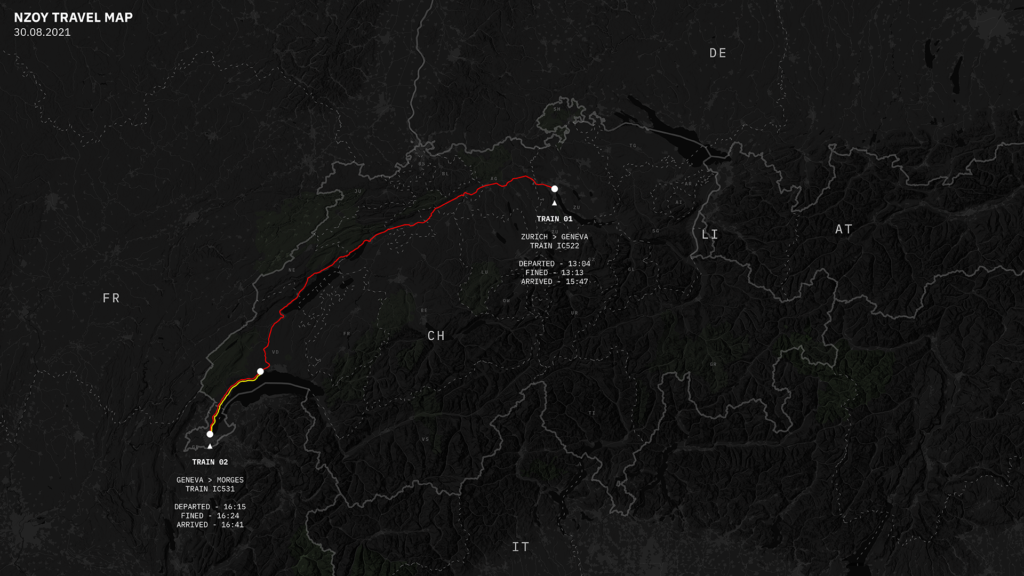
At Morges station, railway workers reported seeing Nzoy praying on a loading platform and crossing train tracks. According to his close friends and family, praying was a way for Nzoy to regain balance in situations of distress. Two railway workers first came into contact with him, talking to him, trying to calm him down, to prevent him from walking on the tracks, asking him “not to act crazy”. One of them called the police at the same time. A first police patrol arrived at the request of a police dispatcher – composed of police officer 1 (PO1) and police officer 2 (PO2) – at 17:58. Then, moments later, a second patrol intervened spontaneously – composed of police officer 3 (PO3) and police officer 4 (PO4). When the second patrol arrived, the four police officers semi-circled him and the situation escalated within seconds.
Since a train had to be held at the station platform due to the unfolding events, several passengers as well as local inhabitants witnessed and filmed the scene. Witnesses’ videos show Nzoy moving away from Patrol 1, stepping from the tracks onto the platform and running in a westward direction, from where Patrol 2 was approaching. Facing him, PO4 shot twice, with one bullet most likely grazing the back of Nzoy’s right hand and another striking him in the left groin. Nzoy fell down and rolled as he hit the ground. He stood up again, resumed running, and was shot by PO4 a third and final time with a bullet most likely striking him on the left flank.1The medical forensic report commissioned by the public prosecutor and conducted by the University Center of Legal Medicine Lausanne-Geneva, noted three wounds but did not clarify the chronology of the shots despite numbering the wounds from 1 to 3. The report states that wound 1 is intra-abdominal, with an entry point on the left flank and a projectile found in the right internal oblique muscle. Wound 2 is located on the left inguinal region and a projectile lodged in the left acetabulum. Wound 3 is on the back of Nzoy’s right hand, suggesting a firearm projectile injury of a tangential nature. Case file, 5004, p. 47 At 17:59, Nzoy collapsed to the ground, and never rose again.
Immediately after the shooting, PO3 informed via radio that shots had been fired. When the dispatcher requested additional information, PO3 responded: “I don’t have more information, a man of colour, he is on the ground.”2“J’ai pas plus d’infos, un homme de couleur, il est au sol” Case file, 1020. During the six minutes that elapsed after the shots, while Nzoy was lying face down on the platform, the police officers handcuffed him behind his back, then put him on his side to search him. They did not enquire into his health nor did they conduct first-aid measures. After six minutes, an off-duty nurse who witnessed the scene intervened spontaneously to provide emergency care, followed by the arrival of emergency services. Nzoy’s death was declared at 18:31, on the platform, in the train station of Morges.
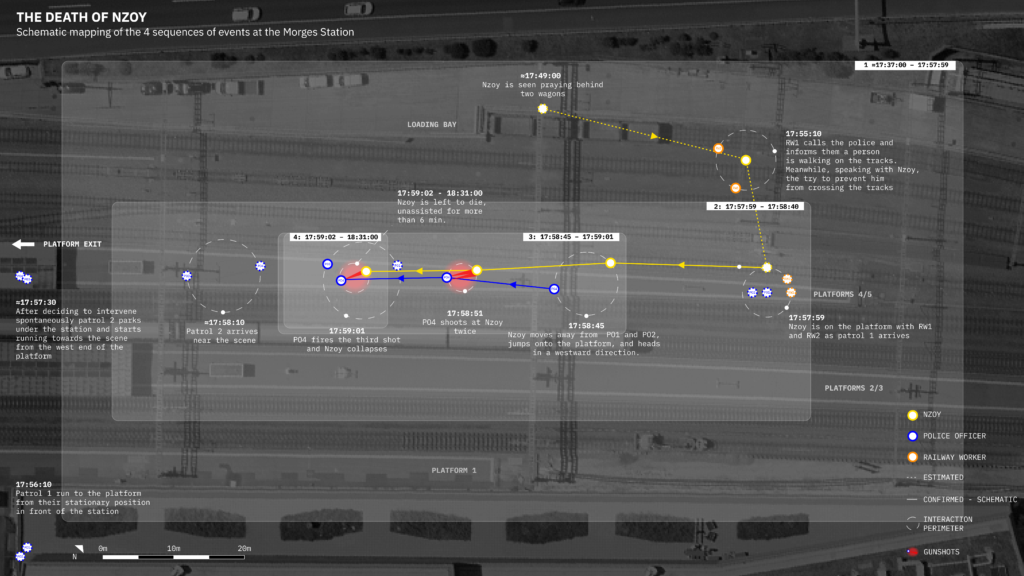
About an hour after the events, local media outlets began publishing videos of the events along with information obtained from witnesses’ testimonies and a press release from the Vaud Cantonal Police.320 Minutes, “La police fait feu à plusieurs reprises, un homme meurt sur le quai,” 20 minutes, August 30, 2021, https://www.20min.ch/fr/story/la-police-fait-feu-sur-un-homme-a-la-gare-de-morges-380390384863. The first press statement disclosed that two police patrols intervened at Morges station to respond to a “disturbed” individual. It further stated that, threatened by the individual armed with a knife, an officer from the Morges Regional Police used his firearm and, despite receiving care from the police officers and then from paramedics, the person died at the scene.4État de Vaud, “Morges : un homme mortellement blessé par la police,” September 1, 2021, https://www.vd.ch/actualites/actualite/news/14888i-morges-un-homme-mortellement-blesse-par-la-police. Two days after the events, another press statement was released. It gave additional information about the knife discovered at the scene, added that the person was already known to the Zurich police and corrected the initial statement by specifying that the first resuscitation effort was made by a nurse present at the scene rather than the police officers.5État de Vaud, “Morges : l’homme mortellement blessé par la police formellement identifié,” September 1, 2021, https://www.vd.ch/actualites/actualite/news/14892i-morges-lhomme-mortellement-blesse-par-la-police-formellement-identifie.
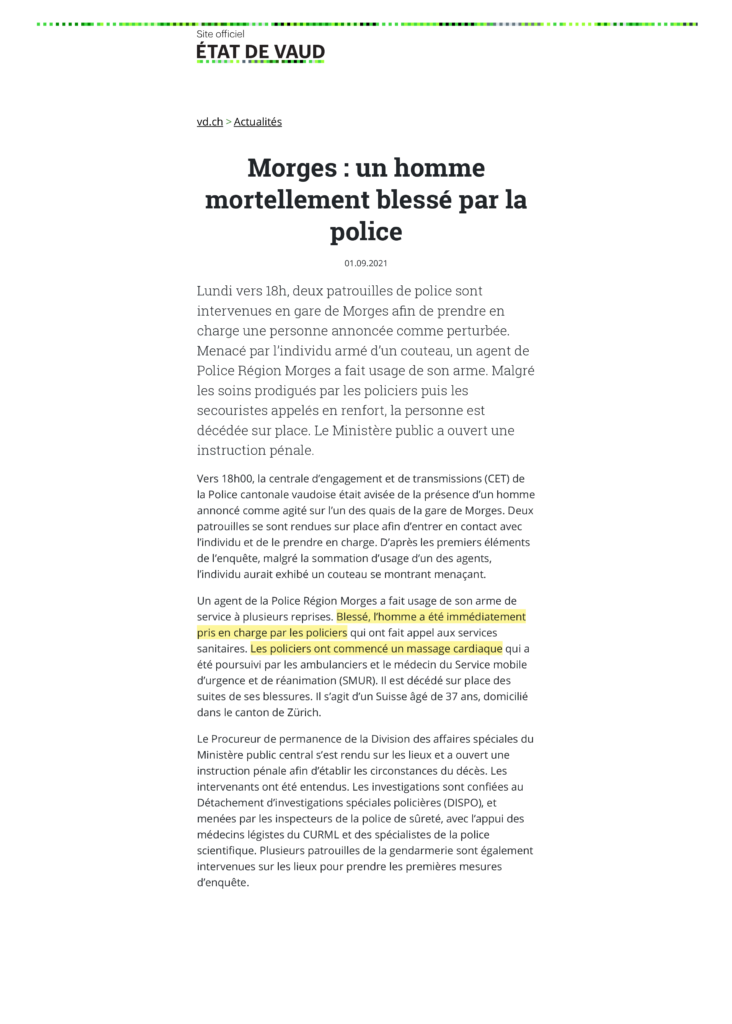
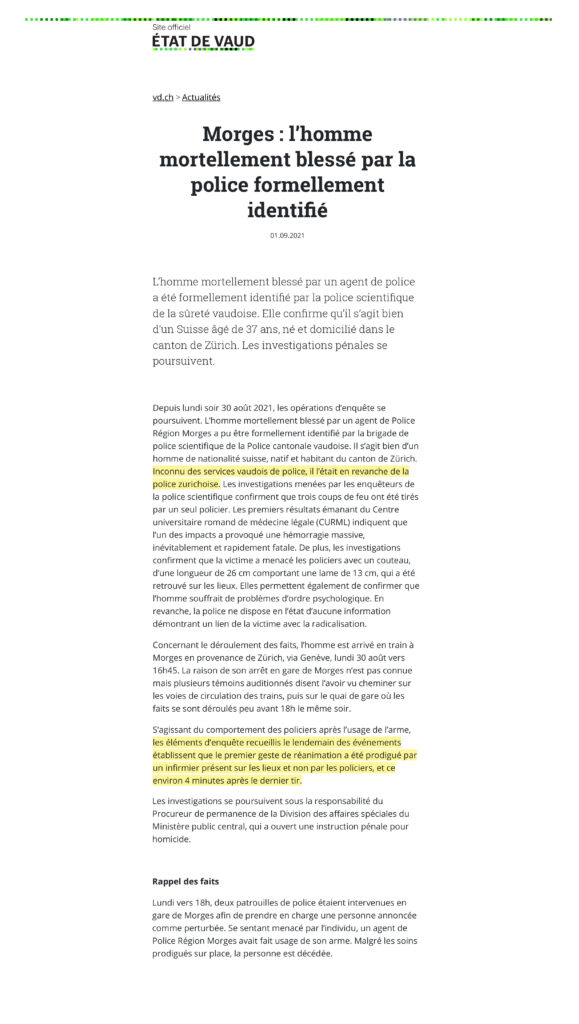
Though the criminal investigation had only just begun, the tone of these press statements was already conclusive. Their description of the events legitimised the fatal shooting carried out by PO4 through the assertion that he was acting in self-defence while threatened with a knife by a mentally unstable person who was known to the police. This narrative was widely spread by the media and supported by the Morges police.6Antoine Hürlimann, “L’homme abattu à Morges se ruait sur les policiers,” Suisse, Blick, September 1, 2021, https://www.blick.ch/fr/suisse/une-video-exclusive-le-montre-lhomme-abattu-par-la-police-a-morges-se-ruait-sur-les-agents-id16796148.html; 20 Minutes, “Coups de feu en gare de Morges (VD) – La version de la police confirme celle des témoins,” 20 minutes, September 1, 2021, https://www.20min.ch/fr/story/homme-tue-par-un-policier-trois-balles-ont-ete-tirees-677743935687; ArcInfo, “Morges: l’homme décédé sur les quais de la gare souffrait de troubles psychologiques,” ArcInfo, September 1, 2021, https://www.arcinfo.ch/suisse/morges-lhomme-decede-sur-les-quais-de-la-gare-souffrait-de-troubles-psychologiques-1105410; Raphaël Cand, “«Aucun policier ne souhaite vivre ça»,” Journal de Morges, September 2, 2021, https://journaldemorges.ch/actualite/aucun-policier-ne-souhaite-vivre-ca Four years after the killing of Nzoy, and after two failed attempts from the public prosecutor to close the criminal investigation and abandon the proceedings, Nzoy’s family and close ones continue to oppose this conclusion and argue that Nzoy would not have been treated in such a violent manner had he been white.
At the request of Nzoy’s family, Border Forensics, in collaboration with the Independent Commission of Inquiry on the Death of Roger Nzoy Wilhelm (hereinafter “Independent Commission”),7The Independent Commission of Inquiry on the Death of Roger Nzoy Wilhelm is a group of experts constituted by Nzoy’s family. It is composed of lawyers, psychologists, physicians, sociologists, political scientists, anthropologists, historians and cultural scientists. They work closely with Nzoy’s family and their lawyer and conduct research and provide expertise on the case to support their demand for truth and justice: https://www.nzoycommission.org/en/wer-wir-sind/ has been conducting a counter-investigation for two years to produce a detailed analysis of the events and answer the following key questions:
- What circumstances and police (in)actions led to Nzoy’s death?
- What are the deficiencies and evidentiary gaps of the criminal investigation?
- To what extent was the killing of Nzoy shaped by racism and processes of othering?
- To what extent are institutions equipped to address demands for truth and justice in cases of police-related death?
Combining Border Forensics’ spatial, visual and geostatistical methods with the interdisciplinary expertise of the Independent Commission, we have reconstructed the complex constellation of factors, extending across different spatial and temporal scales, that culminated in Nzoy’s death. Our counter-investigation reveals fundamental new insights into the events at Morges station, which challenge the findings of and narrative constructed by the criminal investigation. In particular, we demonstrate that Nzoy did not constitute a threat to others and that his shooting was illegitimate. Beyond the case of Nzoy, our report also offers novel insights into police-related deaths in Switzerland – a category we define as including any interaction with law enforcement agents resulting in a civilian’s death. We demonstrate that police-related deaths disproportionately impact people – mostly men – subjected to processes of othering, in particular racialisation. Finally, our analysis indicates that a regime of impunity for police-related deaths has consolidated. As a result, truth and justice are denied to victims and their families and the perpetuation of violent police practices is enabled.
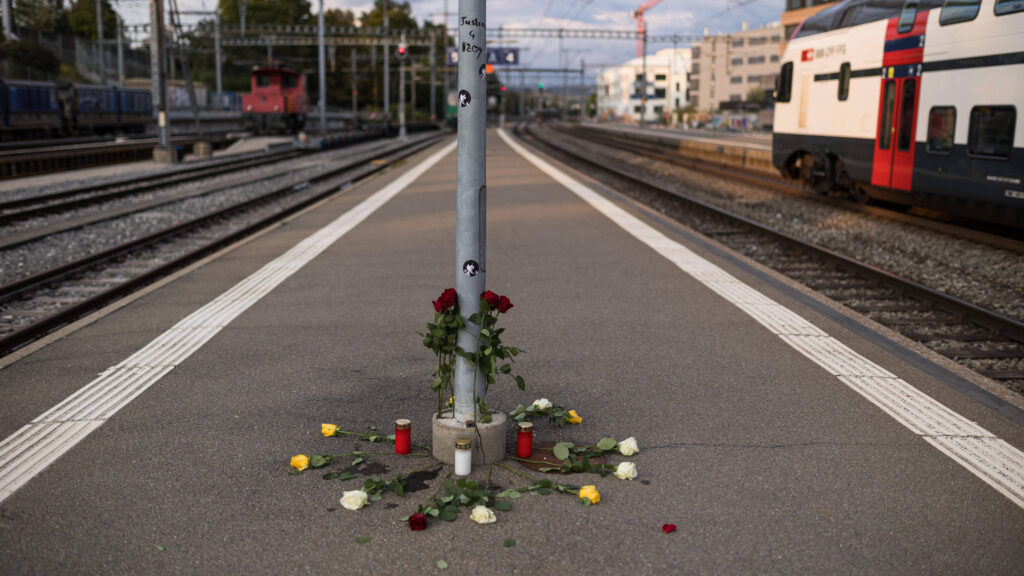
Report outline
To answer our four key questions outlined above, the report is organised into four main chapters, structured by two analytical levels.
The first level focuses on the event of Nzoy’s killing and examines: (1) the evidence concerning the (in)actions of the actors on site that led to Nzoy’s death; and (2) the deficiencies and evidentiary gaps in the criminal investigation.
The second analytical level locates the case of Nzoy’s killing in relation to similar incidents, and analyses the structural conditions that have enabled them. In particular, we focus on: (3) the longer history and broader structures of racism and police-related deaths in Switzerland; and (4) the legal, political and media frameworks that undermine demands for truth and justice and allow for violence to be perpetuated.
Chapter 1 provides a detailed analysis of the circumstances and the (in)actions of all actors who interacted with Nzoy at the Morges train station on 30 August 2021, ultimately causing Nzoy’s death. By cross-referencing evidence contained in the case file to which Nzoy’s family gave us access, in particular videos filmed by witnesses, police radio recordings and transcripts of police hearings, we establish a precise reconstruction of the sequence of events in space and time.
Our reconstruction concentrates on the time frame between 16:41 and 18:31, which we divide into four successive sequences, each of which corresponds to a critical stage in the unfolding of events.
The first sequence focuses on the situation at Morges station before the arrival of the first and second police patrols. Our combined analysis of video and audio recordings of Nzoy’s interactions with two railway workers, transcripts of police hearings as well as psychiatric research reveals that Nzoy exhibited behaviour indicative of a psychiatric disorder with signs of confusion and distress. During this sequence, for which evidence is fragmentary, it appears that both Nzoy and the railway workers were actively looking for resources to manage the unstable situation. There is no indication of escalation.
The second sequence focuses on the arrival of the dispatched first patrol and the spontaneous intervention of the second patrol. Based on video and audio data as well as transcripts of police hearings, our analysis indicates that the arrival of police had a triggering effect on Nzoy linked to his ongoing psychological distress and previous experiences of racial profiling. This combination of factors heightened stress for Nzoy, causing his behaviour to shift from confusion and withdrawal to panic.
The third sequence focuses on the moments immediately leading up to the shooting of Nzoy by the police, and the shooting itself. We reconstruct Nzoy’s trajectory in relation to the officers and assess the alleged presence of a knife in his hands. Our analysis provides crucial new evidence that leads us to refute the criminal investigation’s findings and its narrative according to which Nzoy aimed to attack PO4 with a knife, which in turn has legitimised the officer’s lethal response. Our analysis of this defining sequence unfolds in several steps.
First, by precisely plotting the footsteps of Nzoy and PO4 onto a detailed 2D plan of the platform, we demonstrate that Nzoy’s trajectory of motion was lateral and that PO4 stepped into Nzoy’s projected path, contradicting the narrative that Nzoy was charging or attempting to attack PO4.
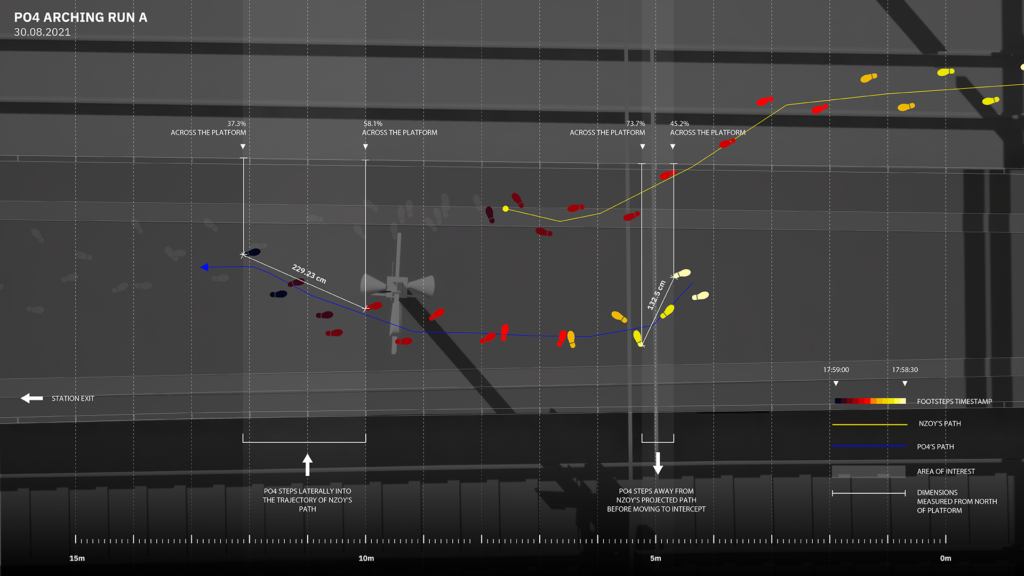
Second, this analysis is supported through the reconstruction of key moments in a virtual 3D environment. Based on video evidence, we were able to precisely recreate the positions of Nzoy and PO4, demonstrating that Nzoy’s path was consistent with defence, confusion and flight rather than aggression and attack.
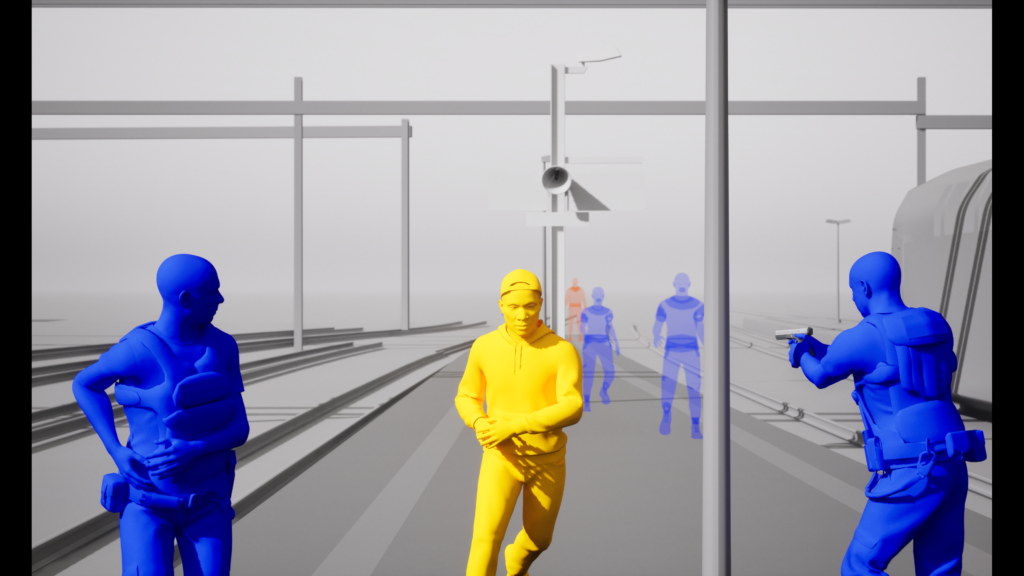
Third and finally, we conducted a spatial analysis of Nzoy’s hands in the moments immediately prior to the first shots fired by PO4. Using a sequence of video evidence recorded from an apartment overlooking the station where both of Nzoy’s hands are clearly visible, a video-pixel analysis allowed us to estimate the real-world size of Nzoy’s hands in the image as well as their shape and motion. Through this analysis, we demonstrate that Nzoy’s hands were open just before the first shots were fired at him. It was thus highly unlikely that he was holding a knife at that moment.
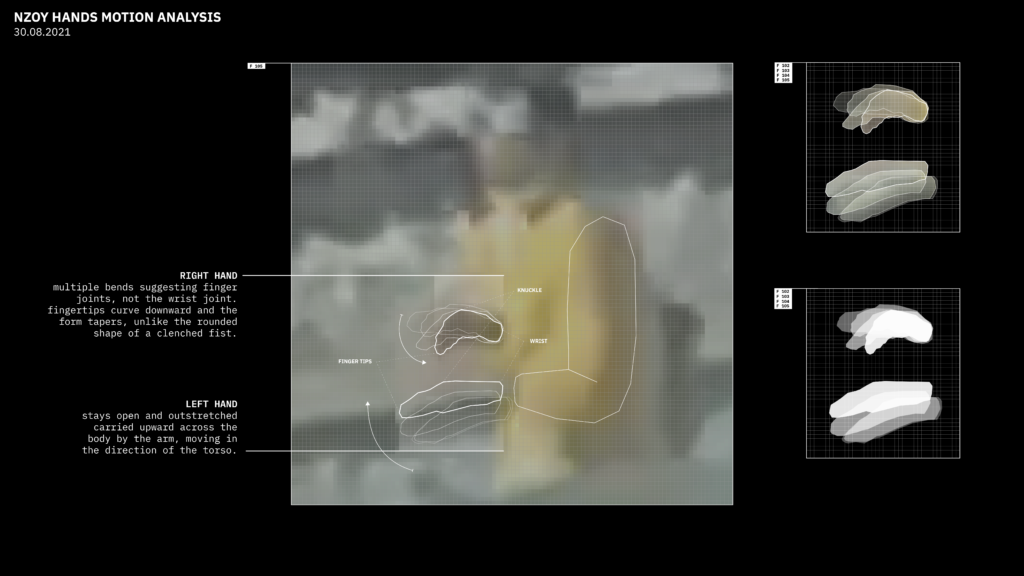
The fourth and last sequence we analyse focuses on the police officers’ actions after the last shot, following which Nzoy collapsed on the ground. Through a combined analysis of video and audio evidence, police officers’ statements, police training manuals and a medical assessment, we demonstrate that after the shots, while Nzoy was clearly injured and in need of care, the officers did not share any relevant information about the situation and prioritised security handlings, such as a safety search and handcuffing Nzoy’s hands behind his back instead of offering first aid, which the officers were trained and required to provide. Our analysis further demonstrates that it is only after six minutes that a nurse, who was a witness to the scene, intervened spontaneously and was allowed to provide first aid.
Together, these combined steps in our analysis of the events lead us to fundamentally challenge the prevailing narrative according to which Nzoy constituted a threat to the officers that justified the use of lethal force. Our analysis further shows that Nzoy was not assisted in a life-threatening situation by the police officers, thus demonstrating a remarkable disregard for his life. Both the unfounded perception of Nzoy as a threat and the disregard for his life raise the question of how the perception of Nzoy as a “man of colour” – and thus the role of race – played in shaping the (in)actions of police officers, a question we respond to in Chapter 3.
Chapter 2 continues our analysis at the level of the event, through the examination of the criminal investigation jointly led by the public prosecutor’s office of the Canton of Vaud and the Vaud Cantonal Police on the case. Our analysis of the case file reveals multiple deficiencies and evidentiary gaps of the criminal investigation, crystallising around the collection, processing and analysis of data. By cross-referencing video and audio data and analysing their metadata, we demonstrate that means of proof were altered, erasing their metadata and thereby critically hindering their use. We further uncover that radio communications are missing from the case file, leaving significant gaps in understanding the actions of the police officers and their potential consequences.
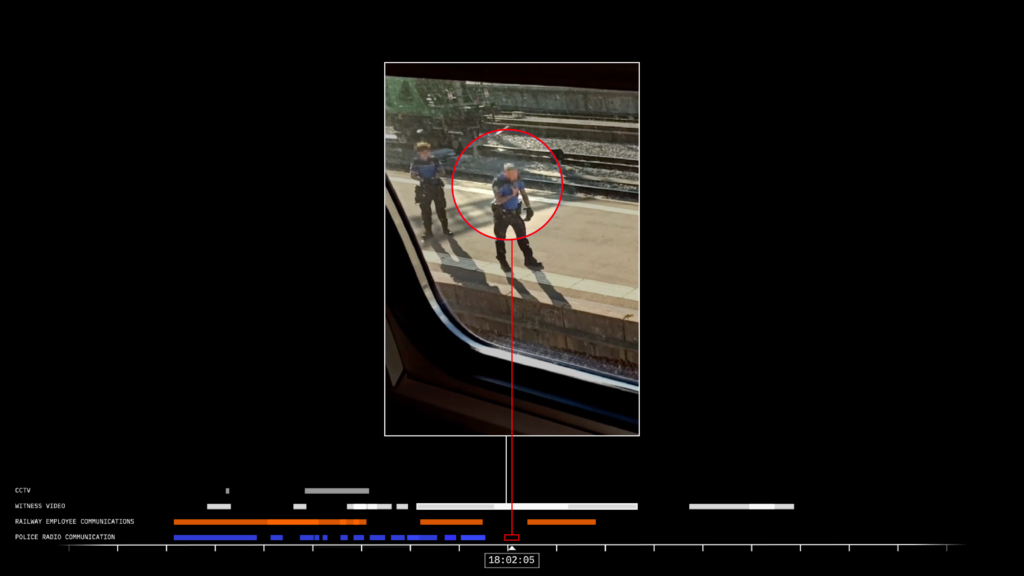
We finally cross-examine a police hearing transcript of one of the railway workers present at the station on that day (RW2) with videos and audio recordings of the events and reveal that his statements contain major inconsistencies that were not detected in the criminal investigation.
While Nzoy’s family and their lawyer, with the help of Border Forensics and the Independent Commission, repeatedly drew attention to these issues in the legal proceedings, the public prosecutor and the cantonal police systematically failed – or refused – to address them, constructing clear barriers to accountability. This not only hinders the quest for truth and justice in Nzoy’s case but also raises questions about the police and the public prosecutor’s will and capacity to effectively and transparently investigate a case of police-related death which we address in Chapter 4.
In Chapter 3, we seek to address the role of race in the killing of Nzoy. Towards this aim, and drawing on historical, institutional and statistical analyses, we analyse the structural conditions shaping police-related deaths in Switzerland. We first explore research conducted on the structuring role of race in Switzerland and the country’s occluded colonial history. We further analyse the way structural racism and denial operate in the practices of the Swiss police today. We then demonstrate that people – mostly men – perceived as others as a result of their racialisation, socio-legal status, psychopathology and drug use are disproportionately exposed to lethal police practices in Switzerland. To support this, and in response to the structural opacity of police institutions and the systematic lack of publicly available data on their activities, we have created a database of 83 cases of documented police-related deaths in Switzerland between 1992 and 2025 and compiled them into a cartographic platform – the Archive of Absence. This platform not only functions as a digital memorial for people who lost their lives at the hands of the police but also makes the othering processes people were subjected to legible.
An Archive of Absence: Dying at the hands of police in Switzerland. Interactive mapping platform to remember the deceased, acknowledge their absence and unveil the killings and their structure. Border Forensics, 2025The Archive of Absence
Headline figures from the Archive of Absence are unequivocal: at least 79% of documented police-related deaths were men. 67% of documented victims involve at least one axis of othering, and nearly a third (28%) involve more than one. More than 45% of the cases involved explicit or implicit racialisation processes; 30% concerned people with precarious socio-legal status; and almost 20% involved othering through psychopathology or drug-use. Together, these figures show that police lethality in Switzerland is not randomly distributed but structured by hierarchies of difference and disproportionately targets othered individuals.
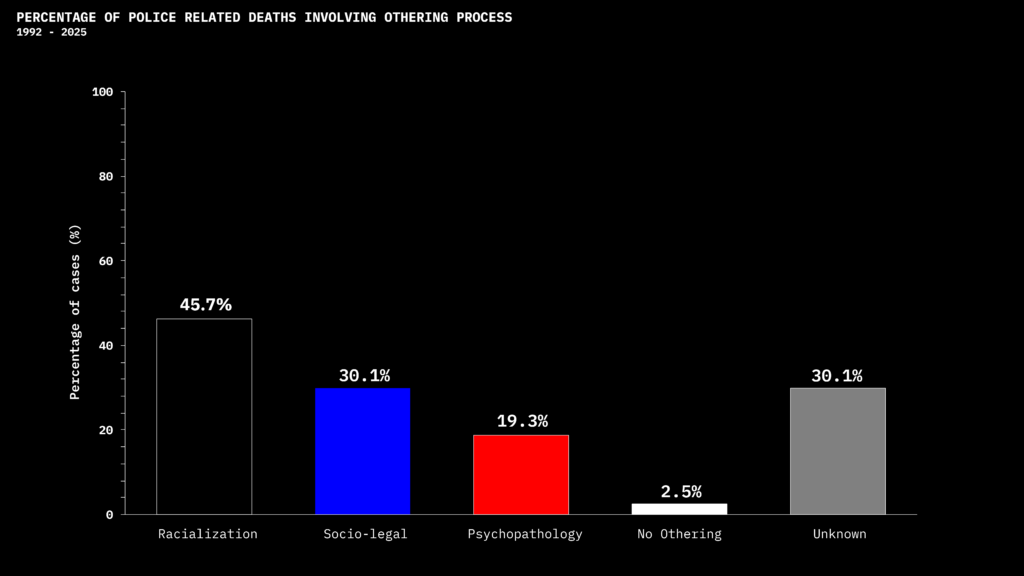
On the day of his killing, Nzoy was described as a “man” and othered through his racialisation as a person “of colour” and perceived psychopathology. These intersectional and overlapping othering processes are identified by our analysis as particularly lethal in the Swiss context. Thus the combined othering that targeted Nzoy – compounded by masculinity – increased the risk of his exposure to lethal policing.
Our analysis also reveals that Nzoy’s geographical location in the Canton of Vaud on 30 August 2021 heightened this risk. According to our database, over the last decade, the highest number of documented police-related deaths in Switzerland occurred in the Canton of Vaud, with an over-representation of victims othered through racialisation. Brought together, the recent cases of police-related deaths in the Canton of Vaud express the tragic human toll of this pattern of police lethality: Hervé Bondembe Mandundu (Bex, 2016), Lamin Fatty (Lausanne, 2017), Mike Ben Peter (Lausanne, 2018), Nzoy (Morges, 2021), Qader B. (Essert-sous-Champvent, 2024), Michael Kenechukwu Ekemezie (Lausanne, 2025) and Camila Oliveira Belchior (Lausanne, 2025).
Combining our historical and statistical analyses of structural conditions shaping police-related deaths in this chapter with the findings of our previous chapters concerning the circumstances of Nzoy’s death and the processes of othering and the differential treatment he was subjected to, allows us to return to the question of the role of race in the unfolding of events. We conclude that it is highly probable that Nzoy’s killing was influenced by how he was perceived as a “man of colour” and a person affected by psychological disorder.
Chapter 4 addresses the structural conditions leading to the denial of truth and justice for victims of police-related violence and their families, with a specific focus on the Canton of Vaud. We analyse the structural entanglement between the police and the public prosecutor’s office in the conduct of criminal investigation in the Canton of Vaud, with a specific focus on the Special Police Investigations Unit (DISPO). Our analysis highlights the lack of independence in the conduct of criminal investigation, which has contributed to a lack of accountability in recent cases of police-related deaths. To date, all documented cases over the last ten years remain under prolonged criminal investigations, or are pending in Swiss or international courts after families have challenged verdicts ruled against them. As a result of these repeated barriers to accountability, justice appears elusive and forever deferred for victims’ families.
We further analyse the barriers to justice experienced by families and the perpetuation of violence through the legal process, with a specific focus on Nzoy’s case. We discuss particular barriers to accountability and the violence that families experience through the negative portrayal of their loved ones in the legal process, which is further amplified by the media. These portrayals shift the focus away from the police-related death to the alleged faults or threats of victims. Such portrayals both legitimise the actions of police officers and further stigmatise the families, who are forced to watch their loved ones represented in legal proceedings in ways that are unrecognisable to them. In these instances, it is the memory of a loved one that is violated, after the person themself has already been killed.
Together, our analysis demonstrates that the legal institutions of the Canton of Vaud charged with determining responsibilities in cases of police-related violence are far from offering an adequate response to the demands for accountability. The legal process comes at a tremendous cost for the families, while the officers implicated in police-related deaths are very rarely condemned for their (in)actions. Furthermore, racism itself is not addressed in these legal processes and remains unchallenged. Structural impunity thus operates across a continuum which in turn enables the perpetuation of police violence onto future victims. The acknowledgement of the limits of the law and the violence of the legal process itself has spurred anti-racist movements to consider alternative justice-seeking practices both within and without the institutions of the law.

The Conclusion brings together the two analytical levels of this report and reflects on the meaning of “Justice for Nzoy” – the demand that has been voiced by his family and which resonates throughout demonstrations. It is understood at once as a call to uncover and disseminate the truth about his death, to pursue accountability through legal forums despite their systemic limitations,to rethink justice beyond punitive state institutions and to restore Nzoy’s memory. We specifically address the ways in which this counter-investigation has answered this call. Grounded in the Nzoy case but against a backdrop of other police-related deaths in Switzerland, our results are summarised. At the same time, they highlight how Nzoy’s family, together with activists and collectives, has forged alternative practices of justice rooted in solidarity, truth-telling and collective memory, sustaining both resistance and care while envisioning systemic change.
In summary, our counter-investigation reveals the killing of Nzoy in a fundamentally new different light. We demonstrate that:
- Nzoy was not attacking PO4 and that it is highly likely that he did not have a knife in his hands before the first two shots were fired. Based on an inaccurate and biased perception of threat, the police officers wrongfully privileged the use of coercitive means and lethal force against Nzoy instead of assistance and care. This led to the escalation of the situation resulting in the fatal shooting of a person in a state of psychological distress.
- The police officers did not provide aid to Nzoy, who was in urgent need of assistance after being shot, and prioritised security measures despite the absence of threat. An off-duty nurse witnessing the events presented himself on the scene four minutes and 40 seconds after the last shot and conducted first-aid measures six minutes after the last shot, followed by the intervention of emergency services.
- The perception of Nzoy as a “man of colour” likely shaped the events that led to his death. The specific circumstances of his death indeed correspond to a clear pattern of relation between processes of othering and overexposure to the risk of police-related death which emerges from our statistical analysis.
- The cantonal police and the public prosecutor failed to conduct a detailed, fact-based and impartial investigation on this case. The criminal investigation contains several inaccuracies, and crucial means of proof have been altered or are missing from the case file. Analysing the legal and procedural functioning of this and other similar investigations, our report interrogates the capacity and willingness of state institutions to conduct an independent and impartial process that guarantees accountability.
- The violence experienced by Nzoy, and by extension his family and close ones, did not end with the fatal shooting but continued throughout the legal proceedings, and was particularly intensified by the victim–perpetrator reversal propagated in the public sphere by the police, the public prosecutor and some media outlets.
It is our hope that this counter-investigation may support Nzoy’s family’s quest for truth and justice. While this investigation primarily focuses on reconstructing the specific circumstances and conditions that led to the killing of Nzoy, we do not wish to reduce him to his death. We thus conclude this summary with the words of Nzoy’s sister, which bring to life the memory of who he was:
“I want the world to remember him as he was – a cheerful, funny, helpful being, a human. I really want his laughter and his helpfulness to be remembered, his humanity, his compassion, his empathy for people, his love for people. That is what I would like to keep in memory of him. And of course his laugh, and his hugs, and his dimples, and his curls… There’s actually so much; a whole list of things one can remember about him.” – Nzoy’s sister
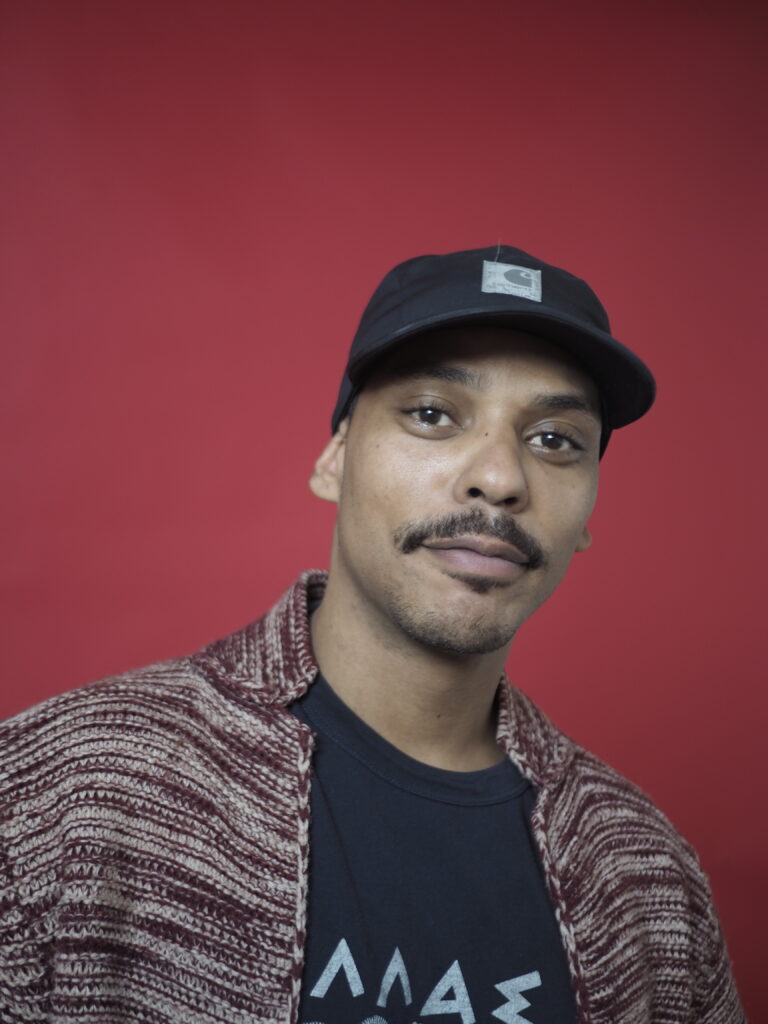
Investigation methodology
While we define our specific methods, techniques and tools in each chapter, in this section we outline our overall investigation methodology – the framework in which our research is conducted with particular attention to our counter-forensics practice in relation to racist violence and the ethical considerations that guide our work.
A collaborative counter-forensics practice
Border Forensics is a research and investigation agency founded in 2021 and based in Geneva. Border Forensics’ work is anchored in a counter-forensics practice that critically mobilises methods of spatial and visual analysis to investigate violence, in particular related to the existence and management of borders. Border Forensics strives to combine in a mutually reinforcing way cutting-edge and rigorous methodologies towards evidence-based analysis, critical and reflexive thinking and creative aesthetic practice. While we often harness data and methods used by states towards surveillance, we mobilise them critically in the aim of revealing the practices and actors responsible for violence and human rights violations while not exposing the dignity of those whose lives have been violated.
Our previous investigations to date have focused on the continuum of border violence that affects the entire trajectories of migrants from the global south. We have paid particular attention to the ways in which the policing of borders and of the boundaries of race intersect, showing that racial categorisation crucially influences who border agents target and the use of excessive violence against them. With this investigation, we focus on the policing of the boundary of race as such. The boundaries of race, just like state borders, result in the assignation of people to their differences, hierarchisations in human dignity and rights, and ultimately differential treatment and exposure to violence.
Throughout our investigations, we work in direct collaboration with affected communities, non-governmental organisations as well as other civil society groups to support their demands for truth and justice. For this investigation, we have collaborated with Nzoy’s family and with the Independent Commission. Formed in 2023 on the models of international commissions that independently examine police behaviour and investigate cases of police-related deaths, it is composed of lawyers, psychologists, physicians, sociologists, political scientists, anthropologists, historians and cultural scientists who have worked closely with Nzoy’s family and their lawyer. Border Forensics and the Independent Commission’s analyses are combined to construct an empirical and fact-based investigation.
The challenges of critically investigating racist violence
As Eyal Weizman, one of the founders of the critical forensic practice our methodology engages with, describes in a co-authored text, a key characteristics of critical forensic practice is that it strives to address both minimal causation, “the minimal act, or inaction, that causes a crime to occur”, and field causality: “The complex multiple causes, which may be social, cultural, economic, environmental, and so on, that bear on a particular event.”8Matthew Fuller and Eyal Weizman, Investigative Aesthetics: Conflicts and Commons in the Politics of Truth (Verso Books, 2021), 137–38. This methodological orientation is all the more important when focusing on forms of violence involving racial categorisation, and specifically anti-Black violence.
Scholars of Black studies emphasise that “Black death is not an event, but a continuum that intimately informs Black existence”.9Norman Ajari, “Forms of Death: Necropolitics, Mourning, and Black Dignity,” Symposium: Canadian Journal of Continental Philosophy 26, no. 1/2 (2022): 175, https://doi.org/10.5840/symposium2022261/29. Although cases of violence targeting Black people can be spectacularly revealed during specific events – such as the killing of Nzoy – the violence that permeates the daily lives of Black people is often far less sensational and documented. Yet this everyday violence – often invisible and unrecognised – is essential to take into account. If, as the philosopher Norman Ajari notes, “the way in which a Black person dies in a racist world is in continuity with the way in which he is bound to live in it”,10Norman Ajari, La Dignité Ou La Mort: Éthique et Politique de La Race, Les Empêcheurs de Penser En Rond (La Découverte, 2019), 100. then when investigating incidents that target Black people, the frame of analysis must be extended beyond the space-time of the event of their killing, so that the structural conditions that have enabled many similar violent events to occur can be addressed. These considerations, in which critical forensic practice and Black studies methodologically converge, have been key in shaping the two analytical levels that we have used to structure our inquiry – the event and the structural conditions. While in Chapters 1 and 2 we have primarily mobilised spatial and visual investigative methods to reconstruct meticulously the unfolding of events on the day of the killing of Nzoy, in Chapters 3 and 4 we extend our investigation beyond “the cordoned-off area of the crime scene”11Fuller and Weizman, Investigative Aesthetics: Conflicts and Commons in the Politics of Truth, 137. and use historical, legal and statistical analysis to account for the broader structural context of racism and impunity that made his killing possible.
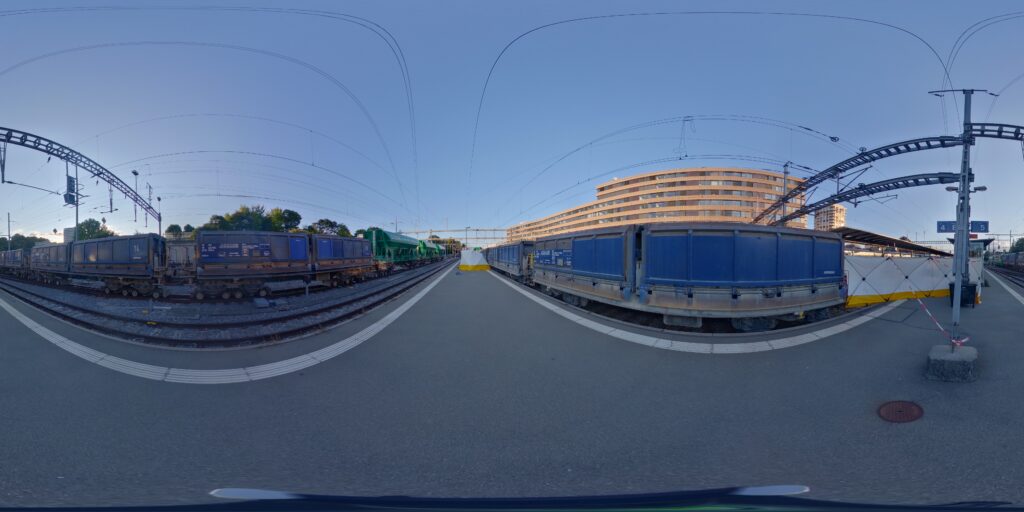
The analysis of racist violence also raises other ethical and political challenges relating to the use of the images and other evidence documenting the violence. While reconstructing events and making visible violent practices are crucial for contesting them and seeking truth and justice, it is also necessary to consider how these documentation strategies might inadvertently reproduce dehumanisation and harm for those affected. We believe two issues in particular demand critical reflection and experimentation. First, Black studies and feminist scholars have shown that the hoped-for and assumed effects of disseminating images of violence – that their visibility would lead to at least public, if not legal, condemnation, and ultimately to the cessation of the violence – are often not realised when the targets of the violence are Black people. On the contrary, the dissemination of images of violence against Black people contributes to its normalisation and thus to its perpetuation.12Christina Sharpe, In the Wake: On Blackness and Being (Duke University Press, 2016), 116–17. Second, this important history of research and political engagement on racism and policing has indeed critically addressed the ethics and politics of representation of violence against Black bodies. As put forward by author and activist William C. Anderson: “Dead Black people are not ornaments to be put up and taken down for every activist need, purpose and point. […] We run the risk of reducing them to just a death and erasing the beautiful existence many of them had prior to the deadly moments that introduced them to us all.”13William C. Anderson, “From Lynching Photos to Michael Brown’s Body: Commodifying Black Death,” Truthout, January 16, 2015, https://truthout.org/articles/from-lynching-photos-to-michael-brown-s-body-commodifying-black-death/.
In investigating and documenting Nzoy’s death, we face an ethical imperative: to make the violence he suffered visible and intelligible without reproducing its conditions of dehumanisation and normalisation. To do so, we seek to exercise the “disobedient gaze” that Border Forensics has developed in the course of its investigations, through which we attempt to make visible the violence and the responsibility of states, while protecting the identity and dignity of those whose lives and rights have been violated.14Charles Heller and Lorenzo Pezzani, “A disobedient gaze: strategic interventions in the knowledge(s) of maritime borders.” Postcolonial Studies 16(3), 2013, pp. 289-98. We further follow Black feminist scholars and activists in the aim of adopting an approach that prioritises relationality, care and the dignity of the victim, casting a non-voyeuristic and an anti-racist gaze upon them, while consciously rejecting the extractive and spectacularising tendencies of forensic or carceral forms of knowledge production. We further embrace what Édouard Glissant calls the “right to opacity”,15Édouard Glissant, Poétique de la relation (Gallimard, 2012), 203–10. which asserts that individuals – particularly those who have been historically objectified by the colonial gaze – are not required to make themselves fully visible, legible or understandable to those in power. Opacity is not about obscuring the truth; it is about safeguarding the personhood and dignity of the victim, recognising the entirety of a person’s life beyond the moment of their violation, and not reducing them to their death.
We use this ethical approach as a compass to prioritise re-humanisation rather than brutalisation and criminalisation. Remaining in constant dialogue with Nzoy’s family and close ones, we have discussed what can and should be presented in the investigation and how. Their perspectives have shaped both the form and the content of this work. When discussing the video images of Nzoy’s killing with Nzoy’s sister, she told us: “I don’t want to see him dying over and over again.” She further expressed the desire to protect Nzoy’s dignity, in particular not to publicly show video sequences depicting Nzoy being shot or lying on the ground. To respond to her demands without losing the evidentiary value of this video material, we have drawn inspiration from the strategies of Black studies scholars and Black artists who have mobilised “redaction” as a critical practice.16Sharpe, In the Wake. While redaction is often used by states to shield state actors from public scrutiny, redaction can also be mobilised by non-state actors to protect the identities and dignity of subaltern subjects. Here, in Nzoy’s sister’s proposition, redaction operates as a visual cover, which protects and gives privacy to her deceased brother.17All videos we mobilise in our reconstruction are included in the case file and are thus available unredacted to all actors involved in the legal proceedings. As well as a refusal of the state’s reduction of Nzoy’s life to a case file, this is a visual gesture of care and an affirmation of his humanity, his personhood and his enduring presence in the lives of those who loved him.
CHAPTER 1. FROM DISTRESS TO DEATH: RECONSTRUCTING THE KILLING OF NZOY
Nzoy died on 30 August 2021 at Morges train station after being shot three times by a Morges police officer (PO4) and left unassisted for six minutes. Four years after the event, and after two failed attempts from the public prosecutor to abandon the proceedings, the criminal investigation has not yet shed light on the circumstances that led to Nzoy’s death. Until now, the criminal investigation has constructed a simple and seemingly straightforward depiction of events based on incomplete or false accounts, leading to erroneous conclusions that ultimately criminalise Nzoy and legitimise his killing.
By cross-referencing all the evidence of the case file and new evidence we generated in the course of our investigation, our analysis provides a detailed understanding of the unfolding of events, summarised in a cartographic and videographic reconstruction. At the request of Nzoy’s family, and for reasons described in our methodology, in the aim of protecting Nzoy’s dignity we have redacted all video sequences showing Nzoy being shot or dying on the ground.
Throughout this report we demonstrate that the actions of the police officers, and their inaccurate perception of Nzoy as a threat, rapidly led to the use of coercitive means and the subsequent prioritisation of security measures instead of assistance and first aid, clearly neglecting Nzoy’s health and wellbeing. In this chapter, we analyse the circumstances and (in)actions of the four police officers involved (PO1, PO2, PO3, PO4) that led to Nzoy’s death on 30 August 2021, while presenting in detail the sources we used and the methods we developed.
Before offering our evidence-based reconstruction of events, we discuss the conclusions of the criminal investigation that gives an account of the events that our reconstruction and analysis contradict.
The criminal investigation and the construction of an erroneous narrative
In the direct aftermath of the shooting of Nzoy, we understand from the record of operations contained in the case file that the forensic police is mobilised on the scene. While the exact chronology of the actions is unclear, a bigger dispositif seems to be put together later on, coordinated by an on-duty prosecutor, with medical forensic doctors conducting an analysis of Nzoy’s body and later an autopsy, as well as cantonal police inspectors gathering means of proof and conducting police hearings with the four police officers involved as well as witnesses.
At around 18:25, the case file indicates that the following information is shared with the on-duty prosecutor:
“On this day, at around 17:55, the Operations Center was notified of gunshots fired by the police at Morges railway station. In substance, the first elements indicate that [Morges Regional Police] officers were dispatched for a disturbed individual at Morges station. Upon arrival, the aforementioned man, armed with a knife, moved towards them in a threatening manner. Three gunshots were then fired by the police. The individual is currently believed to be injured, placed in the recovery position, and handcuffed. The crime scene has been secured; the [Forensic Police Brigade] is on site.18“Ce jour, vers 17h55, la Centrale d’engagement a été avertie de coups de feu tirés par la police en gare de Morges. En substance, il ressort des premiers éléments que des agents de la PRM ont été engagés pour un individu perturbé en gare de Morges. Lorsque les policiers sont arrivés sur place, l’homme précité, muni d’un couteau, s’est dirigé vers eux de manière menaçante. Trois coups de feu ont alors été tirés par la police. Actuellement, l’individu serait blessé, placé en position latérale de sécurité et menotté. La scène de crime a été figée ; la BPS se trouve sur les lieux.” Case file, 3015, p.2
While this depiction of events was put forward before Nzoy’s death was pronounced, it continues to be used as a dominant narrative in the criminal investigation four years after he died. A criminal investigation for homicide was opened the next day against PO4 by a public prosecutor of the Canton of Vaud attached to the Special Police Investigations Unit (DISPO).19In Switzerland, cantonal public prosecutors oversee criminal investigations and prosecutions under the Swiss Code of Criminal Procedure and Cantonal laws. They conduct preliminary proceedings, collect evidence, coordinate and instruct police investigations and, if necessary, represent the prosecution in cantonal and federal courts. The role of the prosecutor in a criminal investigation is thus prominent and its tasks and power are vast. In 2020, the Public Prosecutor’s Office of the Canton of Vaud and the Vaud Cantonal Police established the Special Police Investigations Unit (DISPO). Defined as a unit tasked with handling criminal investigations related to police activities and penitentiary matters, it is composed of public prosecutors and police officers from the Vaud cantonal police. As for other cases of violence and deaths involving police officers on duty in the Canton of Vaud, the DISPO is in charge of the criminal investigation into the death of Nzoy. We further discuss issues related to the DISPO and the structural conditions in which it participates in Chapter 3. The public prosecutor also issued a formal investigation mandate assigned to a cantonal police inspector attached to the DISPO.
On 6 September 2021, based on transcripts of police hearings, imagery, videos, radio communication recordings and the preliminary medical forensic report, the cantonal police inspectors submitted their conclusions to the criminal investigation. Their conclusions, which we discuss and oppose in this chapter, state that on 30 August 2021, Nzoy – having shown signs of psychological distress for several months – was seen “highly agitated” and crossing train tracks at Morges station. The conclusions further state that when two police patrols arrived, alerted by a railway worker, they faced an individual “armed with a knife”. Ignoring police officers’ orders to drop the knife, Nzoy allegedly ran towards PO4 “holding his knife in front of him”, and was shot twice. He fell, then rose and “resumed his attack intensely against him”, prompting a third and last shot. Police investigators further state that medical assistance was called and that PO1, PO2 and PO3 first stabilised the situation by securing the scene then handcuffed Nzoy, removed the knife found under him and “placed him in a lateral safety position”, after which a nurse arrived to “assist them to administer first aid”. The conclusions finally emphasise the rapid progression of events and the fact that Nzoy was “very determined to attack the police officer” during “his knife attack”.20Case file, 4001, p.48–49.
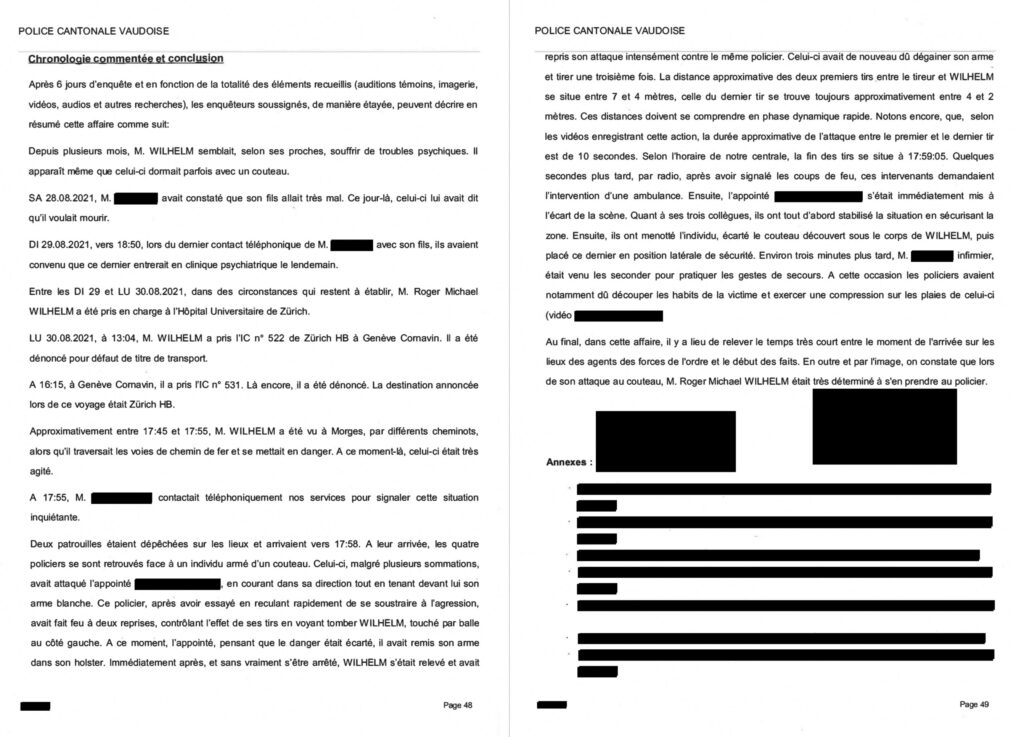
The conclusions of the police investigation reproduce the initial narrative constructed in the direct aftermath of the shooting, and was sealed seven months later by an analysis conducted by a cantonal police officer of the police training unit,21Case file, 4014 whose impartiality and independence have been later contested.22Arrêt Du 14 Mai 2025, PE21.015154-LML (2025). https://www.findinfo-tc.vd.ch/justice/findinfo-pub/internet/search/result.jsp?path=10348518&title=D%C3%A9cision%20/%202025%20/%20254&dossier.id=10277078&lines=10.
While this police investigation was ongoing, local media published eyewitness videos of the events showing that police officers actually did not conduct first aid, which started to raise questions about their possible failure to offer aid. Activist groups also rapidly organised to denounce Nzoy’s killing, problematise its racist character and call for truth and justice on a highly opaque unfolding of events.23Pauline Rumpf, “Il est resté couché bien cinq minutes, menotté, avant d’être secouru,” 20 minutes, August 31, 2021, https://www.20min.ch/fr/story/il-est-reste-couche-bien-cinq-minutes-menotte-avant-detre-secouru-336314064179; Renversé.co, “Morges : Rassemblement Contre Les Crimes Policiers,” September 2, 2021, https://renverse.co/infos-locales/article/morges-rassemblement-contre-les-crimes-policiers-3204.
After two years punctuated by legal actions from Nzoy’s family demanding to extend the case to PO1, PO2 and PO3 for failure to provide aid in an emergency, by requests for independent expertise and by legal disputes concerning police officers’ access to transcripts of hearings, the public prosecutor considered the criminal investigation complete. He announced his will to issue an abandonment of the proceedings for homicide against PO4 and a no-proceedings order for failure to offer aid in an emergency for PO1, PO2, PO3 and PO4.24RTS, “Le procureur veut classer l’enquête contre le policier qui a tué Nzoy,” November 10, 2023, https://www.rts.ch/info/regions/vaud/14459300-le-procureur-veut-classer-lenquete-contre-le-policier-qui-a-tue-nzoy.html.
In response, Border Forensics produced a preliminary analysis in collaboration with the Independent Commission in November 2023 preventing the abandonment and the no-proceedings order. Our analysis demonstrated that the police officers indeed failed to offer aid to Nzoy after the shooting, prioritising security measures instead, even though he did not pose any threat. We further revealed that police radio communications are missing from the case file.25Border Forensics, “Joint Statement and Release of a Preliminary Analysis on the Death of Roger ‘Nzoy’ Wilhelm,” November 10, 2023, https://www.borderforensics.org/news/20231110-pr-roger-nzoy-wilhelm/.
A year after our preliminary report was added to the case file, without presenting contradictory information or addressing the missing evidence, the public prosecutor effectively issued an abandonment of the proceedings for homicide and a no-proceedings order, arguing that PO4 shot in self-defence and that the failure to offer aid in an emergency could not be held against him or his three colleagues.26Ministère Public, “Homicide à la gare de Morges : le Ministère public retient la légitime défense et écarte l’omission de porter secours,” November 26, 2024, https://www.vd.ch/actualites/communiques-de-presse-de-letat-de-vaud/detail/communique/homicide-a-la-gare-de-morges-le-ministere-public-retient-la-legitime-defense-et-ecarte-lomission-de-porter-secours. The family’s lawyer appealed this decision and the Criminal Appeals Chamber of the Vaud Cantonal Tribunal cancelled the no-proceedings order, instructing the public prosecutor to continue the criminal investigation and to open a proceeding against PO1, PO2 and PO3 for failure to offer aid in an emergency.27Arrêt Du 14 Mai 2025, PE21.015154-LML, https://www.findinfo-tc.vd.ch/justice/findinfo-pub/internet/search/result.jsp?path=10348518&title=D%C3%A9cision%20/%202025%20/%20254&dossier.id=10277078&lines=10
Over the four years since Nzoy’s death, the narrative that PO4 shot Nzoy in self-defence after being attacked with a knife has dominated the criminal investigation as well as the public understanding of the case, reinforced by reports and analyses conducted by employees of the cantonal police. Our counter-investigation provides for the first time a detailed and fact-based analysis of events and refutes the conclusions of the criminal investigation outlined above. While we address in detail the deficiencies of the criminal investigation in the subsequent chapter, our analysis shows that it presents a simplified unfolding of events, a misleading interpretation of the threat and unreasonable speculation about the presence of a knife at crucial moments before the shooting.
Border Forensics’ reconstruction process, sources and methods
Our investigation draws on a wide range of material that necessitates a careful and transparent examination, combining data from the case file and evidence gathered or produced by Border Forensics or the Independent Commission. This multi-source approach not only allows for a precise reconstruction of events but also makes it possible to fill the gap when material is altered, omitted or missing in the criminal investigation and the case file. Here, we detail our reconstruction process and discuss the sources we use.
For the purpose of this investigation, Nzoy’s family gave us access to the case file compiled in the context of the criminal investigation coordinated by the public prosecutor’s office of the Canton of Vaud. We systematically examine the data it contains critically before use, organising and cross-referencing them with multiple sources or additional analysis to assess their accuracy and relevance to the investigation. We give particular attention to the ways in which the data of the case file was constructed, collected, shared, concealed and used in the criminal investigation. When confronted with inaccurate, incomplete or nonexistent accounts of certain events or actions, we use and develop visual and spatial analysis methods – such as video-pixel analysis and 3D reconstruction – that allow us to bridge the gaps between the known and the unknown. Our methods are described transparently and the level of certainty of our results and the accuracy of the data used is systematically indicated through in-text mentions and visual interventions.
Border Forensics and the Independent Commission have also gathered and produced different data and evidence. Faced with some gaps in the case file that we address later in this report, the Independent Commission and the activist alliance Justice4Nzoy organised a public call to recover information on the event. This action allowed us to gather testimony and a new video of the event captured by an eyewitness. This type of publicly-collected data undergoes the same cross-referenced verification process and is used in our reconstruction of events.
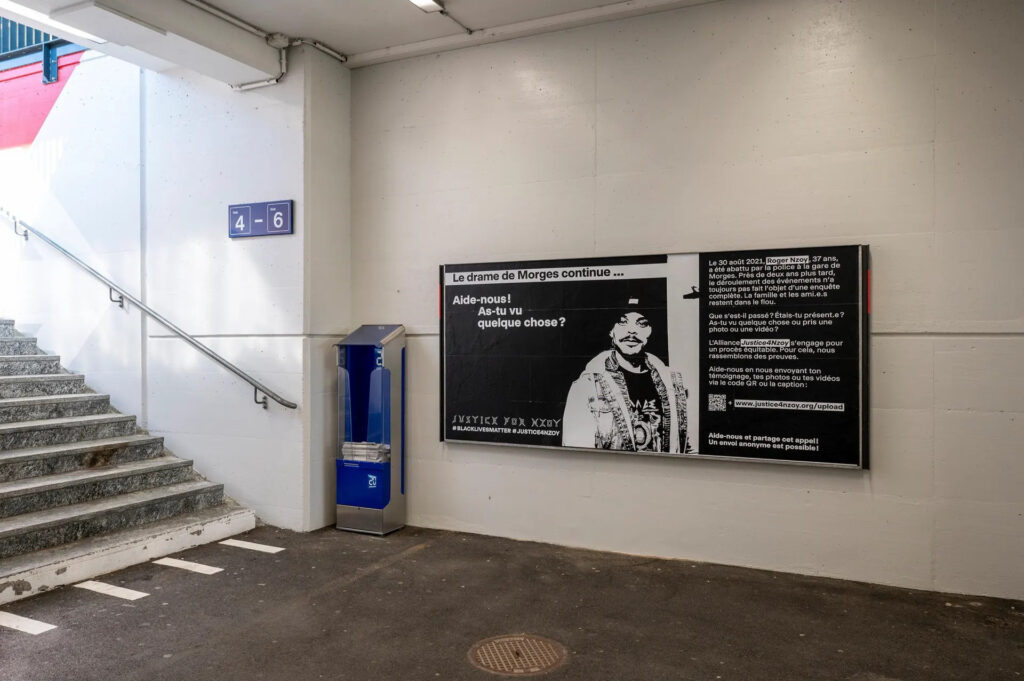
Finally, the Independent Commission has also produced targeted and contextual expert reports. These include: a psychiatric assessment of Nzoy’s behaviour, a medical assessment of Nzoy before and after the shooting, legal analyses of the criminal investigation and the ongoing legal process, historical analyses of Swiss colonial history and racism, media analysis of the case’s coverage, analysis of political debates and decisions on policing, and reflections on justice and its alternative forms. Supported by empirical and theoretical research, the expertises the Independent Commission has assembled are crucial to this counter-investigation and are integrated in this report.
Sources included in the case file
The data available in the case file have been collected by a variety of actors – mostly employees of the cantonal police – involved at different steps of the criminal investigation coordinated by the public prosecutor in charge. As of this publication, the case file includes:
- 23 transcripts of police hearings conducted with 11 witnesses, the four police officers involved (two hearings each), two forensic doctors, one police captain, the nurse who intervened to provide first aid and Nzoy’s father (internal ID system: 2000)
As no audio recordings of police hearings are present in the case file, the transcripts constitute reported statements written by police officers. Although in Switzerland police officers have the legal obligation to let the person interviewed review the hearing transcript before signing it,28“Swiss Criminal Procedure Code,” https://www.fedlex.admin.ch/eli/cc/2010/267/en, art. 78. statements in the transcripts cannot be taken as verbatims. Furthermore, as it is common in multiple recollections of the same event, testimonies usually diverge about its unfolding and its interpretation. The period between the events and the hearings also allowed for the circulation of public discourse, video footage, media articles and internal police reports, which may have shaped – explicitly or implicitly – the officers’ retrospective framing. The four police officers, who remained on active duty in the Morges police and continued working together, had opportunities to discuss the events, raising the possibility that convergences in their accounts may reflect not coincidence but conscious or unconscious harmonisation. Whenever statements from police hearings are used, they thus undergo careful examination through documented cross-referencing with other sources to assess their relevance and veracity.
- 15 videos recorded by witnesses or transmitted by Swiss Federal Railways and 15 photographs taken by witnesses (internal ID system: 1000)
As the incident took place during a weekday rush hour in a train station, while a train was held at a platform close to the violent encounter between Nzoy and the police officers, an important number of videos and photographs of the events were captured by eyewitnesses at different moments of their unfolding. These videos and photographs were gathered on the evening of the incident as well as during the following days on site and during police hearings. There were no surveillance cameras installed on the station platform. Some images, however, were obtained from the ticket machine at the station entrance and from cameras mounted inside the train stopped next to the scene. These videos were selected and transmitted to the police. It remains unknown whether other ticket machines or train-mounted cameras recorded the scene, but it appears that no fixed platform cameras existed at the time. We analyse their content and their metadata – the data recorded in a file that provides such information as the date, time and location of the file creation, as well as characteristics of the device used to create the file (e.g. camera model). This allows us to assess whether data shows signs of alteration or modification – something that we address in detail in Chapter 2 – and evaluate their relevance to our analysis.
- 13 audio recordings of police radio communication of varying length and one audio message from a witness (internal ID system: 1000)
Police radio communications were obtained from the police dispatch center – known at the time as the CET – and subsequently added to the file. All audio recordings were carefully examined to identify speakers, and were cross-referenced with visual material to assist in speaker identification and to detect missing information that was – intentionally or otherwise – not provided in the case file. The witness’ audio message contains no relevant information and is therefore not used in the investigation.
- Three abstracts of police training manuals (internal ID system: 7000)
Those elements consist of a selection of official Swiss police training manuals focusing on police shooting, tactical first aid and personal security. They are used in our analysis of the four sequences of events to understand and assess the police officers’ actions.
- One police investigation report, one forensic police investigation report, one police report on the “professional acts” of the police officers, one preliminary forensic medical report and one final forensic medical report (internal ID system: 4000, 8000, 5000)
These reports produce evidence and analysis on the unfolding of events that we systematically verify before using, while demonstrating some of their methodological and evidentiary limitations. They also contain substantial visual data as well as documents produced or obtained in the course of these investigations.
- Several letters and documents pertaining to the legal procedure and the criminal investigations (internal ID system: 3000, 6000, 7000)
These elements are used to understand and contextualise the unfolding of events as well as the criminal investigation processes and the legal issues that they raise.
Border Forensics’ reconstruction of the events
Our reconstruction divides the unfolding of events into four sequences corresponding to key stages of the events, which we analyse chronologically.
The first sequence we analyse focuses on the situation at Morges station before the arrival of the first and second police patrols. During this period, Nzoy exhibited behaviour indicative of a plausible psychological disorder, with indications pointing towards a psychotic episode. This is a temporary mental state in which a person loses the ability to correctly perceive or interpret reality, often involving delusions or hallucinations. The interaction with railway workers shows Nzoy attempted to maintain distance and expressed a desire to be left alone, highlighting his vulnerability rather than hostility.
We constructed an animated cartographic and videographic reconstruction by plotting the positions of all actors across the period of the first sequence on a georeferenced plan of the station platform. Sources used were the transcripts of police hearings, videos and audio recordings, which we synchronised into a single timeline. We also visualised the movements of the actors, incorporating uncertainty encoding. Radio communications used here are a selection provided in the case file; we later document missing radio communications and assess their implications. Because many files arrived re-encoded (e.g. via WhatsApp) with altered or missing metadata, we restored ordering through audiovisual matching. When video or audio coverage was absent, we triangulated positions and actions from police and witness hearings, critically weighting statements and documenting confidence levels.
The second sequence focuses on the arrival of the first and second patrols and the triggering effect it had on Nzoy, leading to a rapid escalation of the situation. Upon arrival of the patrols, Nzoy’s state shifted significantly; he became visibly more agitated, panicked and fearful. The intervention of the second patrol, arriving spontaneously, without clear necessity and rushing, heightened the stress and confusion for Nzoy, causing his behaviour to change from withdrawal to panic. This reaction can be attributed to his psychological distress and past experiences with discriminatory police practices.
We isolated the escalation associated with the arrivals of Patrols 1 and 2 by producing a synchronised, spatio-temporal map of their approach and first contact with Nzoy. Inputs were witnesses’ videos, case-file audio and transcripts of police/witnesses hearings. Data sources were time-aligned using file metadata where available and, otherwise, via audiovisual correlation. Combining data sources, we reverse-engineered approach dynamics – estimating speed and position in time – thereby assessing the rapidity and precipitousness of the police approach. The behavioural reading is grounded in this 2D reconstruction, cross-checked against hearings and audio analysis, and interpreted alongside the Independent Commission’s psychiatric expertise and relevant literature to differentiate confusion responses from threat signals.
The third sequence focuses on Nzoy’s run and the use of the firearm by PO4. Within seconds, the situation escalated dramatically. A central point of contention is the alleged presence of a knife in Nzoy’s hands. Our detailed analysis indicates that Nzoy’s hands were open before the first two shots, contradicting police and some witnesses’ statements that he “brandished” a knife during his “attack” towards PO4. Trajectory analysis further disputes the claim that Nzoy targeted an officer for attack, instead indicating a path consistent with confusion and flight rather than aggression.
We developed a three-step demonstration: (1) hearings content analysis of “knife” references; (2) pixel-based hand analysis; (3) 2D trajectory reconstruction. First, we analysed every mention of the knife in police and witness hearings, and flagged internal/external inconsistencies, demonstrating that the sole source of hearings to assess a weapon’s presence is insufficient. Second, using the elevated witness video that shows both of Nzoy’s hands immediately before the first shots, we stabilised the clip, isolated the frames of simultaneous hand visibility, delineated hand silhouettes and measured finger–palm separations relative to forearm landmarks to classify hand state (i.e. open and empty). Third, we superimposed a perspective grid derived from platform geometry onto videos and plotted footfalls for Nzoy and PO4 frame by frame; from these tracks we were able to characterise relative motion.
The fourth and last sequence analyses the measures that were undertaken after the shots. After Nzoy was shot and clearly incapacitated, police officers prioritised coercive means, such as handcuffing him and conducting a safety search, rather than providing immediate first aid, despite visible signs of life. It was six minutes later that emergency medical assistance was provided by a nurse who witnessed the event. This delay in administering first aid highlights significant faults and a fundamental disregard for human life by the police officers involved.
We assembled a post-shooting timeline anchored at the third and last shot by synchronising multi-source videos with radio calls, then measured elapsed intervals until the nurse’s arrival to the scene (≈ 04’:40’’) and the first physical contact with Nzoy (≈ 05’:38’’), to the start of CPR (≈ 06’:00’’–06’:30’’) and the handcuff removal (≈ 07:′00″). Actions visible on video (handcuffing, body positioning, object removal, etc.) were annotated and cross-referenced with officers’ statements. We evaluated observed practices against police “Tactical First Aid” training excerpts and an independent medical assessment to determine conformity with first-aid imperatives given the absence of ongoing threat, documenting any uncertainty directly in the visual outputs.

Sequence 1: Confusion and distress
Two train fines found in Nzoy’s bag indicate that he boarded a train in Zurich bound for Geneva where he arrived at 15:47. After 28 minutes, he took a train bound for Zurich and got off in Morges at 16:41.29Case file, 8167-8168. While the announced destination on the second train fine is Zurich, the reasons he exited the train in Morges are still unclear.
The first sequence we analyse starts when Nzoy arrives in Morges at 16:41. Here, we focus on his actions as well as his interactions with two railway workers present at the scene (RW1 and RW2) to assess the situation before the arrival of the first police patrol at 17:58. By cross-referencing witnesses’ statements and video and audio data with a psychiatric assessment conducted by the Independent Commission and psychiatric literature, our analysis demonstrates that Nzoy was in a situation of confusion and distress without showing signs of aggression towards himself or people around him. Until 17:55:10, the case file does not contain any visual or audio data of this sequence. We therefore analysed witnesses’ statements to place as precisely as possible the actions of Nzoy and the two railway workers (RW1 and RW2) in time and space.
In his police hearing, RW1 states that he noticed Nzoy for the first time when he saw him kneeling and praying behind two stationed wagons near the station’s loading dock. RW1 asserts that every time someone walked past him, Nzoy would stop praying.30“Je suis arrivé à la gare de Morges à 15h36. J’ai vu un individu vers 15h37, à côté de la voie 19, derrière les deux wagons de type « fans-u », à genoux, en train de prier. J’ai continué mon travail, mais à chaque fois que quelqu’un passait près de lui, il s’arrêtait de prier.” Case file, 2003, p. 2. As the timing RW1 puts forward in his hearing is inconsistent with the arrival of Nzoy in Morges, it is impossible to precisely time how long Nzoy stayed in this part of the station.
RW1, as well as other witnesses positioned on the platform, in a train or in the building overlooking the station, further states that Nzoy crossed the train tracks repeatedly. Most of the witnesses describe Nzoy using such words as “odd”31“Je gardais un œil sur lui, саг il me paraissait farfelu […].” Case file, 2003, p.2., “lost”32“Il avait l’air un peu paumé” Case file, 2013, p.3. or “agitated”33“[…] une personne qui se trouvait sur les rails et qui semblait agité, саг il gesticulait.” Case file, 2001, p.2; “Cette personne était très agitée.” Case file, 2006, p.2. in their statements. At some point, RW1, most likely distantly accompanied by RW2, interacts with Nzoy, trying to calm him down and prevent him from crossing the tracks.
At 17:55:10, RW1 calls the police. The recording of this call constitutes the first audio data present in the case file. During this call, RW1 talks to a police dispatcher and informs them that someone is “walking around on the tracks”. In the same recording, we hear the discussion RW1 has with Nzoy in the background. He asks him to stop, to calm down and to sit down. Nzoy answers in English, telling him to “get out of here”. At some point, Nzoy speaks in French and asks the railway worker to calm down as well – “toi, calme-toi”. RW1 then asks Nzoy what he wants to do, telling him not to “act crazy”. We do not hear Nzoy’s answer and the first police patrol arrives.34RW1 : “Actuellement, on a une personne qui se promène sur les voies de la gare… […] Tranquille […] Reste cool […] Zen, assieds-toi — ” Nzoy (l’interrompant) : “ Non, mais toi, calme-toi.” RW1 : “ […] Mais dis-moi ce que tu veux faire […] Fais pas le fou…” Case file, 1001.
Although RW1 states in his hearing that he did not manage to enter into a dialogue with Nzoy as he was speaking in a language he did not know,35“J’ai essayé de dialoguer avec lui, mais il m’a répondu dans une langue que je ne connaissais pas.” Case file, 2003, p.2. the audio recording clearly shows that a dialogue was initiated. Nzoy sounds confused, does not answer – or maybe does not fully understand – RW1’s questions or words.
In his hearing, RW1 further states that Nzoy was “aggressive at times” and wanted to go towards trains, without giving more precisions.36“Il était раr moment agressif et dès qu’un train arrivait, j’avais l’impression qu’il voulait aller vers sa direction.” Case file, 2003, p. 2. In the case file, a video filmed from a train held at the station shows Nzoy surrounded by RW1 and RW2 in the area of the tracks dedicated to train manoeuvres. The video does not contain metadata but we can situate it at approximately 17:56:06. In the video, we see him trying to avoid confrontation, circling around RW1 and advancing towards Platform 4/5, with what appears to be two minor physical contacts with RW1.
In his statement, RW1 interprets Nzoy’s behaviour as “suicidal”.37“Pour moi, il avait un comportement suicidaire et je ne voulais pas qu’il passe sous се train.”, Case file, 2003, p.2. As suicidal behaviour is complex to identify and manifests in diverse ways, we refrain from putting forward any conclusion on this matter as interpreting Nzoy’s intentions at that moment is beyond the scope of this investigation.38In his police hearing, Nzoy’s father states that Nzoy mentioned suicide in the months before his death, leading to the police’s attempt to interpret the events through the lens of “suicide by cop” (2014, p. 9). No direct evidence, however, is contained in either our analysis or the case file that would substantiate a correlation between potential suicidal behaviour and his killing. Furthermore, originating in the 1980s, the concept of “suicide by cop” has since been used by police and their advocates to frame civilian deaths during interventions, effectively shifting blame and often absolving officers of accountability. Regarded by scholars as “junk science”, allowing law enforcement to rely on softer evidentiary standards and expert statements to justify excessive force, this concept is still present in police training manuals in Switzerland and elsewhere. Such use undermines civil rights and deters accountability by recasting police killings as psychological self-harm rather than potentially unjustified violence. See notably: Jeffrey Selbin, “Suicide by Cop? How Junk Science and Bad Law Undermine Accountability for Killings by Police,” California Law Review 113 (2025) With the help of the Independent Commission, we rather focus on Nzoy’s observable actions in consultation with pre-existing knowledge of his health conditions.39Case file, 7002; Case file, 7003. While large-scale studies in psychiatry consistently show that people with psychotic disorders are more likely to be victims of violence than the perpetrators,40Bertine de Vries et al., “Prevalence Rate and Risk Factors of Victimization in Adult Patients With a Psychotic Disorder: A Systematic Review and Meta-Analysis,” Schizophrenia Bulletin 45, no. 1 (2019): 114–26, https://doi.org/10.1093/schbul/sby020. Nzoy’s behaviour seems to indicate a state of confusion and distress, with no signs of violence or aggression towards himself or others.
During this first sequence of events, Nzoy’s actions are characteristic of someone suffering from a psychotic disorder and align with the suspicion of psychosis diagnosed in the days and in the morning preceding his death. Furthermore, Nzoy’s tendency to stay in an isolated part of the station, avoiding other people and keeping physical distance, is consistent with psychiatric research on psychosis that identifies “[n]oisy environments […] as particularly harmful […] for people with psychosis in particular” and “a well-documented source of stress”.41Sara Merlino et al., “Walking through the City Soundscape: An Audio-Visual Analysis of Sensory Experience for People with Psychosis,” Visual Communication 22, no. 1 (2023): 73, https://doi.org/10.1177/14703572211052638. In this sense, the fact that Nzoy was praying in an isolated part of the station may indicate an attempt to withdraw from the noisy soundscape of the train station, and to ground himself in a situation of distress. On this basis, it appears that at that moment, both Nzoy and the railway workers were looking for resources to deal with the situation before the arrival of the police, which led to a rapid and dramatic escalation.
Sequence 2: Police intervention and triggering effect
The second sequence we analyse covers the beginning of the police intervention, with the arrival of Patrol 1 – composed of police officer 1 (PO1) and police officer 2 (PO2) – and Patrol 2 – composed of police officer 3 (PO3) and police officer 4 (PO4). Based on an analysis of video and audio data as well as transcripts of police hearings, we assess the unfolding of this part of the police intervention and the effects it has on Nzoy. While Nzoy had been relatively calm before the arrival of police patrols, our analysis shows that the arrival and the actions of the four police officers have a triggering effect on Nzoy, leading to a rapid escalation of the situation.
At 17:55:37, the police dispatcher, who is on the phone with RW1, specifically calls upon Patrol 1 who are stationed in front of Morges station in a police patrol car.42“[…] est-ce que tu pourrais, s’il te plaît, te rendre en gare ? On a un gars qui est sur les voies. [La patrouille 1 demande à répéter] On a un gars sur les voies. Si tu pouvais juste aller regarder, s’il te plaît, j’ai l’informateur en ligne”, Case file, 1001.
After confirming their intervention on the radio, a surveillance camera captures PO1 and PO2 running inside the station from the station’s main entrance.
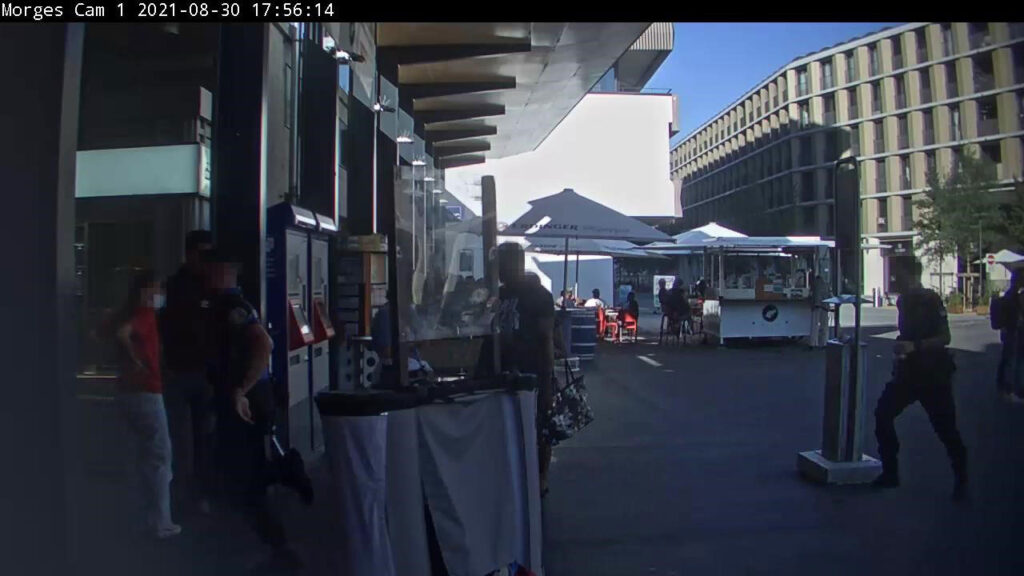
At 17:56:27, while Patrol 1 is entering the station, we hear in the same radio recording a communication initiated from the car of Patrol 2. PO4, part of Patrol 2, informs the police dispatcher that they are close to the station and intervening. The sirens of the police car that can only be activated in an emergency can be heard in the background:
Assessing the necessity and urgency of Patrol 2’s intervention
The intervention of the two police patrols is depicted in a simplified manner in the police investigation report, which states that “two police patrols were dispatched to the scene”.43“Deux patrouilles étaient dépêchées sur les lieux et arrivaient vers 17:58” Case file, 4001, p.48. As Patrol 2 includes PO4 – the police officer who shot Nzoy – and since only Patrol 1 was specifically called upon to intervene at Morges station by the police dispatcher, the reasons why Patrol 2 intervened as well – and with this degree of urgency – need a careful examination.
In their hearings on the night of the event, PO3 and PO4 both claim that it was due to their proximity to the events that they decided to intervene.44“[…] nous nous rendions aussi sur place, spontanément, саг nous étions а proximité de la gare” Case file, 2002, p.4; “À ce moment-là, au vu de notre proximité de l’intervention, mon collègue a enclenché les moyens prioritaires, soit les feux et les klaxons.” Case file, 2007, p.4. In a second hearing, PO3 further states that they “decided to intervene urgently because it is a risk context, given that it is a train station”.45“[…] nous avons surtout décidé d’intervenir en urgence, car il s’agissait d’un contexte à risque, s’agissant d’une gare.” Case file, 2021, p.3. While PO3 mentions that they heard another patrol was engaged and that they decided to intervene spontaneously,46“[…] nous nous rendions aussi sur place, spontanément, саг nous étions à proximité de la gare” Case file, 2002, p.4. PO4 states that there was “too much noise” on the radio traffic and that “a patrol was maybe closer than [them]”.47“Malheureusement pour nous, il y avait trop de bruit sur les ondes pour cette intervention. Il y avait une patrouille qui était peut-être plus proche que nous : il s’agissait de la [Patrouille 2].” Case file, 2007, p.4.
As no information that concerns specifically the decision-making process of an intervention is present in the case file, we cannot confirm nor deny conclusively the justification for the involvement of this second patrol based on Swiss police practices. The context in which this intervention took place combined with studies on policing, however, can provide elements of interpretation. In their hearings, PO3 and PO4 explain that they started their shift at 11:00 and were supposed to finish their day at 19:00. They spent the entire day up until the incident patrolling together. They describe it as a relatively calm day, with nothing happening in particular, except some traffic duty and the apprehension of “a person who expressed concerning remarks about the police”.48“Je commence mon tournus à 11:00. […], il n’y avait rien de particulier. […] Avant le repas, nous avons interpellé un monsieur qui avait des propos inquiétants vis-à-vis de la police. […] Il n’y a pas eu de souci particulier.”, Case file, 2002, p. 3. While research on police activities and practices in Switzerland is particularly scarce, research mostly conducted in the US, Canada, UK and France has shown that inactivity and boredom are predominant in police work.49Scott W. Phillips, “Police Discretion and Boredom: What Officers Do When There Is Nothing to Do,” Journal of Contemporary Ethnography 45, no. 5 (2016): 580–601, https://doi.org/10.1177/0891241615587385. In this context of “down time”, it has been documented that “minor facts […] often become major events, generating a flurry of excitement in the [police] crews and inducing disproportionate and inappropriate interventions”.50Didier Fassin, Enforcing Order: An Ethnography of Urban Policing (Polity Press, 2013), xiii. At the time when their spontaneous intervention was announced, neither the police dispatcher nor Patrol 1 provided further details regarding the situation at Morges station. While it is possible that, as stated by PO4, they did not hear that Patrol 1 was called upon and intervening – thereby contradicting PO3’s statement – this also raises the possibility that their decision to intervene was driven by the desire for action at the end of a “relatively calm day” rather than by an objectively established necessity or genuine urgency.
Triggering effect of the police intervention
The police investigation puts forward that Nzoy was “very agitated” before the arrival of the police, but witnesses’ statements support that it was the arrival of police patrols that led to a change in Nzoy’s behaviour, describing him as more “agitated”,51“Ils étaient 2 agents – à leur vue l’individu а paru encore plus excité.” Case file, 2001, p. 3. “excited”,52“Ce qui m’a marqué c’est que l’individu est devenu plus excité et plus agité quand lа police est arrivée alors que normalement l’arrivée de lа police apaise lа situation.” Case file, 2016, p. 6 “panicked” and “looking for an escape”,53“Cet individu а ensuite semblé paniquer et semblait chercher une échappatoire” Case file, 2003, p. 6 with one person mentioning that he even seemed “petrified with fear”.54“J’utilise le terme “course-poursuite” étant donné que j’ai eu l’impression que deux policiers venaient d’un côté d’une personne de couleur qui avait l’air tétanisée et que deux autres policiers sont venus par un autre côté, peut-être après avoir fait le tour du train, pour l’encercler.” Case file, 2017, p. 2. PO4 supports this interpretation when he states that it was his “presence and undoubtedly the fact that [he] was wearing a uniform that agitated him more”.55“Pour répondre au procureur, c’est bien ma présence personnelle et sans doute le fait que je portais l’uniforme qui l’a rendu plus agité.” Case file, 2018, p. 8. Here, as the case file does not contain any relevant video or audio material depicting the precise moments of the patrols’ arrivals, our analysis combines an examination of witnesses’ and police officers’ statements with an analysis of Nzoy’s psychological state and his past experience with discriminatory policing to demonstrate that the arrival of both patrols indeed shifted Nzoy’s behaviour from confusion and distress to panic and fear.
Patrol 1 reports perceiving Nzoy as “disturbed”, “in distress”, with potential “suicidal” thoughts at their arrival on the scene, with PO2 mentioning she initially thought of this intervention as one of “assistance”.56““[…] l’individu semblait perturbé et en détresse. J’avais le sentiment qu’il voulait mettre fin а ses jours” Case file, 2005, p. 3; “Pour ma part, j’ai plutot pensé а un possible suicide et donc а une intervention d’assistance.” Case file, 2019, p. 3. Studies have shown that the presence of several people with controlling behaviour and restraining equipment can trigger stress and agitation for a person who, like Nzoy, is already in a state of psychological distress. Psychiatric and psychological literature consistently emphasise the importance of maintaining physical distance in cases involving individuals exhibiting psychotic behaviour and the need to approach the person in crisis alone while others remain in the background and out of sight.57Mario Staller and Swen Koerner, eds., Handbuch polizeiliches Einsatztraining: Professionelles Konfliktmanagement – Theorie, Trainingskonzepte und Praxiserfahrungen (Springer Gabler Wiesbaden, 2022), https://doi.org/10.1007/978-3-658-34158-9; Clemens Lorei et al., “Deeskalation als Thema der polizeilichen Fortbildung in Europa. Ein Vergleich innerhalb der Europäischen Union,” SIAK-Journal − Zeitschrift für Polizeiwissenschaft und polizeiliche Praxis, no. 2 (2023): 18–35, https://doi.org/10.7396/2023_2_B
The triggering effect of this simultaneous intervention of police officers on Nzoy is further exacerbated by his past experiences with the police. We know from his family and close ones as well as from Nzoy’s writing, that, as a Black man, he had been the target of racial profiling and identity checks since a very early age, which led him to develop strategies to avoid trouble, such as carrying an ID with him at all times or carrying a travel bag to look like a tourist.58Carlos Hanimann, “17 Uhr 59 und 10 Sekunden,” Republik, February 22, 2025, https://www.republik.ch/2025/02/22/17-uhr-59-und-10-sekunden. Nzoy’s preventive measures against discriminatory practices reflect the complex interplay of subjugation and empowerment of racialised people, which can cause particular forms of harm.
Research supports that discriminatory and violent police practices can have harmful effects on people’s mental and physical health. It can lead to emotional and psychological distress, anxiety, alienation and a weakened sense of belonging, as well as distrust of public institutions and legal authorities.59Ontario Human Rights Commission, Paying the Price: The Human Cost of Racial Profiling (Ontario Human Rights Commission, 2003), https://www3.ohrc.on.ca/en/paying-price-human-cost-racial-profiling; David A Harris, Profiles in Injustice: Why Racial Profiling Cannot Work (The New Press, 2003); Rachel Neild and Lee Bridges, Reducing Ethnic Profiling in the European Union: A Handbook of Good Practices (Open Society Justice Initiative, 2012); Amanda Geller et al., “Aggressive Policing and the Mental Health of Young Urban Men,” American Journal of Public Health 104, no. 12 (2014): 2321–27, https://doi.org/10.2105/AJPH.2014.302046; Jack Glaser, Suspect Race: Causes and Consequences of Racial Profiling (Oxford University Press, 2015), xiii, 258; Eben Louw et al., “Wenn Alles Anders Bleibt. Psychosoziale Folgen Rassistischer Polizeigewalt,” in Alltäglicher Ausnahmezustand Institutioneller Rassismus in Deutschen Strafverfolgungsbehörden, ed. KOP (edition assemblage, 2016). A study on experiences of racial profiling in Switzerland reveals the immediate emotional impacts on people who regularly undergo police checks, such as humiliation, fear, anger and feelings of self-doubt, which often extend far beyond the encounters themselves.60Kollaborative Forschungsgruppe Racial Profiling, Racial Profiling Erfahrungen Wirkungen Widerstand (Rosa Luxemburg Stiftung, 2019), https://www.rosalux.de/publikation/id/40493/racial-profiling/. The constant threat of being stopped and searched fosters feelings of vulnerability and insecurity, pushing some individuals to alter their daily routines, such as avoiding certain areas, adjusting their appearance or self-policing their behaviour to minimise police attention.61Bernd Belina, “Der Alltag der Anderen: Racial Profiling in Deutschland?,” in Sicherer Alltag? Politiken und Mechanismen der Sicherheitskonstruktion im Alltag, ed. Bernd Dollinger and Henning Schmidt-Semisch (Springer Fachmedien, 2016), https://doi.org/10.1007/978-3-658-07268-1_6; Kollaborative Forschungsgruppe Racial Profiling, Racial Profiling Erfahrungen Wirkungen Widerstand; Tino Plümecke et al., “Effects of Racial Profiling: The Subjectivation of Discriminatory Police Practices,” Ethnic and Racial Studies 46, no. 5 (2023): 811–31, https://doi.org/10.1080/01419870.2022.2077124. For many people, these experiences erode self-esteem and reinforce a sense of exclusion, leading to such long-term outcomes as social withdrawal, restricted mobility in public spaces and distrust of law enforcement institutions.62Philomena Essed, Understanding Everyday Racism: An Interdisciplinary Theory (SAGE Publications, 1991), https://doi.org/10.4135/9781483345239; Yvette Brown, Black Men, Mental Health and Oppression: What Do We Learn When We Listen to Black Men’s Voices?, Coventry University, 2021; Vanessa E. Thompson, “Policing in Europe: Disability Justice and Abolitionist Intersectional Care,” Race & Class 62, no. 3 (2021): 61–76, https://doi.org/10.1177/0306396820966463; Claudia Wilopo and Tino Plümecke, “Intersectionality of Racial Profiling: A Call for a Broader Understanding,” in Overlapping Inequalities in the Welfare State: Strengths and Challenges of Intersectionality Framework, ed. Başak Akkan et al. (Springer International Publishing, 2024), https://doi.org/10.1007/978-3-031-52227-7_22.
The four police officers involved do not report adapting their intervention to Nzoy’s panicked behaviour nor put into question their intervention and the triggering effect it had on Nzoy. In police hearings conducted ten months after the events, they rather consistently put forward that it was the sudden apparition of the knife that changed the nature of the intervention.63“A ce moment, tout change.” Case file, 2018, p. 5; “Pour vous répondre, la nature de l’intervention а change саг оп se trouvait face а une personne potentiellement dangereuse et menaçante.” Case file, 2020, p. 5; “Pour vous répondre, la présence d’un couteau change la donne, саг cela reste une lame et qu’on sait que c’est une arme qui peut être létale, qui est manipulable très facilement sans formation particulière.” Case file, 2021, p. 5. While we address its presence in detail in the next sub-chapter, the knife constitutes the main justifying element for the police officers’ actions and the escalation of the situation.
In their first hearings PO1 and PO4 both state that, faced with Nzoy holding a knife with “his arms hanging loosely”, they drew their guns, with PO1 pointing it at Nzoy64“Au début, il le tenait sans être menaçant, le bras ballant. […] Pour ma part, j’avais sorti mon arme de service tout en faisant les injonctions. Mon arme était dirigée contre lui, doigt le long du pontet de sous-garde.” Case file, 2005, p. 4. and PO4 “trying to mask [it] so that the individual could not see that [PO4] took it out”.65“J’ai essayé de masquer mon arme afin que l’individu ne puisse pas voir que je l’avais sortie.” Case file, 2007, p. 5. At that moment, Nzoy was on the train tracks at a distance from police officers who were all on the platform. While the Swiss police training manual on police shooting states that “[t]he use of a firearm constitutes an ultimate mean – i.e. that there is no other means to act – and has to respect the proportionality principle”,66Institut suisse de Police, “Tir de police,” 2017, p.14. the fact that both police officers drew their firearms clearly questions the proportionality of their actions and their assessments of the threat. Moreover, PO4 was clearly conscious of the triggering effect it might have on Nzoy, mentioning during his second hearing that he was hiding his gun because he was “scared that it creates something in him […] because he was not in his normal state, he was not himself and was agitated.”67“[J’ai tenu mon arme le long de ma jambe] [p]our pas qu’il ne la voie. J’avais peur que cela créé quelque chose chez lui. […] J’avais peur que la vue de mon arme déclenche quelque chose chez M. Wilhelm. J’avais peur саr il n’était pas dans un état normal, qu’il n’était pas à lui et qu’il était agité.” Case file, 2018, p. 6. Nevertheless, none of the police officers report making attempts to de-escalate the situation.
In conclusion, the police intervention and the rapid engagement of firearms combined with Nzoy’s psychological state at Morges station and his past experiences of discriminatory policing triggered a reaction of panic and fear in him.
Sequence 3: A knife, 50 seconds and a shooting
The third sequence we analyse captures the pivotal and most contentious phase of the events. It spans from the first verbal reference of a knife by PO1 via radio at 17:58:11 to the third and last shot fired by PO4 at 17:59:01. These crucial 50 seconds show the rapid and dramatic escalation of the situation and reveal the police officers’ misperception of threat that led to their disproportionate and coercive response. The police investigation report states that upon their arrival at the station, “the four police officers found themselves in front of an individual armed with a knife”,68“A leur arrivée, les quatre policiers se sont retrouvés face à un individu armé d’un couteau.” Case file, 4001, p. 48. depicting Nzoy as “very determined to attack the police officer” during “the knife attack”.69“En outre, d’après l’image, on constate que lors de son attaque au couteau, M. Roger Michael Wilhelm était très déterminé à s’en prendre au policier.” Case file, 4001, p. 49. The narrative of a knife attack by Nzoy on PO4 has been treated as self‑evident, shaping and justifying the lethal use of his firearm, but our analysis examines this complex sequence through a three‑stage process and produces new evidence that directly opposes the conclusions of the criminal investigation, which are entirely hinged on the presence of a knife.
First, we examine all eyewitnesses’ and police officers’ statements to identify each reference to the knife and highlight when each person saw the knife or believed it was present. By cross-referencing these statements, we demonstrate that the substantial internal and external contradictions, incoherences and uncertainties do not allow any conclusions to be drawn on the continuous presence of the knife or on its threatening use by Nzoy solely based on transcripts of police hearings. Second, we analyse a sequence of a video filmed by a witness from an apartment overlooking Morges station that shows both of Nzoy’s hands at the same time. Using a video-pixel analysis, we demonstrate that both of Nzoy’s hands were open before the first shots, making it highly unlikely that he was holding a knife. Third and finally, we reconstruct the trajectories of Nzoy and PO4 by superimposing a perspective grid onto video evidence to plot their footsteps in time and space. Our analysis demonstrates PO4 makes two consecutive sidesteps intercepting Nzoy’s trajectory and opposes the argument that Nzoy was running towards PO4 in an attempt to attack him.
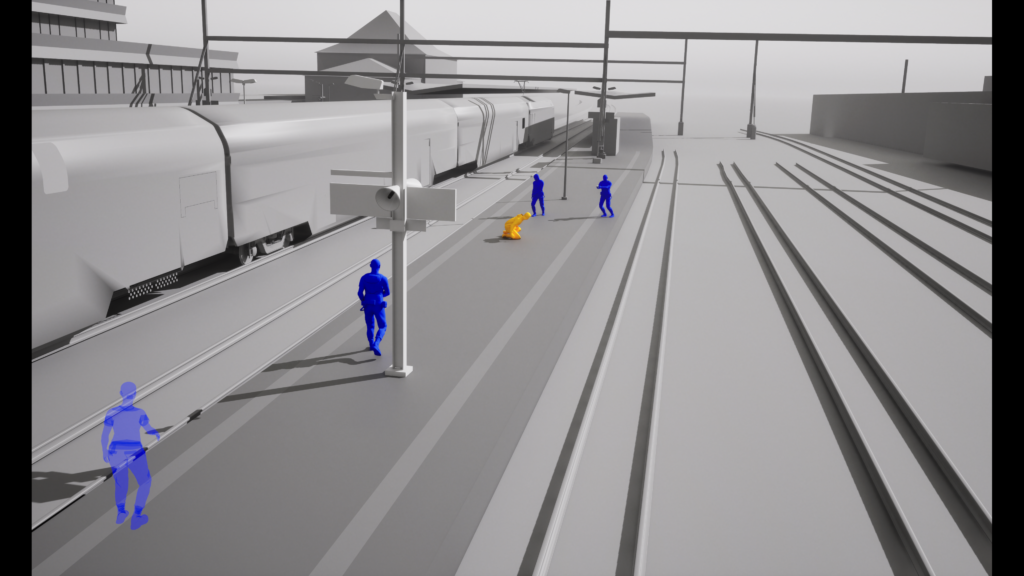
Police hearings analysis
The transcripts of police hearings contain more than two dozen references to a single object: the knife. By cross-referencing these statements, we demonstrate that substantial internal and external contradictions, incoherences and uncertainties do not allow any conclusion to be drawn on the continuous presence of the knife nor on its threatening use by Nzoy solely based on transcripts of police hearings. This leads to the central question of this section: can the statements alone be used to establish the continuous presence and threatening use of a knife, as concluded by the criminal investigation?
To introduce the discrepancies between the statements of different actors that follow, we foreground several of the officers’ early perceptions during the events that they themselves recall. The following quotes from the police officers offer a glimpse of the contradictions between the different references to the knife. PO1 recalls that “the individual appeared disturbed and in distress.70“Pour vous répondre, l’individu semblait perturbé et en détresse.” Case file, 2005, p. 3. PO4 agrees with this first impression, adding that Nzoy grew visibly agitated only when he arrived, “probably because [he] was wearing the uniform”.71“Pour répondre au procureur, c’est bien ma présence personnelle, et sans doute le fait que je portais l’uniforme, qui l’a rendu plus agité.” Case file, 2018, p. 8. PO2 goes further: “Even though he had a knife in his hands at that moment, I did not feel he was threatening.”72“Même s’il avait un couteau en main, je ne l’ai pas ressenti menaçant à ce moment-là.” Case file, 2019, p. 4.
These early perceptions that notice Nzoy’s distress and characterise a non-threatening situation vanish in the criminal investigation’s reconstruction, where they are replaced by a retrospective certainty that once the knife was seen, everything changed. We therefore undertook an examination of the contradictions these statements present. What follows shows how fragile this retrospective certainty is.
From here we conduct a systematic assessment of the record. We (a) specify our sources; (b) identify procedural conditions that affect reliability (e.g. timing, access to transcripts and potential collusion); and (c) conduct a police officer-by-police officer evaluation alongside witness evidence.
The first round of hearings took place on the evening of the incident, on 30 August 2021. PO1, PO2, PO3 and PO4 were each questioned by police investigators shortly after the shooting. It is safe to assume that these initial hearings occurred under time pressure and emotional duress, providing raw, contemporaneous accounts of the events. Eight civilian witnesses were also interviewed – among them the nurse who came to the aid of Nzoy and the driver of the train held at the platform – either on the day of the events or within the subsequent three days.
A second round of hearings was conducted nearly ten months later in June 2022: PO1 was re-interviewed on 21 June 2022, PO2 on 17 June 2022, PO3 on 24 June 2023 and PO4 on 15 June 2022. It is important to bear in mind that this time gap is critical, as it allowed for the circulation of public discourse, video footage, media articles and internal police reports – all of which shaped, explicitly or implicitly, the officers’ retrospective framing of the events. It also allowed the four police officers – still on duty – to discuss the events and corroborate statements, wherein statements might converge not through coincidence, but potentially through deliberate or subconscious harmonisation influenced by institutional proximity and the absence of preventative safeguards against collusion. This risk of narrative alignment is consistent with established research on memory conformity, which explains that post‑event discussion can unintentionally reshape individual recollections.73Fiona Gabbert et al., “Memory Conformity: Can Eyewitnesses Influence Each Other’s Memories for an Event?,” Applied Cognitive Psychology 17, no. 5 (2003): 533–43, https://doi.org/10.1002/acp.885. In line with this, it is important to mention that during their second hearing, PO4 and PO2 admitted having had access to the transcript of their first hearing before the conduct of their second hearing.74“J’ai pu lire les procès-verbaux d’audition et les rapports de police, ainsi que les images-vidéos.” Case file, 2018, p. 2 / “[L’avocat de PO2] explique avoir demandé ce procès-verbal à l’inspecteur qui le lui a transmis.” Case file, 2019, p. 12. The apparent absence of collusion-prevention measures – such as separation of officers, strict controls on access to procedural documents or suspension pending investigation – is particularly troubling. Allowing involved officers to review transcripts, reports and the case file before re‑interview undermines independent recollection. Such access can substitute memory with file‑dependent narrative, blurs the witness/subject boundary and compromises impartiality. In comparable cases involving civilian suspects, such measures are standard, including pre-trial detention in situations where there is risk of collusion. Here, no such precautions were taken, suggesting a double standard rooted in institutional loyalty and systemic bias. These conditions inform the interpretive lens applied in the analysis below.
PO1
According to PO1, Nzoy “suddenly, without warning signs and without any exchanged words, pulled out a knife.” PO1 could not determine the knife’s size, only that it was “perhaps smaller than a bread knife”, and noted that Nzoy held it “without being threatening”, with his “arm hanging loosely”.75“Subitement, sans signes avant-coureurs et sans propos échangés, il a sorti un couteau. Je ne saurais dire la taille de ce couteau. Peut-être plus petit qu’un couteau à pain. Au début, il le tenait sans être menaçant, le bras ballant.” Case file, 2005, p. 4. Despite this, PO1 immediately drew his firearm and issued commands. In the same hearing, however, PO1 contradicts himself by stating that he “felt in danger as soon as he pulled out the knife. We had the train tracks behind us, and that was very dangerous.”76“Je me suis senti en danger dès qu’il a sorti le couteau. Nous avions les voies du train dans notre dos et cela est très dangereux.” Case file, 2005, p. 5. Only this second statement was picked up in the official narrative – not the first more ambivalent observation. This juxtaposition reveals a significant internal contradiction: on one hand, Nzoy is portrayed as troubled but non-threatening; on the other, the mere sight of the knife retroactively transforms the scene into one of immediate danger.
In his second hearing a year later, PO1’s recollection becomes more structured but equally contradictory. He states that Nzoy pulled out a knife in his right hand after taking a few steps, though he did not see where it came from.77“Après quelques pas, il a sorti un couteau qu’il a tenu dans sa main droite. Je n’ai pas vu d’où il l’a sorti.” Case file, 2020, p. 5. Again, he says the knife was not brandished and that Nzoy’s arms remained down at his sides. Still, he concludes the situation was dangerous because Nzoy was unpredictable. This rationale implies that danger arose not from concrete action but from speculative intent.
PO1’s narrative also changes regarding what Nzoy did with the knife. At one point, he says Nzoy dropped the knife and picked it up again, but that it was not in reaction to police commands.78“Je me souviens qu’il a lâché son couteau par maladresse sur les voies et qu’il l’a immédiatement ramassé. Pour vous répondre, il était flagrant que ce n’était pas pour donner suite à nos injonctions.” Case file, 2020, p. 5. Elsewhere, he says Nzoy concealed the knife under his clothing or bag and never let it go, even when back on the platform.79“J’ai le souvenir que M. Wilhelm cachait son couteau soit sous un vêtement, soit sous la sacoche qu’il portait en bandoulière. Pour vous répondre, à aucun moment il n’a lâché son couteau, même en remontant sur le quai.” Case file, 2020, p. 6. Although the exact sequence is unclear, these two descriptions cannot both be true simultaneously. Nzoy cannot have both dropped the knife and never released it.
PO1’s two statements paint a picture that does not become more consistent over time, only more fixed and defensive. In his first hearing, he describes a moment of confusion and distress, acknowledging that Nzoy did not act aggressively. In the second, his account aligns more closely with the narrative of the criminal investigation: a clear escalation, a threat, a justified response. The shift in tone and content between the two interviews appears to be driven more by a sharpening of defence rather than a deepening of memory. The changing details – about the knife, Nzoy’s behaviour and PO1’s own perception – undermine the credibility of the reconstruction.
PO2
PO2’s statements do not provide greater clarity; instead, they expose the persistent uncertainty surrounding Nzoy’s actions and the knife. In her earliest hearing, PO2 recalls being told by PO1 that Nzoy had a knife. She then claims to have visually confirmed this, though she could not say which hand held it or describe the object.80“Peu après, j’ai effectivement constaté qu’il avait un couteau dans la main, sans pouvoir dire laquelle. Je lui ai confirmé qu’il avait un couteau. Je ne peux pas non plus donner de description de cet objet.” Case file, 2008, p. 4. From the outset, PO2’s perception is vague, filtered through others, and lacking precision.
In her second hearing, PO2 says Nzoy was holding the knife “with his arm down” and never raised it above hip level.81“Il l’avait juste en main, le bras vers le bas. À mon souvenir, je ne l’ai jamais vu monter le couteau plus haut que la hauteur de ses hanches.” Case file, 2019, p. 7. His posture, she reiterates, did not seem threatening. Reflecting that sentiment, PO2 confirms she never drew her weapon, unlike all her colleagues.82“Je ne l’ai pas sortie. Pour vous répondre, tout le monde avait sorti son arme à feu sauf moi.” Case file, 2019, p. 8. This lack of physical reaction underscores her initial impression: whatever she saw did not justify the engagement of a firearm for her.
Contradictions are also revealed when comparing PO2’s two statements. In the first one, PO2 appears confident, stating: “the individual continued to approach [PO4] rapidly, without slowing down, still holding his knife”.83“Je vous réponds que l’individu a continué à se rapprocher vivement de [PO4], sans obtempérer, soit en tenant toujours son couteau.” Case file, 2008, p. 5. The knife is presented as visible and decisive. Yet by the second hearing, that certainty disappears. Asked if Nzoy still had the knife at the moment he started running, PO2 replies: “I don’t know if he had it at that moment. I assume that he did. I could not say if he was brandishing it or what he did with it. I wasn’t looking at his hands anymore, but at the overall situation”.84“Je ne sais pas si à ce moment-là il l’avait. Je pars du principe que oui. Je ne pourrais pas dire s’il le brandissait ou ce qu’il en avait fait. Je ne regardais plus ses mains, mais la globalité de la situation.” Case file, 2019, p. 6. When asked whether Nzoy dropped the knife at any point, PO2 answers: “Not to my recollection.”85“Pas à mon souvenir.” Case file, 2019, p. 8.
This is not a minor inconsistency. It is a fundamental contradiction. In the first account, the knife is the observable trigger for lethal force. In the second, it becomes an unconfirmed assumption. PO2 shifts from seeing to presuming, from observation to speculation.
PO3
PO3’s recollections add yet another layer of ambiguity. He first mentions hearing about the knife over the police radio, not seeing it directly.86“En s’approchant, on entend sur les ondes qu’il y a une notion de couteau.” Case file, 2002, p. 4. In his later account, he confirms that at the time of the radio announcement, he was still walking towards the scene and had not yet seen the knife himself. He did not feel threatened at that moment because he had not seen the knife yet.87“Pour vous répondre, je n’ai personnellement constaté que M. Wilhelm avait un couteau que plus tard. […] Je n’ai pas vu tout de suite le couteau, dès lors je ne me sentais pas menacé.” Case file, 2021, p. 5.
PO3 does finally claim to spot the knife when it reflects a flash of sunlight: he sees “the blade shine in the rays of the sun” as Nzoy rises up after bending down.88“À un moment donné, il s’est baissé. En se relevant, j’ai vu la lame briller avec les rayons du soleil.” Case file, 2021, p. 5.This visual clarity, however, fades quickly. PO3 says he does not remember which hand held the knife. He doesn’t “remember if [he] saw or not the knife once [Nzoy] was on the platform”.89“Je n’ai pas de souvenir à cet égard. Je ne me souviens plus si j’ai vu ou pas le couteau, après qu’il soit remonté sur le quai. Je ne saurais pas vous dire dans quelle main il le tenait.” Case file, 2021, p. 6. Later still, when asked whether Nzoy brandished the knife during the approach, PO3 answered, “I don’t recall. […] I do not recall seeing the knife at all.”90“Je n’en ai pas le souvenir. Pour répondre au procureur, je n’ai pas le souvenir de voir le couteau tout court.” Case file, 2021, p. 9.
After PO3 mentions in his first hearing that Nzoy did not make any gesture with the knife,91“Pour vous répondre, il n’a pas fait de gestes avec son couteau, il le tenait fermement dans sa main.” Case file, 2002, p. 7. in the second hearing the prosecutor asks if this was the first time he was confronted with someone “brandishing a knife” and PO3 does not correct the use of the word “brandish”.92“Était-ce la première fois que vous étiez confronté en intervention à une personne brandissant un couteau et pouvant être menaçant pour votre sécurité ou celle de vos collègues ? Et depuis les faits ?” Case file 2021, p. 2.
This disintegration of detail is important. The knife is supposedly central to the threat, yet one of the officers closest to Nzoy at the moment of escalation cannot say if Nzoy still had it, how he held it or whether he made any gesture with it.
PO4
PO4’s statement is scattered with hesitation, sensory gaps and fragmented impressions. He explicitly states that he learned about the knife not by seeing it, but from hearing PO1 say “he has a knife” multiple times upon arriving at the scene.93“Je me suis rapproché de plus en plus et à un certain moment j’ai entendu [PO1] dire “il a un couteau”. À plusieurs reprises, il répétait cela.” Case file, 2007, p. 5. Initially, PO4 had not seen the knife himself, and he recalls that after hearing the metallic sound of something falling to the ground, he associated that sound with a knife.94“Tout d’un coup, j’ai entendu le bruit du métal qui tombe. J’ai entendu quelque chose de métallique tomber. J’ai associé ce bruit à un couteau.” Case file, 2007, p. 5.
Eventually, PO4 claims to have seen a knife “in one of his hands” but cannot say which hand, nor describe the weapon precisely. He recalls the blade only by the reflection of sunlight on it and admits his view was obstructed: “the hand holding the knife was either in the bag or behind it. I could not see it anymore.”95“Pour vous répondre, j’ai vu qu’il tenait avec une main un sac, devant lui, contre sa poitrine. Je ne peux pas vous décrire ce sac. La main qui tenait le couteau était soit dans le sac, soit derrière celui-ci. Je ne la voyais plus.” Case file, 2007, p. 6. Even in PO4’s most assured recollections, the knife appears more as a presumed presence than a clearly observed one.
PO4 says he did not see the knife, nor the hand that supposedly held it, as Nzoy approached, but nonetheless concluded: “even though I did not see the knife while he was running towards me, I did not see the knife falling either since the moment he picked it up from the floor. In my opinion, he must have still had it in his hand.” The phrase “he must have” recurs in PO4’s framing, indicating that his assertions rest not on direct observation but on assumption. In contrast to this uncertainty, PO4 also makes definitive claims: that Nzoy was running “with a knife in his hand”.96“M. Wilhelm courait avec un couteau à la main. Pour répondre […], même si je n’ai pas vu le couteau alors qu’il courait dans ma direction, je n’ai pas vu non plus le couteau tomber depuis le moment où il l’a ramassé au sol. À mon sens, il l’avait donc forcément en main.” Case file, 2018, p. 11. These statements are difficult to reconcile with PO4’s repeated inability to describe or locate the knife at decisive moments. The shifting between certainty to doubt, from “he had a large knife” to “I didn’t see”, echoes the same narrative construction seen in other statements.
As with the other officers, PO4’s account is marked by post-facto clarity grafted onto a moment of confusion. His statements illustrate the recurring pattern: the presence of a knife is inferred rather than observed. When the reality of what was seen proves elusive, certainty fills the gaps.
Witnesses
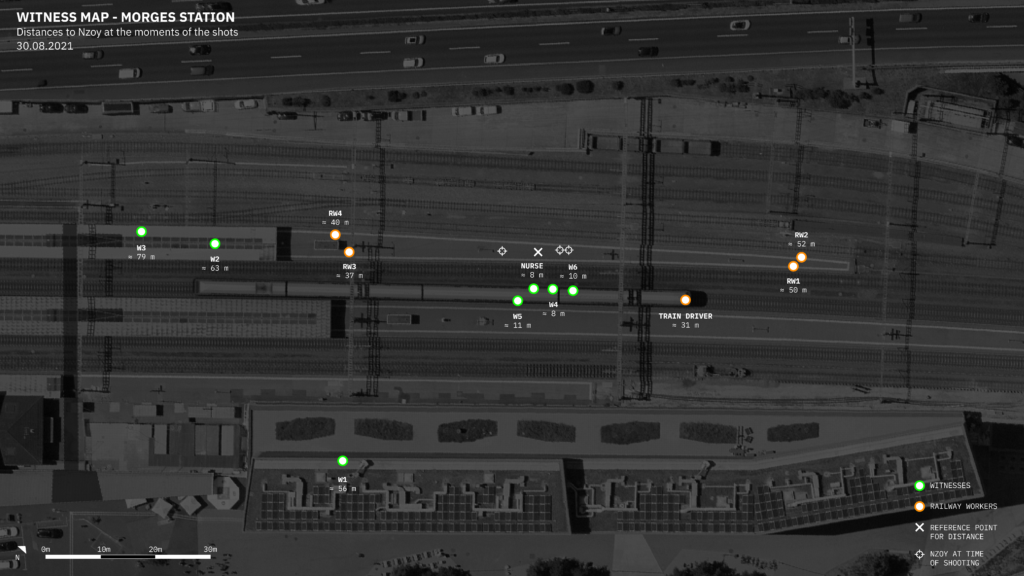
Witness W1 categorically states that Nzoy had nothing in his hands when the shots were fired and claims to have recorded video evidence to support this.97“Je suis certaine qu’il n’avait rien dans les mains au moment du premier coup de feu. […] Je pense qu’en zoomant [sur la vidéo], il doit être possible de voir qu’il n’a rien dans les mains.” Case file, 2001, p. 3. Similarly, W4 initially believed Nzoy had a knife but later claims it was hidden by his bag and could not be seen.98“Ce monsieur avait la main sur le côté, dirigée vers les policiers, comme s’il voulait les planter. Je précise que je ne voyais pas le couteau car il était caché par le sac que le monsieur tenait devant lui. Avec l’autre bras, c’est comme s’il se protégeait le visage.” Case file, 2012, p. 4. W5 says he never saw a knife until after the shooting, when someone pointed it out lying on the ground.99“À ce moment-là, il y a un des garçons avec moi qui dit : “ah mais il avait un couteau en fait !”. J’ai dit : “Ah bon ?”. Il m’a dit : “oui, un des policiers vient de le lui enlever”. Pour vous répondre, je n’avais pas vu de couteau avant cela, mais juste après que le gars ait dit cela, j’ai vu ce couteau par terre.” Case file, 2015, p. 4. W3, too, confirms never seeing a weapon, only hearing from others that Nzoy had one.100“Tout ce que je peux vous dire, c’est que j’ai entendu dire que l’individu avait un couteau et qu’il allait agresser les policiers. Moi, je n’ai absolument rien vu.” Case file, 2006, p. 4.
Some witnesses appear to retroactively project the presence of a knife. W6 sees a shine and interprets it as a knife.101“J’ai eu l’impression que la personne noire tenait un couteau dans sa main car j’ai vu que quelque chose brillait.” Case file, 2017, pp. 2-3 A train driver witnessing the scene claims to have seen Nzoy pull out a knife and chase an officer, offering a detailed description of blade shape, but acknowledges it all happened very quickly and that where the knife came from was unknown to him.102“Pour vous répondre, j’ai bien vu l’individu avec le couteau, en fait je l’ai vu sortir le couteau. Je ne saurais pas dire d’où il l’a sorti par contre. J’ai bien reconnu un couteau. Dans mes souvenirs, la lame a pu être un peu courbée plutôt que toute droite, mais une fois de plus ça va très vite. Je ne vois pas les détails exacts du couteau, mais je reconnais un couteau.” Case file, 2016, p. 4. W2 recalls “something in his hand”, but cannot identify it precisely.103“En fait, j’ai aussi vu qu’elle avait une arme, je ne sais pas si c’est un pistolet mais elle avait quelque chose, un truc dans la main, un couteau ou quelque chose mais pas un crayon.” Case file, 2004, p. 3. The nurse who later intervenes describes a “cinematic” scene in which Nzoy brandishes a knife after being shot.104“Et après le deuxième coup de feu, la personne était encore debout et a fait mine de foncer vers les policiers, couteau dans la main. […]Je l’ai identifié dans la main droite de la personne, je crois. Menaçant, il allait vers les policiers. C’était un petit couteau à steak IKEA. J’ai eu l’impression, comme dans un film, qu’après avoir reçu les deux premières balles, il a voulu se jeter sur les policiers et a brandi son couteau. Après les deux premiers coups de feu. C’était le moment le plus agressif et c’est là que le 3ème coup de feu est parti. Encore une fois, c’est une question de secondes.” Case file 2009, pp. 2-3.
Having analysed each account, we connect the threads to articulate the broader evidentiary implications. These observations are not merely inconsistent, some are outright irreconcilable. Descriptions of the knife’s size range from invisible to 30 cm. Some say it was brandished; others say it was never raised. Some describe the blade catching the light; others say Nzoy’s hands were empty. Crucially, video footage reviewed during the investigation does not show Nzoy brandishing a knife at any point, raising a central question: how could witnesses have seen what the video recordings do not show?
The stark contradictions that emerge among the police officers’ and witnesses’ statements suggest that many recollections of the knife were shaped less by direct visual evidence than by stress, confusion and suggestion, both during and after the events. Once the word “knife” was uttered at the scene – broadcast on police radio and repeated in commands – and after a knife was effectively found on the scene, it became the prism through which all subsequent actions were filtered. Where sight failed, narrative filled the void. Gestures that might otherwise be seen as defensive, confused or benign were recast as threatening because the knife had already entered the story.
The knife’s presence reveals less about Nzoy than about the machinery of perception under stress: how a single, ambiguous object can be amplified through institutional echo and cultural bias until it drowns out the reality of what actually happened. It is important to note that all statements lack precision regarding the timing of what was sensed and observed. While the knife might have been seen at some point, this becomes the basis for the entire unfolding of events according to the official narrative.
Taken together, these contradictions expose a fundamental flaw in the official state narrative: the sole reliance on these statements as evidence of a knife being held at the decisive moment is fallacious. It is not possible to cross‑reference all the accounts to establish the knife’s presence with any certainty; at best, they prove that the officers were confused and unsure of what they were seeing. This analysis therefore demonstrates that statements alone are insufficient for a case of this gravity. Their uncritical use reflects, at minimum, a lack of investigative rigor by the public prosecutor and, at worst, raises serious concerns about the adequacy and impartiality of the effort to shed light on what actually happened. Far from proving an “attack”, the statements reveal only a narrative built on speculation, amplified fear and institutional echo. The narrative in which Nzoy uses a knife threateningly is not proved by careful analysis of statements, nor by the video footage we have analysed, which we explore in the following section.
Hands analysis
In a video taken vertically from an apartment overlooking Morges station, a sequence of 67 milliseconds, corresponding to a total of four frames, shows both of Nzoy’s hands at the same time. This sequence constitutes a crucial means of proof as it is the only visual data available where both Nzoy’s hands are visible at the same time. In her police hearing, the witness who shot the video states that she is “certain that [Nzoy] did not have anything in his hands at the moment of the first shot”.105“Je suis certaine qu’il n’avait rien dans les mains au moment du premier coup de feu.” Case file, 2001, p. 3. This video was not analysed in detail in the context of the criminal investigation and this statement was not taken into account by the public prosecutor in his abandonment of proceedings, but we use these pieces of evidence to conduct a precise visual and spatial analysis to answer the following question: Was Nzoy holding a knife in his hands at the time of the first two shots?
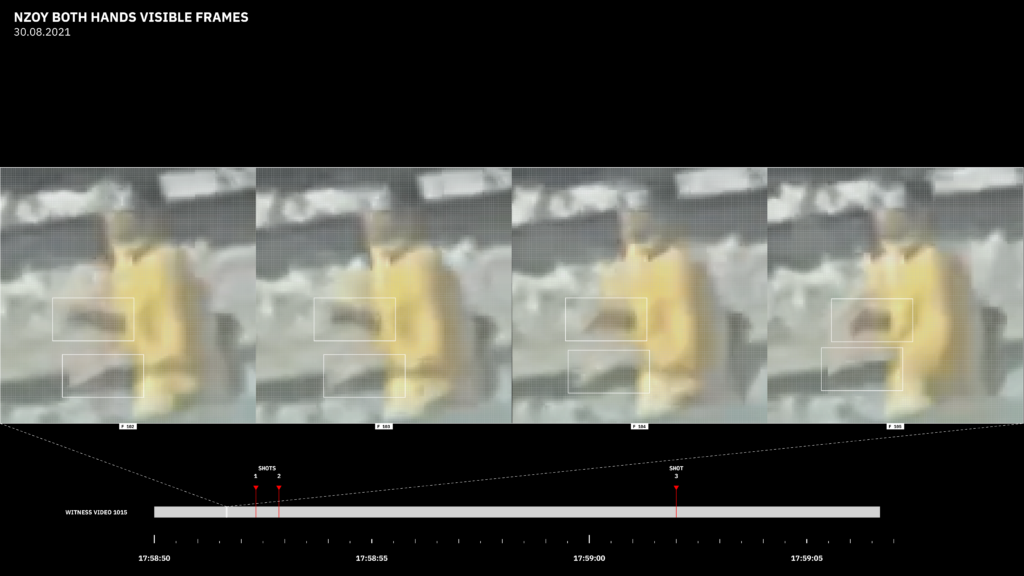
When zoomed in, the pixelated image allows one to distinguish Nzoy’s hands. While the reduced quality of the image and the distance from which it was taken probably situate the potential presence of the knife below the threshold of detectability, our analysis did not focus on the potential presence of the knife – which might be invisible in the image – but on the shape and motion of Nzoy’s hands. Beyond the mere visual analysis of this video, we assessed whether his hands were opened or closed, and thus whether they could hold such an object as a knife.
To do so, we first conducted a pixel-based analysis of the selected video frame to assess whether the shapes visible in the footage are consistent with the size and form of open hands. These measurements were then compared to the recorded hand dimensions from Nzoy’s autopsy report. Additionally, this sequence of frames was further analysed to evaluate the shape and motion of the hands, to determine whether they can be confidently identified as open hands and therefore not as closed fists holding a knife.
Description of the pixel analysis method
To calculate the real-world size of a pixel and thus a collection of pixels that make up an object, we conducted a detailed analysis that unfolded in several steps:
First, we collected technical specifications of the camera from the metadata of the video and calculated characteristics crucial to our analysis:
- Camera model: iPhone 12 Pro Max
- Lens: To identify the lens used, we cross-referenced the iPhone’s hardware specifications with external sources. This analysis confirmed that the telephoto lens featured a 2.5× optical zoom and was used to record the sequence.
- Image resolution: The number of pixels in the image, typically expressed as width × height. The video evidence has a high 4k resolution, corresponding to 2160 (width) × 3840 (height). In this sense, the image captures a high number of details and allows a more precise analysis.
- Frame rate: The number of frames captured per second. The video has 60 frames per seconds (fps), which allows a relevant analysis of fast movements.
- Focal length: The distance between the camera’s lens and its sensor (when focused on a subject), measured in millimetres, which determines how zoomed in or wide the captured image appears. Here, the focal length is 9 mm.
- Camera sensor height: The vertical measurement of the camera’s image sensor, usually in millimetres, which defines how much of the scene is captured vertically and is essential for calculating the field of view. In this video evidence, the camera sensor height is 4.1 mm.
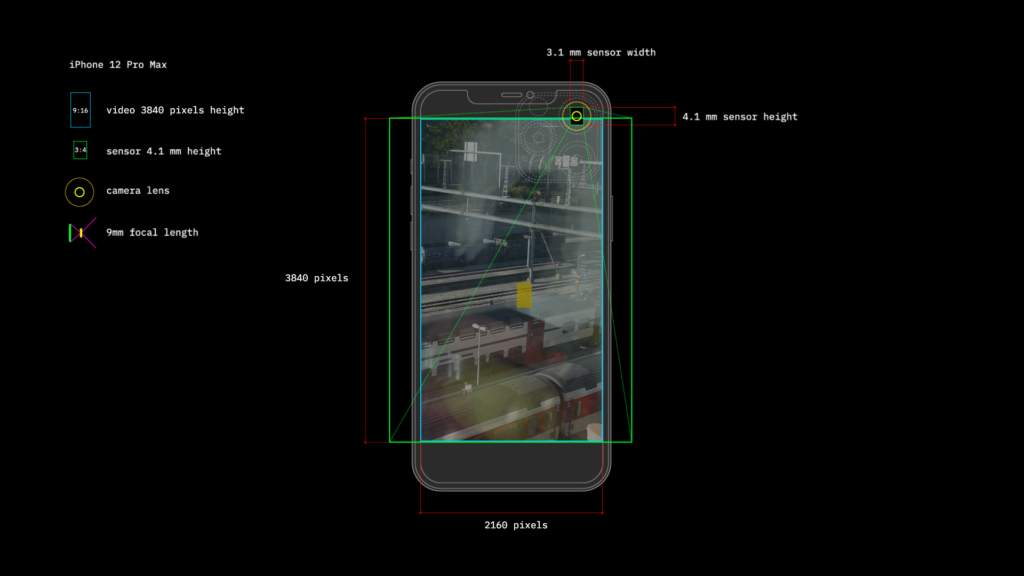
Using this data, we calculated the distance between the camera that captured the video and the objects of our analysis, i.e. Nzoy’s hands.
We used camera matching techniques in the software Unreal Engine to recreate the perspective of the video frame within a digital 3D environment that we have built based on real-world measurements taken at Morges station. This process involves positioning a virtual camera and adjusting its settings, such as focal length, sensor size and orientation, until it aligns precisely with the real-world view captured in the selected frame. This allowed us to accurately determine the position and angle of the original recording device by matching it to the digital 3D model of the environment.
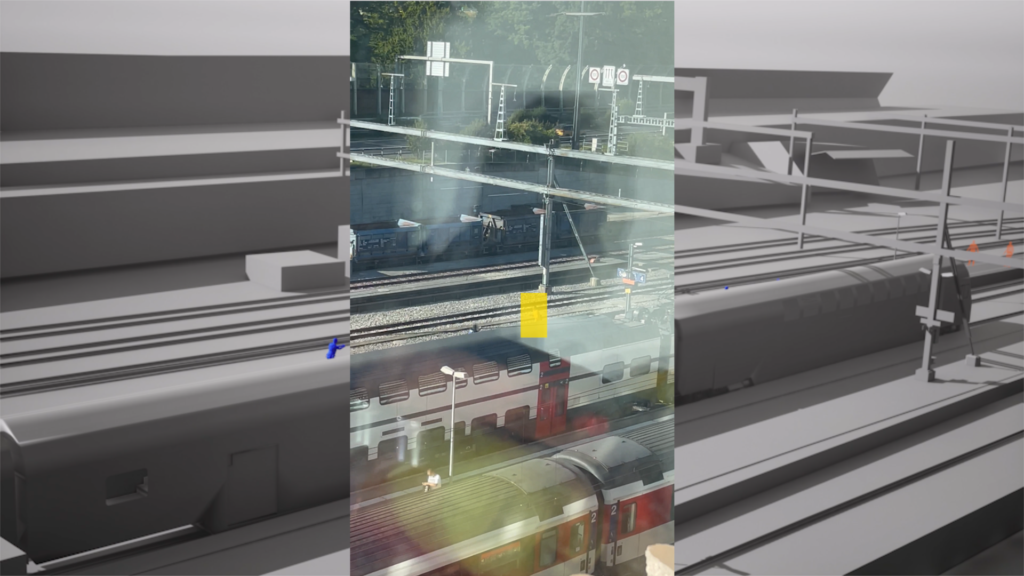
Using the same technique, we positioned Nzoy in this digital 3D space at the key video frame in which his hands are visible. This enabled us to measure the distance between the camera and Nzoy’s hands with a high degree of accuracy:
- Distance between the camera and Nzoy’s left hand: 62’300 mm (62,3 metres)
- Distance between the camera and Nzoy’s right hand: 62’900 mm (62,9 metres
To verify our calculation and assess the accuracy of our model, we performed a comparative analysis using two other objects visible in the same key video frame that form part of the train platform infrastructure, one object positioned closer to the camera than Nzoy and one further away. The calculated values being consistent with the in-situ measurements verified our pixel-to-real-world size calculation method. It allowed us to assert with a high degree of confidence that our pixel-to-real-world size calculation method is accurate within a small margin of error and thus robust enough for the purposes of our analysis.
- Distance between camera and comparative object A (lamp post pole diameter) 39’150 mm (39,15 metres)
- Distance between camera and comparative object B (platform sign): 65’500 mm (65,5 metres)
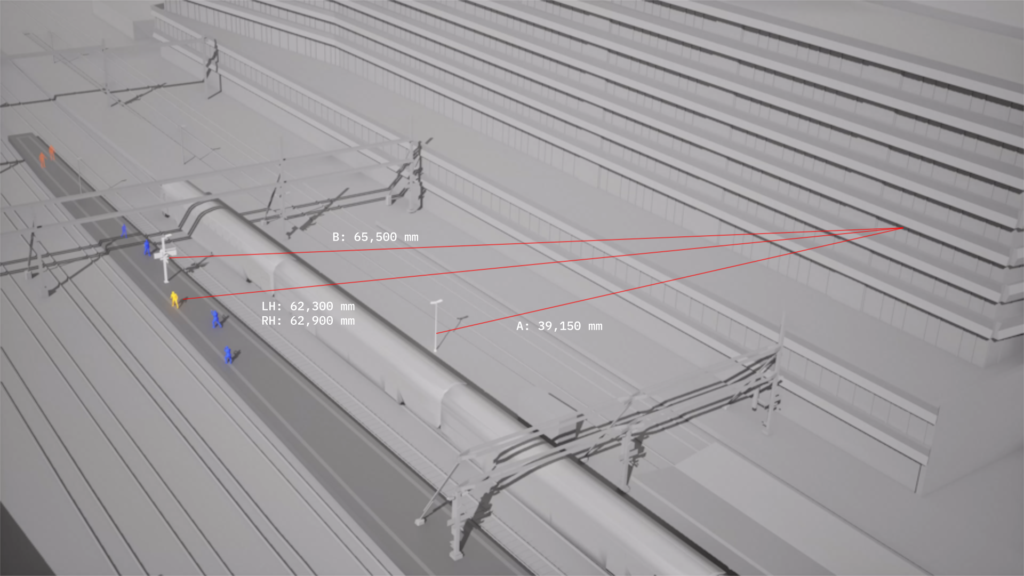
To assess the angle of the camera view, we calculated the vertical field of view (VFOV) using the following optical formula:
VFOV = 2 * tan-1 ( sensor height/ 2*focal length )
We input into the equation the known sensor height and focal length values corresponding to the telephoto lens of the iPhone 12 Pro Max that captured the video, as identified through metadata extraction and virtual camera matching in Unreal Engine. Substituting these values into the formula yielded a vertical field of view of ≈ 25.8 degrees.
Second, to know the real-world height of the image at a selected distance, we calculated the scene height at a distance, using the technical specifications of the camera and its calculated characteristics at the moment of the video’s capture:
scene height = 2 * tan (VFOV/2) * distance
Finally, to work out the size of one pixel, we divide the scene height by the vertical resolution of the image:
mm/pixel = scene height/vertical resolution
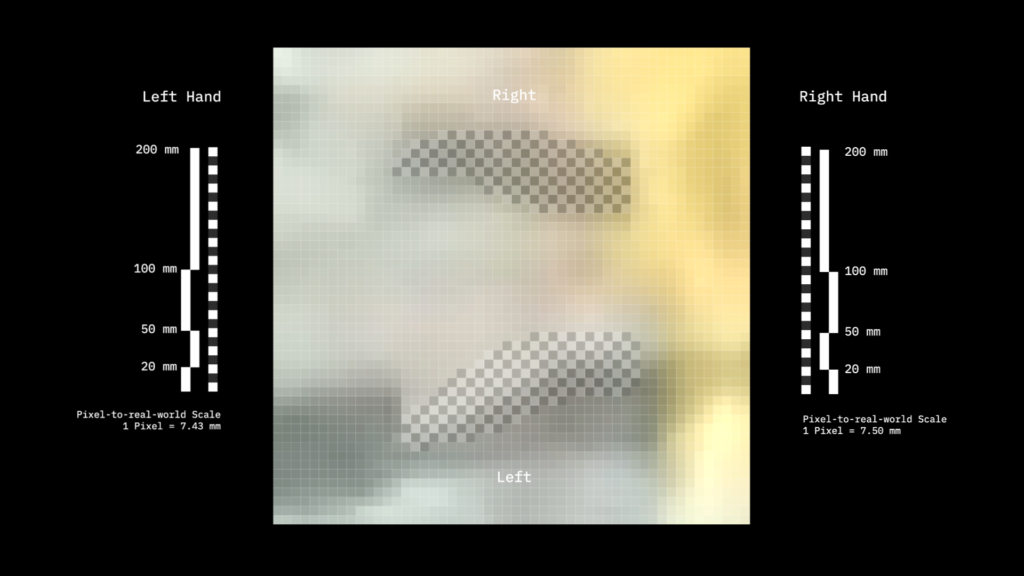
To ensure the reliability of our pixel-to-real-world conversion, we first tested our method on two comparative objects visible in the same key video frame: a lamppost and a platform sign. Both objects’ real-world dimensions have been calculated on site and are positioned at different depths relative to the camera. The calculated values were consistent with in-situ measurements, yielding a mean absolute error of ± 2.6 mm. This level of precision allows us to be confident that our model can accurately distinguish fine variations in size, including the difference between an open hand and a closed fist.
Application of the pixel analysis method
Having validated the method, we applied it to the key sequence where both of Nzoy’s hands are simultaneously visible. The measurements obtained were 19.7378 cm for the right hand and 19.7688 cm for the left hand. These values fall within the expected range for open hands and align closely with Nzoy’s recorded hand dimensions in the case file: 91 mm from the wrist to the metacarpophalangeal joint of the middle finger, and 136 mm from the wrist to the proximal interphalangeal joint. The correspondence between these measurements and the observed hand length in the video confirms that the visible shapes are consistent with Nzoy’s open hands.
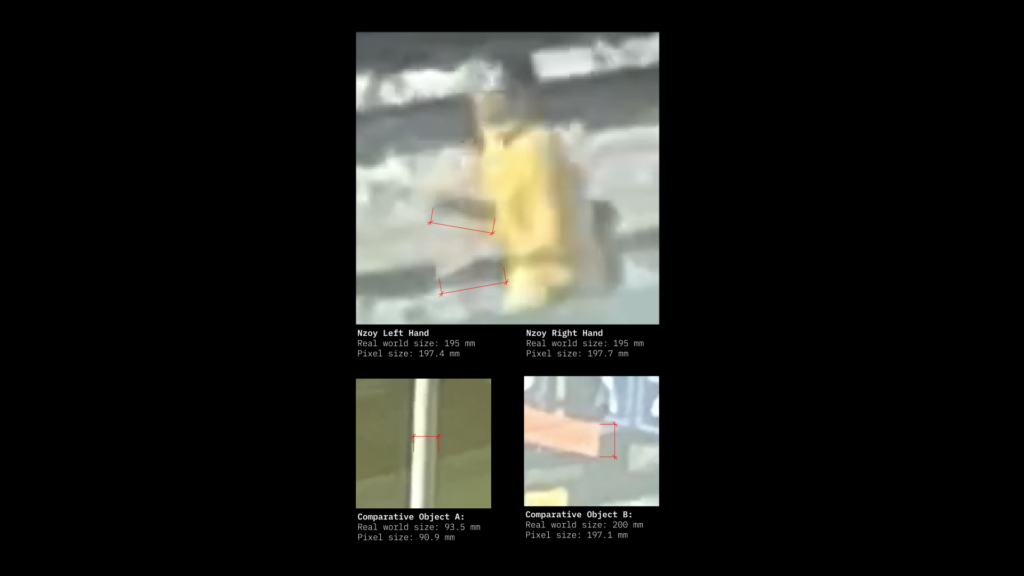
Once we confirmed that the objects in the frame were consistent in size with open hands, we examined the surrounding sequence of frames to analyse the motion of the hands over time.
This frame-by-frame analysis allowed us to observe the dynamic positioning and articulation of the hands. In the case of the left hand, the fingers appear fully outstretched. Just prior to the first shot being fired, the arm and hand move across the body, rising from the side of Nzoy towards his face. As he instinctively turns his torso in a defensive motion, the left hand can again be seen near his head, maintaining the shape and orientation of an open palm. Simultaneously, the right hand exhibits visible articulation at multiple finger joints, indicating that the fingers are extended rather than clenched. Across the sequence, the coordinated movement and joint articulation of both hands are consistent with the natural motion of open hands responding to the momentum of a stride. This is biomechanically inconsistent with a clenched grip, which would be required to hold such an object as a knife.
In summary, our analysis of the video evidence through our pixel analysis method demonstrates that both Nzoy’s hands were visible before the first shots, clearly opposing PO4’s statements that Nzoy’s hands were hidden “in [Nzoy’s] bag or behind it”.106“Pour vous répondre, j’ai vu qu’il tenait avec une main un sac, devant lui, contre sa poitrine. Je ne peux pas vous décrire ce sac. La main qui tenait le couteau était soit dans le sac, soit derrière celui-ci. Je ne la voyais plus.” Case file, 2007, p. 6. We also show that both hands were open at that moment, a position that renders it difficult – or impossible – to hold such an object as a knife. This supports witnesses’ statements as well as police officers’ claims that they did not see – or do not remember seeing – a knife in Nzoy’s hand at the moment of the shooting, and directly challenges the police investigation’s conclusions that Nzoy was attacking PO4, “running towards him while holding his knife in front of him.”107“Celui-ci, malgré plusieurs sommations, avait attaqué [PO4], en courant dans sa direction tout en tenant devant lui son arme blanche.” Case file, 4001, p. 48.
Where was the knife?
Having determined that Nzoy’s hands were open immediately before he was shot and that it is thus highly unlikely that he was holding a knife at that time, a question remains: where was the knife that was found under Nzoy after he was shot and lying on the ground during the unfolding of events? In the case file, two videos taken at different moments show an object that is most likely the knife:
The first moment occurs after the two shots. When Nzoy is rising after having fallen, it appears that he is picking something up from the ground.
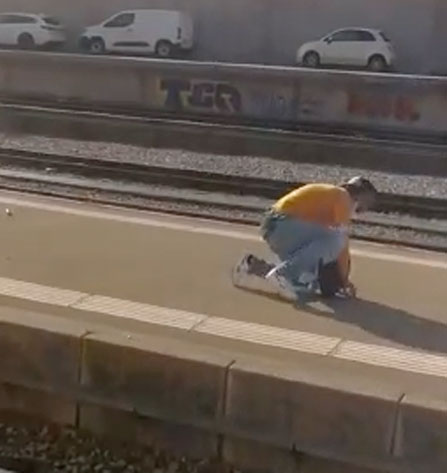
The second moment occurs after the third and final shot: as PO1 lifts Nzoy from his left side, a knife is found underneath his torso and taken away by PO3.

Based on the available evidence and our spatial and visual analysis, we can formulate the following most likely hypothesis for the path of the knife during the events:
- At 17:58:12, before the arrival of Patrol 2, Nzoy might have held a knife in his hands with his arms hanging loosely. It is unclear where he drew it from, but the presence of the knife is confirmed by multiple witnesses as well as PO1’s announcement via radio.
- Between 17:58:12 and 17:58:41, Nzoy drops the knife on the tracks and picks it up again, as recalled by witnesses and police officers. Then, Nzoy starts running towards the west end of the station. At that moment, witnesses and police officers either do not remember seeing a knife, assert that Nzoy’s hands were hidden behind or in his bag, or state that he was not holding a knife. Our visual analysis supports that during Nzoy’s run before the two shots, it is highly unlikely that he has anything in his hands. It is thus highly likely that before running, he put the knife in his bag or pocket.
- At 17:58:52, PO4 shoots Nzoy twice. Nzoy rolls on the ground, looks around and picks up something from the floor. It is highly likely that his fall led the knife to drop from his pocket or bag as a result of the fall.
- At 17:58:56, Nzoy stands up again, his hands at the level of his waist, probably holding his bag.
- At 17:59:01, PO4 shoots Nzoy for the third and last time.
- At 18:01:42, PO3 takes away a knife from beneath Nzoy’s torso after PO1 puts him on his side.
Trajectory analysis
In his police hearing, PO4 describes that Nzoy was walking and then running rapidly towards him,108“Il marchait de plus en plus rapidement vers moi. Au début, il marchait. Il était focalisé par moi, il me regardait dans les yeux, j’ai ressenti de la peur à ce moment-là. […] Là, il a commencé à marcher de plus en plus vite vers moi. C’est passé de la marche à la course en une fraction de seconde.” Case file, 2007, p. 6. that he was “focused on [him], that [he becomes] his target”.109“J’ai l’impression qu’à partir de ce moment-là, il s’est focalisé sur moi et que je deviens sa cible. Pour vous répondre, j’entends par là qu’il me fixait du regard. Il se dirige vers moi. […] D’abord, il s’est mis à marcher dans ma direction, ensuite il s’est mis à courir. Je fais plusieurs injonctions de toutes mes forces. Je lui demande de lâcher son couteau et de s’arrêter. Cela n’a aucun effet. J’essaie alors de gagner de la distance en reculant.” Case file, 2018, p. 8. PO3 also claims that Nzoy was heading towards him and PO4 rapidly with a “determined look and direction”.110“J’ai alors vu clairement l’individu, sur les voies, venir vers nous rapidement. Il avait un regard et une direction déterminés. Il était clairement menaçant.” Case file, 2002, p. 4. PO3 even emphasises in a second hearing that Nzoy “manifestly chose his path to direct towards [PO4], [and] was not hesitant”.111“C’est à ce moment que j’ai croisé son regard, respectivement son faciès. Il était vide, mais c’était celui d’une personne déterminée. Il s’est immédiatement tourné en direction de [PO4] et a commencé sa course dans sa direction. Tout cela de manière déterminée. Pour vous répondre, j’entends par “déterminé” que M. Wilhelm a manifestement choisi son chemin de se diriger vers mon collègue, il n’était pas hésitant.” Case file, 2021, p. 6.
Based on those statements, the police and the public prosecutor directly interpret Nzoy’s run before the shots as an attack towards PO4, thereby seeking to justify the use of his firearm. The police investigation indeed describes that PO4 “attempted to escape Nzoy’s attack by quickly retreating”, but ultimately fired two shots at him, momentarily stopping him as he fell to the ground. It further states that believing the threat had subsided, PO4 holstered his weapon, but Nzoy immediately stood up and resumed his “intense attack against PO4”. PO4 was then compelled to draw his weapon again and fire a third shot.112“[PO4], après avoir essayé en reculant rapidement de se soustraire à l’agression, avait fait feu à deux reprises, contrôlant l’effet de ses tirs en voyant tomber Wilhelm, touché par balle au côté gauche. À ce moment, [PO4], pensant que le danger était écarté, avait remis son arme dans son holster. Immédiatement après, et sans vraiment s’être arrêté, Wilhelm s’était relevé et avait repris son attaque intensément centrée sur le même policier.” Case file, 4001, pp. 48-49.
As videos from witnesses are all taken from the southern part of the station, the exact trajectory and intentions of Nzoy cannot be assessed with certainty due to the lack of different perspectives. We therefore conducted additional analysis to conclusively assess his trajectory and answer the following question: was Nzoy running towards PO4 in an attempt to attack him?
To do so, we produced a 2D and 3D spatial analysis of video footage to reconstruct the trajectories of both Nzoy and PO4. We assessed the directions, velocity and positions of all actors at crucial moments. Our analysis demonstrates that Nzoy’s advancement is not regular, and punctuated by stops and direction changes, which are directly influenced by the positions of the police officers around him. Nzoy’s movements are defensive and not directed towards attack.
We began by extracting all key frames from the video evidence that captured each distinct footstep of PO4 and Nzoy in the sequence. Using the architectural features of the platform and the known camera positions, we established a vanishing point to superimpose a perspective grid onto each frame.
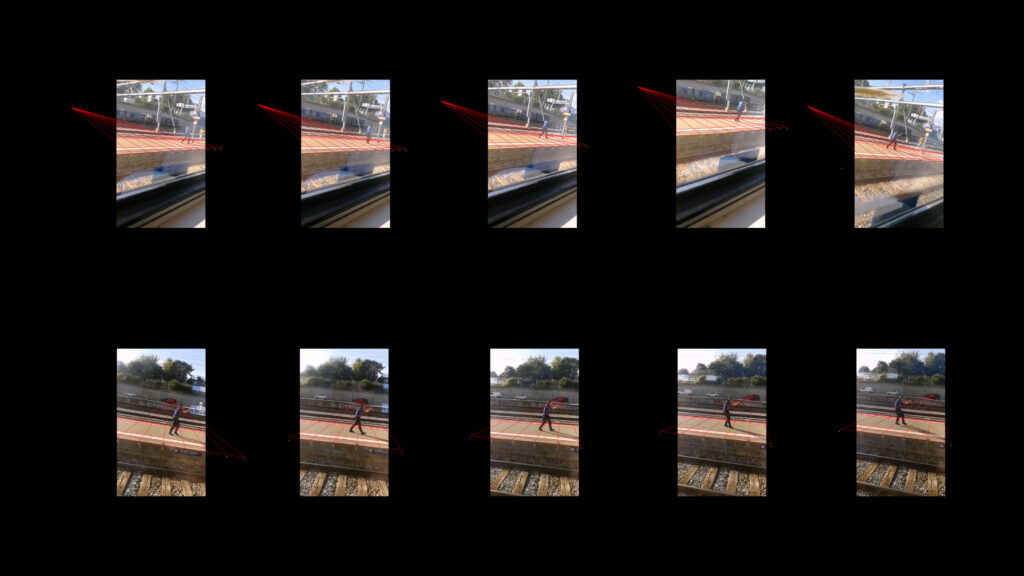
By numbering the grid lines, we were able to plot each of PO4’s and Nzoy’s footsteps onto a detailed map of the platform, allowing their movements to be animated in synchronisation with the video evidence. The systematic mapping of all footsteps taken by both PO4 and Nzoy against the sequence of video evidence provides a critical opportunity to closely examine a specific sequence of movements made by PO4.
Finally, we precisely modelled the scene using photo matching techniques in Blender combined with on-site measurements. The key moments of Nzoy’s run were reconstructed in 3D using a forensic photogrammetric workflow based on the three smartphone video sources. Each camera view was replicated in Unreal Engineby calibrating a virtual camera to match the original focal length, sensor size and perspective. Architectural features of the railway station were used as reference points to ensure both metric-scale and positional accuracy.
This approach offers us new perspectives by decentring the points of view while assessing clearly the positions and directions of all actors involved in the reconstructed environment. Rather than being confined to the southern-side video angle, we can rotate the scene, observe it from above, or even from the actors’ own lines of sight. The 3D environment therefore serves as a spatial layer that removes perspective bias, lens distortion and the occlusions present in the original videos. It enhances the understanding of the 2D reconstruction by making it possible to test whether the movements and alignments claimed in hearings – such as an attack trajectory – are geometrically plausible.
Our analysis divides the run into six key moments that we analyse chronologically below. Together with the detailed analysis of the footsteps, they demonstrate that Nzoy was surrounded by the four police officers, and that his run cannot be interpreted as an attack. Nzoy’s advancement is not regular, and punctuated by stops and direction changes, which are directly influenced by PO4’s presence in front of him as well as his use of a firearm, whether aiming or pulling the trigger.
The footstep analysis makes it possible to trace the movements of Nzoy and PO4 frame by frame, revealing a trajectory that diverges sharply from the account given by the police and the public prosecutor. From his first steps on the tracks, Nzoy’s motion is irregular and angled towards the western end of the platform, inconsistent with an attempt to attack. When he steps onto the platform from the train tracks and begins to run, his foot placement maintains this westward vector and even north and steady at some point. They do not align with PO4’s physical position, contradicting the claim that Nzoy was charging at him.
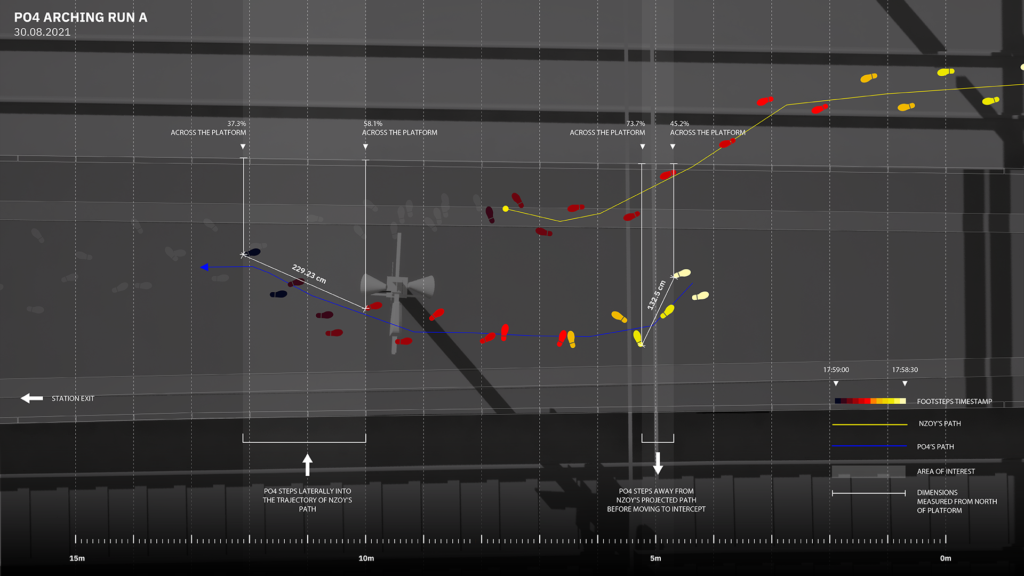
At the same moment, the mapped data shows PO4 shifting laterally and stepping into Nzoy’s projected route. This alignment of trajectories, later described in the criminal investigation as a “charge”, is created by PO4’s interception movement rather than by a change in Nzoy’s trajectory. Even in the seconds before the first shots, Nzoy’s shortened, hesitant steps and continued westward orientation point away from PO4, reinforcing that his motion was defensive, not offensive.
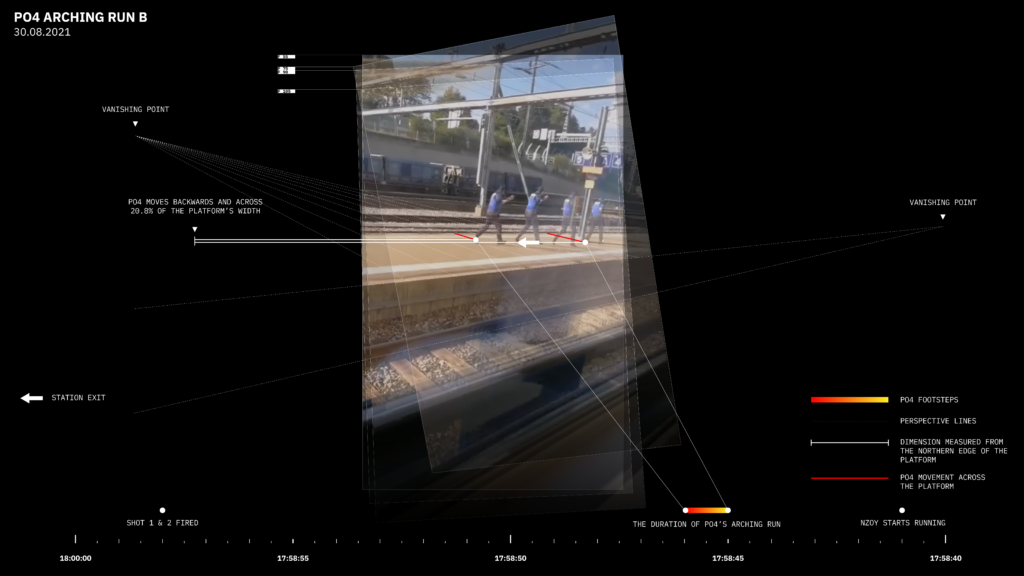
Although this 2D reconstruction exposes the inconsistency between the physical trajectory and the official narrative, its fixed perspective limits what can be seen. To fully verify these vectors and test the plausibility of the alleged attack, we turned to 3D reconstruction, which removes perspective bias and places the mapped steps into a spatial model where their true direction can be assessed. When the exact position of an actor is uncertain due to the absence of visual evidence asserting it, we applied a transparent filter to their assessed position.
The first key moment we analyse takes place at 17:58:42. According to the video evidence, Nzoy is on the tracks, PO1 and PO2 are on his left near the end of the platform with two railway workers, and PO3 and PO4 are on his right, towards the west of the platform in the direction of the platform exit. The 3D reconstruction of this moment shows that Nzoy is not in a position to pose a threat to anyone, being on the train tracks while all other actors are further away from him and at a higher level on the platform. Again, it is apparent that the perception of threat described by police officers in their hearings and the fact that PO1 already had his gun out at that moment were disproportionate with regards to the actual situation.
The 3D perspective confirms the 2D trajectory analysis: Nzoy’s relative height difference and lateral offset make any direct “charge” impossible at this stage. Viewing the scene from this line of sight in 3D highlights that Nzoy is below platform level and partially obstructed, reinforcing that he was not a threat to the armed police officers surrounding him.
The second key moment we analyse corresponds to the start of Nzoy’s run at 17:58:46. Our calculations show that right before the start of the run, PO4’s left heel shifts laterally across the platform: beginning at 45.2% across the platform (measured from the northern edge, indicating a relatively central body position) and ending at 73.7%, resulting in a 28.5% lateral shift towards the southern edge. PO4’s step, combined with his glance towards PO3, may have unintentionally signalled an opening: a retreating motion that created space towards the western side of the platform.
From Nzoy’s point of view in the 3D reconstruction, PO4 is on his left side, moving backwards with his gun partially concealed, while PO1 and PO2 are positioned further down on the eastern side of the platform, with PO1 aiming at him with his weapon. With two police officers behind him, a retreating PO4 creating space ahead, the westward route appears to become a viable path for Nzoy.
The 3D perspective adds a critical layer to the 2D footstep analysis. In the mapped trajectories, Nzoy’s steps are angled westward, away from PO4, supporting the argument of flight rather than confrontation. In the 3D model, the position of the lamppost between Nzoy’s projected route and PO4’s position emphasises this reading: it visually separates their trajectories and reveals that Nzoy’s movement does not target PO4 at all. Instead, PO4’s own lateral retreat creates the illusion of the reaction to a charge while actually opening the corridor Nzoy attempts to take.
The third key moment occurs at 17:58:47. PO4 took three large sidesteps, maintaining a lateral orientation with his back still parallel to the southern platform edge. As Nzoy steps onto Platform 4/5 from the tracks, PO4 reaches the platform sign infrastructure, passing its southern side and beginning to rotate his body to a more perpendicular orientation relative to the platform edge.
The following sequence is critical to the examination. At 17:58:46, PO4’s left heel is positioned just south of the platform sign, slightly further up the platform towards the exit. PO4 is relatively concealed by the platform sign impeding Nzoy’s view of him. At this moment, PO4’s left foot is calculated to be 58.1% across the platform from the northern edge. PO4 then takes one step backwards with his right foot, followed by two lateral sidesteps, landing his left heel at 37.3% across the platform at 17:58:47. This represents a 20.8% shift back towards the northern side, where Nzoy is coming from and heading. During this movement, his left foot moves 2’102 mm backwards and 896 mm laterally to the left.
This trajectory of motion is lateral and interceptive, positioning PO4 directly in the path of Nzoy’s route while pointing his gun at him. This again strongly contradicts the narrative that Nzoy was charging or attempting to attack PO4. PO4 clearly puts himself in Nzoy’s path, disrupting his run towards the western part of the platform. Nzoy’s route is consistent with a westward run towards the platform exit; it is PO4’s interception that creates the appearance of alignment. With PO1 aiming his gun behind him already, Nzoy’s shift appears to become defensive, in reaction to the sudden obstruction and PO2’s weapon pointed at him.
The fourth key moment corresponds to the analysis of Nzoy’s hands that we detailed above. It takes place at the moment PO4 shoots him twice. It allows us to view the same scene from the point of view of PO3, who has Nzoy in front of him, with both hands visible. While we demonstrated in our pixel-video analysis that it is highly unlikely he held a knife at that moment, we can further confirm that Nzoy had not adopted a threatening or attacking posture, nor did he make any movement resembling a charge. This moment is critical because it visually contradicts the statements describing Nzoy as attacking PO4. This 3D reconstruction eliminates perspective bias and confirms that his body alignment and hand position are inconsistent with an attack. When tied to the 2D footstep reconstruction, this conclusion becomes stronger. The mapped steps show Nzoy’s movement continuing on a westward vector, irregular and defensive rather than aggressive. The 3D perspective enhances this by adding body orientation and hand visibility to the trajectory data, creating a composite picture that supports a defensive response and undermines the narrative of an attack.
The fifth key moment occurs after the first two shots were fired at 17:58:56. Nzoy falls down on the ground, rolling forward, and ends up on his knees. PO1 and PO2 are advancing towards him, PO4 holstering his gun and PO3 still pointing his firearm at him. At this moment, Nzoy has been shot twice and is surrounded by four police officers. In a video of that moment, Nzoy seems to pick something up from the floor. While the object is not clear on the video, we can hypothesise based on our analysis that it was the knife that fell out from his bag or pockets and that was later found underneath him. The video evidence shows that when realising that the knife is on the ground, he picks it up and keeps his hand at the level of his waist, not “brandishing” it as put forward in the case file.
The sixth and last key moment we analyse comprises the third and final shot fired by PO4 at Nzoy at 17:59:01. Nzoy stands up and continues his run towards the western part of the station. The 3D reconstruction of both Nzoy and PO4 makes the direction unmistakable: Nzoy’s trajectory is aimed at PO4’s left side, not towards him. The 2D footstep analysis reinforces this conclusion. The orientation of Nzoy’s feet in the mapped frames points westward, away from PO4’s line, and never pivots into an attack. Together, the 2D and 3D reconstructions converge on the same point. Nzoy’s movement in this final moment continues the same westward vector established from the beginning of his run. The geometry and body orientation leave little doubt: this was not an attack trajectory.
By combining the 2D trajectory with the volumetric 3D reconstruction, we obtain a consistent spatial picture of Nzoy’s trajectory in relation to the police officers: Nzoy’s movements were irregular, defensive and directed towards escape rather than attack. The brief moment where Nzoy and PO4 appear aligned is created by PO4 stepping into Nzoy’s route. This lateral interception produces the illusion of a charge, but the trajectory data shows that Nzoy’s movement was actually angled towards escape. This combined method allows us to state with high confidence that the perception of an attack is not supported by the geometry of the scene.
Sequence 4: Failure to offer aid in an emergency
The fourth and last sequence we analyse takes place between 17:59:01, after the third and last shot is fired at Nzoy by PO4, and 18:31:00 when his death is pronounced. During this sequence, Nzoy is on the ground, clearly injured and in need of care. PO4 leaves the scene while PO1, PO2 and PO3 undertake several actions that we analyse in detail. Through a combined analysis of video and audio evidence, police officers’ statements, police training manuals and medical expertise offered by the Independent Commission, we demonstrate that after the shots, the officers did not share any relevant information and prioritised security handlings, such as a safety search and handcuffing instead of first aid. Our analysis further demonstrates that it is only after six minutes that a nurse, who was a witness to the scene, intervened spontaneously and was allowed to provide first aid.
After the public prosecutor opened an investigation for homicide against PO4 in 2021, in 2022 Nzoy’s family’s lawyer requested the extension of the proceeding to all police officers for failure to offer aid in an emergency. Despite the public prosecutor’s use of our 2023 preliminary analysis, he refused this extension and issued an abandonment of the proceedings for homicide and a no-proceedings order for failure to offer aid in an emergency in November 2024. In May 2025, the Criminal Appeals Chamber of the Vaud Cantonal Tribunal cancelled this no-proceedings order and instructed the public prosecutor to open a proceeding against PO1, PO2 and PO3 for failure to offer aid during an emergency.113Arrêt Du 14 Mai 2025, PE21.015154-LML, https://www.findinfo-tc.vd.ch/justice/findinfo-pub/internet/search/result.jsp?path=10348518&title=D%C3%A9cision%20/%202025%20/%20254&dossier.id=10277078&lines=10
Here, based on the evidence published in our preliminary analysis, we first address the lack of relevant information shared by the police officers. Then, we detail the sequence of events and analyse it in light of police training manuals to highlight the inadequacy of police officers’ actions. Together, our analysis not only reveals the police’s legal and professional faults, but also highlights a disregard for Nzoy’s life.
Insufficient information exchanged
When PO4 shoots Nzoy for the third and final time, Nzoy falls face down, both hands under his torso. In the minutes that follow, communications are conducted mostly by PO3, who appears to be taking the lead in the intervention.
PO3 announces that shots were fired via radio and demands an ambulance.114Case file, 1018. PO3 then states that Nzoy still has a knife, that he is on the ground and conscious.115Case file, 1019. Over radio communication, a person from the police dispatch center informs that an ambulance and a car with one or more medical doctor(s) from the Mobile Service of Emergency and Reanimation (SMUR) are on their way and asks for more information.116Case file, 1020. We can therefore reasonably assume that the emergency services engaged in a high-priority intervention with immediate departure and priority signals, for an emergency with a likelihood of affected vital functions.117Canton de Vaud, “Règlement Sur Les Urgences Préhospitalières et Le Transport Des Patients (RUPH),” accessed July 28, 2025, art. 4. In such a context, the information given to emergency services is crucial, not only to prepare them before departure, but also to help them assess the situation upon arrival on site and adjust their response as the situation evolves. In response to the request for more information, PO3 says, “I don’t have more information, a man of colour, he is on the ground.”118“J’ai pas plus d’infos, un homme de couleur, il est au sol.” Case file, 1020. Then two other communications follow when PO3 is asked if there is still a threat, to which he answers, “no, I don’t think so”,119“Non, je crois pas attends, merci.” Case file, 1021. and another later on when PO3 informs that Nzoy has been handcuffed.120“L’individu au sol, il est menotté, je répète, il est menotté.” Case file, 1029.
While the case file only contains excerpts of radio communication selected in the context of the criminal investigation (something that we address in Chapter 2), it is clear that the information exchanged over radio is insufficient to offer a clear understanding of the situation to other police officers and emergency services. In these communications, there is no direct mention of the fact that Nzoy is wounded. PO3 rather describes Nzoy as a “man of colour”, information not only irrelevant in the emergency of a wounded person in need of urgent medical care, but also representative of the precedence given to racialisation over health and care. At the same time as the insufficient exchange of information, not one of the police officers attempted to seek more information about Nzoy’s health, by either checking his vitals or simply talking to him.
Security measures instead of first aid

Police officers receive a “Tactical First Aid” training, which consists of providing first aid while assessing the risks and dangers of a situation or an environment deemed hostile. Referring directly to terrorist attacks and extraordinary situations, the police training manual puts forward that in this context, security takes precedence over first aid: “For law enforcement agents, managing the situation in question is always the main objective, while providing medical care to injured persons is a secondary goal.”121Institut suisse de Police, ‘Premiers Secours Tactiques (Formation Continue)’, Editions ISP, 2021, 19. While Nzoy, wounded and laying face down on the ground, did not represent a danger, with PO3 even mentioning on the radio that there was no threat, police officers continued to conduct security measures. PO1 and PO3 started by using their feet to remove Nzoy’s hands from below his torso, with PO3 pressing down on his wrist with his foot and ordering PO2 to handcuff him.
None of the officers repositioned Nzoy’s body or checked for consciousness or circulation, contrary to police first aid guidelines.122“FR_Les_instructions_de_premiers_secours_07_2019.Pdf,” https://votrepolice.ch/app/uploads/FR_Les_instructions_de_premiers_secours_07_2019.pdf. This position may have hindered respiratory capacity,123Gary M. Vilke, “Restraint Physiology: A Review of the Literature,” Journal of Forensic and Legal Medicine 75 (October 2020): 102056, https://doi.org/10.1016/j.jflm.2020.102056. especially since the handcuffs remained in place after the start of cardiopulmonary resuscitation.124Emily Zentner | The California Newsroom and Lisa Pickoff-White | The California Reporting Project, “Deadly Restraint: Despite Decades Of Warnings, Police Continue Holding People Facedown,” LAist, February 28, 2024, https://laist.com/news/criminal-justice/deadly-restraint-despite-decades-of-warnings-police-continue-holding-people-facedown. Although the police investigation states that police officers “placed [Nzoy] in a lateral safety position”, thus associating it with a first-aid gesture, the recovery position, it appears instead to have been carried out solely for security reasons. PO1 states in his hearings that he “lifted the left side slightly by a few centimeters so that [PO3] could seize and secure the bladed weapon.”125“Avec [PO3], nous avons dégagé ses mains et, comme je n’ai pas vu l’arme, j’ai soulevé le côté gauche de quelques centimètres pour que [PO3] saisisse et sécurise l’arme blanche.” Case file, 2005, p. 5. He further states that he “patted him down” and performed “a security search”,126“On l’a palpé dans le sens où on a fait une fouille de sécurité. Je me souviens que je n’ai pas vu de sang au niveau du sol. Je ne l’ai pas palpé au niveau du centre masse et ailleurs pour constater une éventuelle blessure.” Case file, 2020, p. 11. and that he was “only thinking about the fact that he needed to be brought under control so that we, as well as the other people at the station, would be safe”.127“Je pensais seulement au fait qu’il devait être contrôlé pour que nous soyons en sécurité, ainsi que les autres usagers de la gare. Pour vous répondre, je n’ai pas le souvenir non plus d’avoir constaté ou pas par la suite qu’il respirait.” Case file, 2020, p. 12, Furthermore, the medical analysis conducted by the Independent Commission notes that placing him in this position and keeping his arms restrained behind his back may have further impaired his breathing capacity, especially since the handcuffs remained in place.
Four minutes and 40 seconds after the last shot was fired, a nurse who witnessed the scene from a nearby train intervened spontaneously. In his statement, he says that at his arrival, “[PO3] signalled me to remain at a distance. I identified myself and he told me the scene was not secure. I had already seen that the victim was in cardiac arrest.”128“PO3 m’a fait un signe de rester à distance. Je me suis identifié et il m’a dit que la scène n’était pas sécurisée. Moi, j’avais vu que la victime était en arrêt cardiorespiratoire].” Case file, 2009, p. 3. Here again, the notion of security and threat appears in a troubling manner. Almost five minutes after Nzoy was shot, and while he was lying on the ground handcuffed, PO3 signalled to the nurse that the scene was not secured. Coincidentally, PO3 and the nurse knew each other, which might have directly influenced PO3’s decision to let him intervene. Five minutes and 40 seconds after the shots, the nurse touched Nzoy for the first time, and it is only between six minutes and six minutes and 41 seconds after the shots that a video shows the nurse giving CPR to Nzoy. While the video shows PO3 next to the nurse covering the bullet wound, the notion of security and threat continues to dominate the process of first aid. The video shows that PO3 only removed the handcuffs while the nurse was performing CPR, almost seven minutes after the last shot. In his statement, PO3 says: “I did a security check during [the nurse’s] CPR. As there was no other object, I decided to remove the handcuffs.”129“J’ai fait, pendant le massage cardiaque de [l’infirmier], une fouille de sécurité. Comme il n’y avait pas d’autre objet, j’ai décidé de le démenotter. C’est moi qui l’ai démenotté. J’ai décidé de faire ça car sinon le massage cardiaque n’était pas optimal, et comme il n’avait rien sur lui, ce n’était pas un problème d’enlever les menottes.” Case file, 2002, p. 6. The nurse describes the same scene: “[PO3] realised the situation was serious and asked if he should remove the handcuffs. I told him to handle it because I didn’t want to make that decision. [PO3] removed them.”130“[PO3] a compris que la situation était grave et a demandé s’il fallait enlever les menottes. Je lui ai dit de se débrouiller car je ne voulais pas prendre cette décision. [PO3] l’a démenotté.” Case file 2009, p. 3.
In his no-proceedings order of November 2024, the public prosecutor, using the forensic medical report, states, a posteriori, that the third shot was lethal in the subsequent five minutes to justify that one of the legal conditions for non-assistance is not filled. As stated in the Criminal Appeals Chamber Appeal Chamber decision, “such an approach is problematic as it leads to assessing the need for assistance based on what is known in hindsight, rather than on what the officers could perceive at the time.”131Arrêt Du 14 Mai 2025, PE21.015154-LML. In other words, an autopsy can explain the causes of death, but it can in no way justify a behaviour or the absence of action, since police officers involved cannot know its outcome. In light of the elements presented above, it appears clear that police officers had sufficient means to know that Nzoy’s life was at risk and immediate care was required. By concentrating on security long after any potential threat had been settled, the police failed to offer aid in this emergency situation.
Conclusion
Our detailed analysis of the sequences of events that unfolded at Morges station demonstrates that the police officers’ actions, as well as the biased perception of Nzoy as a threat, rapidly led to the engagement of disproportionate and coercitive means and the subsequent prioritisation of security measures over first aid and care.
It indicates that Nzoy’s behaviour showed clear signs of anxiety, confusion and mental distress, also perceptible by non-experts as verified by the multiple witness statements. The arrival of the first police patrol clearly triggered a change in his behaviour, raising his stress and anxiety levels. All the while, officers did not adapt their intervention in order to prevent escalation as required by their training manual.132Institut suisse de Police, “Sécurité personnelle,” 2015, 34. While PO1 and PO2 both put forward that it was the presence of a knife that changed the situation for them, our analysis shows that the engagement of firearms, even in “discreet positions”, and their use later on by PO4, clearly escalated the situation in a disproportionate manner.
Regarding the contentious presence of the knife, statements are congruent with the fact that Nzoy did have a knife in his hands shortly after the arrival of Patrol 1 and that at the moment he started running, the knife was not visible. Our analysis demonstrates that at the moment of his run, before the first two shots, it is highly unlikely that Nzoy had anything in his hands. The knife found underneath him after the last shot most likely fell from his bag or pockets at the moment of his fall, and that he kept his hands at the level of his waist until he was shot a third and final time. Furthermore, our analysis challenges the depiction of Nzoy’s run as an attack on PO4. We demonstrate that Nzoy’s trajectory was not determined and that he was not moving directly towards PO4, but rather laterally, with multiple changes of direction directly influenced by PO4’s movements in his trajectory.
Finally, we demonstrate that the police officers involved prioritised security measures instead of offering Nzoy aid in a clear emergency situation, while he was wounded and did not pose any threat, until a nurse who witnessed the scene provided first aid after six minutes.
These results indicate that Nzoy’s behaviour did not constitute a threat that justified the use of lethal force. Instead we demonstrate that the actions and inactions of police officers led to Nzoy’s death, which could have been avoided. Our analysis not only reveals direct failures in the conduct of the intervention that led to inflicting lethal force, but also a disregard for Nzoy’s life that led to inflicting lethal abandonment.
The killing of Nzoy was brutal, yet it has been framed as a rational response to an imagined and constructed threat, thereby legitimising the violence Nzoy endured. As put forward by his sister, “his death was a tremendous pain and shock for everybody who knew him and for some who did not. But seeing police officers using their feet to move parts of my brother’s body, and not trying anything to save his life is pure violence.”
Both the unfounded perception of Nzoy as a threat and the disregard for his life raise the question of how the perception of Nzoy as a “man of colour” – and thus the role of race – played in shaping the (in)actions of police officers, a question we respond to in Chapter 3. Before doing so, however, we discuss in Chapter 2 the deficiencies of the criminal investigation revealed by our thorough reconstruction of events.
CHAPTER 2. DEFICIENCIES IN THE CRIMINAL INVESTIGATION: MISHANDLING AND MISSING MEANS OF PROOF
In this chapter, we continue our analysis at the scale of the event of Nzoy’s killing and focus specifically on the deficiencies and evidentiary gaps in the criminal investigation. In the course of our counter-investigation, while critically working with data and analysis collected and produced by the criminal investigation, we did identify several deficiencies. These deficiencies not only led to erroneous or partial depictions of events, which we present in detail in Chapter 1, but also substantially hindered efforts to bring the truth about Nzoy’s killing to light. Given this state of affairs, we went beyond establishing the facts of the event to also investigate the criminal investigation itself, analysing the practices at stake despite their opacity and uncovering multiple procedural flaws. In other words, we conducted an investigation into the investigation itself.
In this context, this chapter analyses the deficiencies of the criminal investigation, which crystallise around the collection, processing and analysis of data. When examining the case file, our initial impression was that the events were exceptionally well documented compared to other cases in Switzerland, particularly because it took place during rush hour, on a weekday, in a train station. But as we reviewed this extensive material, we quickly realised that what appeared to be a profusion of data was actually functioning as a veil, obscuring the uncertainties surrounding the case, the grey areas, the missing information and the mishandling of data.
To reveal the deficiencies of the criminal investigation, we first analyse means of evidence that were altered through the erasure of their metadata, critically hindering their use. We further uncover that radio communications are missing from the case file, leaving significant unknowns about the actions of police officers and their potential consequences. We finally examine a central witness hearing and reveal that his statements contain major inconsistencies that were not detected by police investigators, questioning the effectiveness of the criminal investigation and leaving crucial questions unanswered.
While Nzoy’s family and their lawyer, with the help of Border Forensics and the Independent Commission, repeatedly drew attention to issues in the legal proceedings, the public prosecutor and the cantonal police systematically failed – or refused – to address them, constructing in this sense clear barriers to accountability. While the Criminal Appeals Chamber of the Vaud Cantonal Tribunal upheld the position of Nzoy’s family, these deficiencies have clearly impeded the effective implementation of a relevant, fact-based investigation and are symptomatic of broader structural issues of police impunity, which is sustained by a structure that enables and reinforces it.133Arrêt Du 14 Mai 2025, PE21.015154-LML; RTS, “Le Ministère public vaudois doit rouvrir son enquête sur la mort de Nzoy,” rts.ch, May 28, 2025, https://www.rts.ch/info/regions/vaud/2025/article/affaire-nzoy-le-tribunal-cantonal-ordonne-la-reouverture-de-l-enquete-28897641.html; Rohit Jain, Ethnographischer Bericht zum Prozess gegen M. (2016), https://www.stop-racial-profiling.ch/site/assets/files/1056/ethnographischer_bericht_zum_prozess_gegen_m.pdf.
Mishandling of evidence and metadata erasure
A detailed reconstruction of events in space and time is crucial to understanding them in their entirety and analysing the actions of multiple actors. In our investigations, we use the metadata of audio and video files as well as a sound/image analysis to place them precisely in the events’ chronology. When doing so in the context of this investigation, a significant portion of the videos, photos as well as audio metadata were altered, critically hindering their use. While the case file – and more precisely the police report in which those data are used – does not contain precise information about the collection, transmission and storage procedures, we can put forward some technical hypotheses to explain this alteration.
First, different videos and photographs were transmitted – most likely from the witnesses to police officers – via the messaging app WhatsApp, which reformats the videos, alters their quality and erases their original metadata, thereby compromising a detailed reconstruction of events and necessitating additional measures to provide an accurate timeline.
Then, modified versions of some videos without metadata were added to the case file. They indeed have a modified name and the file does not contain the date and time of the video creation.
As mentioned earlier in the report, the Independent Commission and the Alliance Justice4Nzoy had to fill this gap by organising a public call for data in Swiss train stations as well as on its website.134Justice4Nzoy, “Did You See Anything?”, https://justice4nzoy.org/upload/ Thanks to this important action, in June 2023, an eyewitness anonymously sent a new video that was partly featured in a media reconstruction but was not in the case file.135Rumpf, “Il est resté couché bien cinq minutes, menotté, avant d’être secouru.” As the shared file contained metadata, we managed to situate it precisely on our timeline. Based on this new information, we also conducted a visual analysis to match it to other videos without metadata. This allowed us to situate precisely all videos on a timeline.

Furthermore, we learn from transcripts of police hearings that different practices after data transmission are exercised. Two witnesses indeed mention in their hearing that they deleted a video and respectively an audio recording in front of police officers after transmission, most likely upon the request of police officers:136I sent the video to the [newspaper] 20 Minutes and to one of your colleagues who arrived on the scene shortly after the incident. I should note that I deleted the video in front of your colleague after sending it to them.” Case file, 2001, p.3-4; “No, I don’t have any images or photos/videos. I only have the voice message I recorded for your department. This audio recording took place today at 17:58. I agree to send you this recording by email. I am deleting this excerpt right now.” Case file, 2006, p. 4.
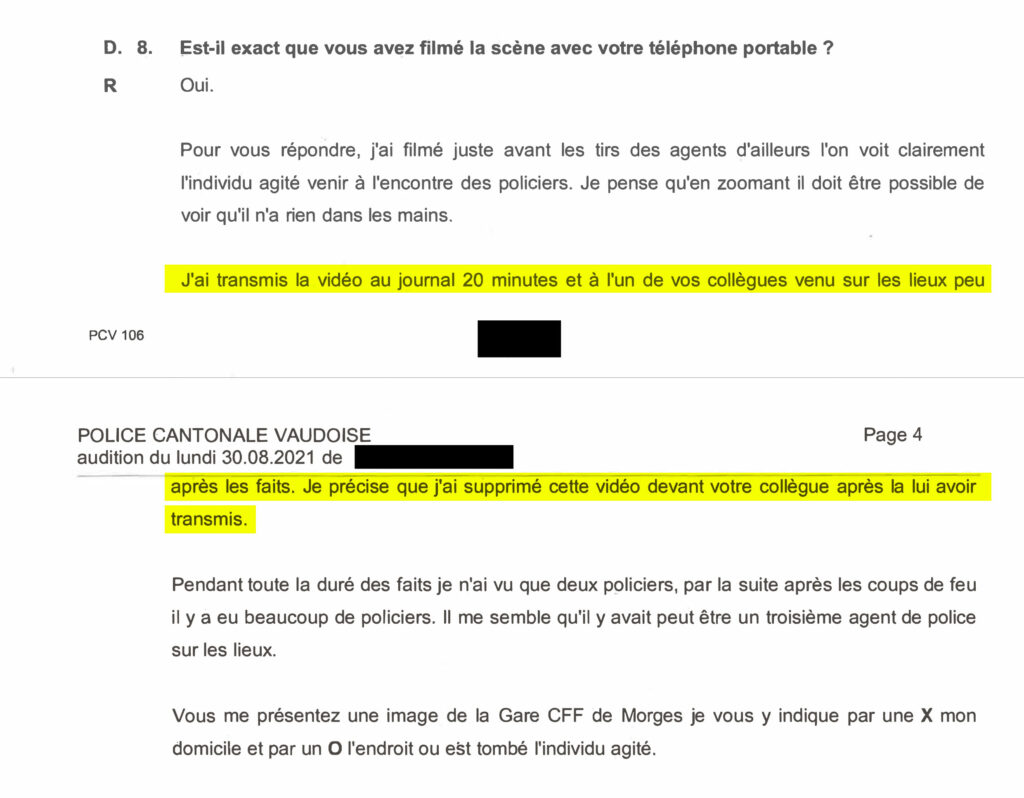
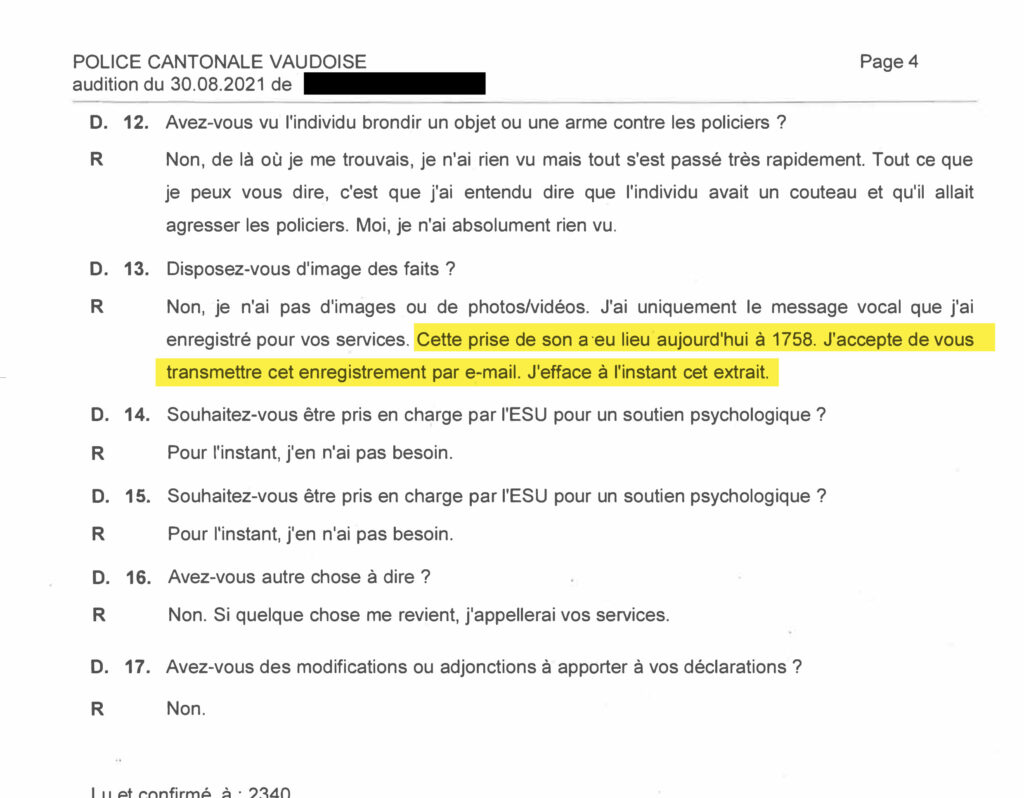
Two other witnesses are also asked not to circulate a photo and a video they have of the event:137“Do you have any images, videos, or audio recordings of the incident?” “Yes, I have a photo that I took from a distance when they were performing CPR.” “The witness showed the officers present a blurry photo of the police on the platform after the incident. He was asked to keep it and not to share it.” Case file, 2004, p. 4; “I filmed the scene with my phone, not for long. I only filmed the scene that you recovered. I sent it to my family and some friends. I sent it on Snapchat but I didn’t put it in my story. Therefore, only the people to whom I sent this video could see it. I still have it and I will not share it any further.” Case file, 2012, p. 4.
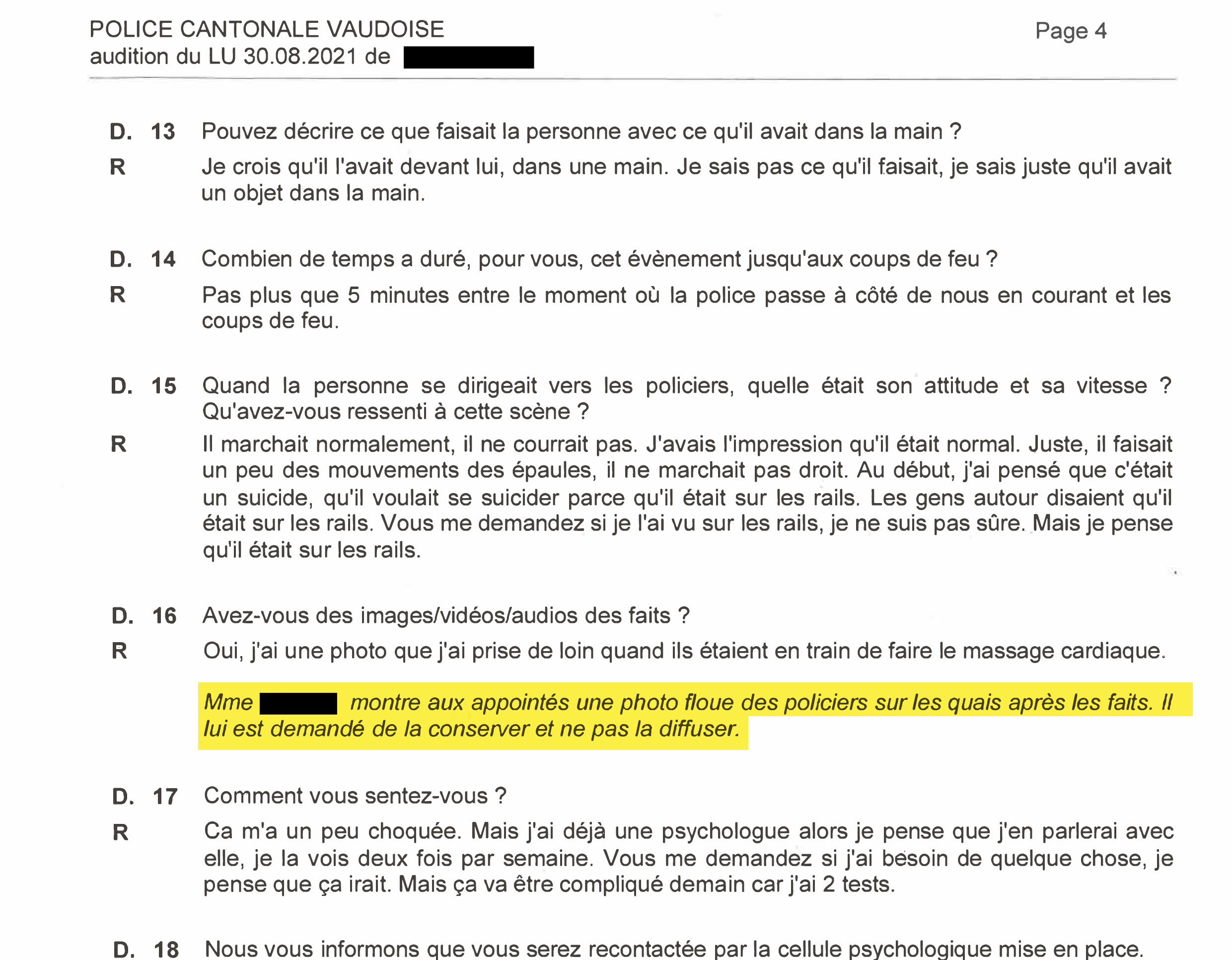
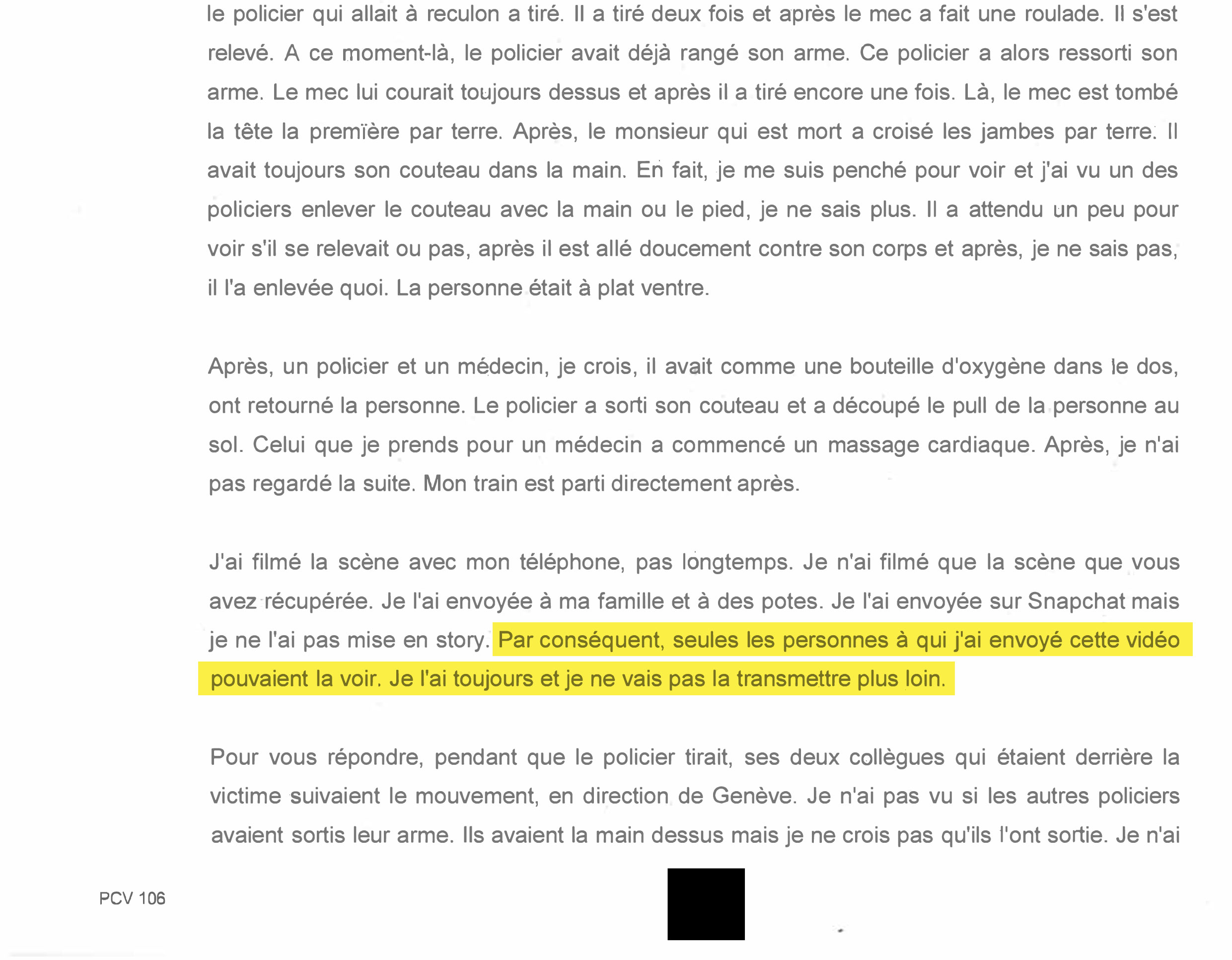
While the three hearings mentioned above were conducted by different police officers and while no specific information about the conduct of police hearings and police investigations are available in the case file, definite conclusions on the reasons behind those requests cannot be drawn. Nonetheless, although filming police officers in the public context of their activities is not forbidden in Switzerland, these requests to delete or not to disseminate videos, photos or recordings seem consistent with the control that the police tries to exercise about the type of information diffused on their actions and activities.138Amnesty International, “Guide manifestations: Questions réponses,” accessed July 7, 2025, https://www.amnesty.ch/fr/themes/droit-de-manifester/guide-manif/questions-reponses-ii; Christian Flueckiger, Préposé à la protection des données et transparence Jura-Neuchâtel (Le préposé à la protection des données et à la transparence (PPDT), 2015), https://www.ppdt-june.ch/fr/PPDT/Le-PPDT/Le-prepose-a-la-protection-des-donnees-et-a-la-transparence-PPDT.html; RTS, “Quels sont vos droits en cas de contrôle de police?,” rts.ch, October 12, 2021, https://www.rts.ch/info/suisse/12557096-quels-sont-vos-droits-en-cas-de-controle-de-police.html.
Missing radio communications
The case file contains 13 distinct audio files of police radio communications of varying lengths. Their metadata do not show the time the communications were made, but this information is reported in the file names. During the reconstruction of the timeline of events for our preliminary analysis in 2023, we matched the audio files to videos where police officers are visibly using their radio. This process not only allowed us to corroborate the time recorded in file names but also revealed that the case file does not contain the entirety of the police radio traffic that unfolded during the events. Instead, the entirety of the radio communications recordings has been edited and selectively added to the case file as edited individual files.
In our preliminary analysis published in November 2023, we analysed two moments where we could see PO3 reaching towards his microphone with his hands and leaning his head towards it, at 18:00:41 and at 18:02:02, and could not find corresponding radio communications in the case file at the time.
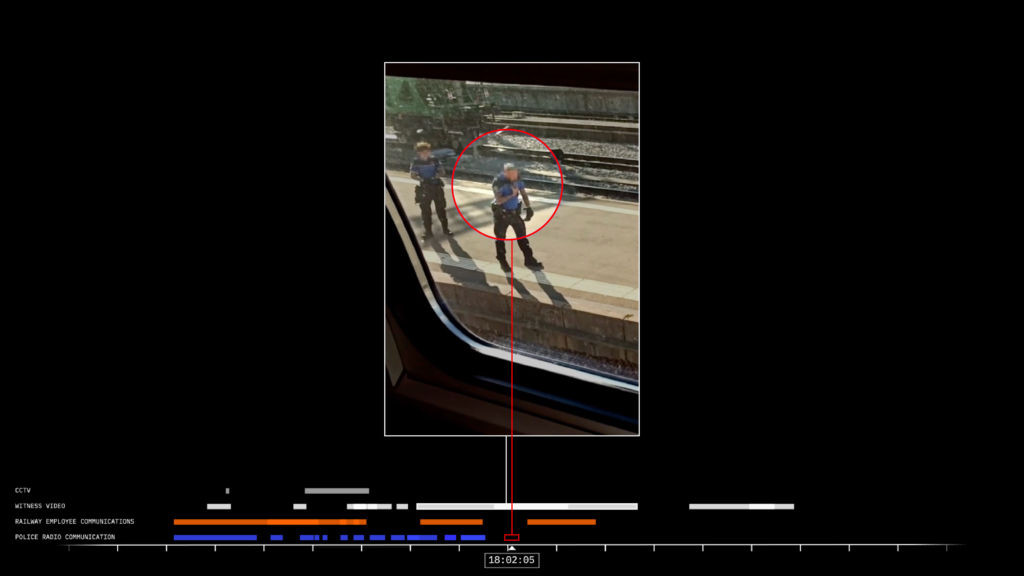
As radio communications are essential to establishing the type of information the police officers involved had requested and communicated, Nzoy’s family lawyer communicated these issues to the public prosecutor in November 2023. The prosecutor then required the cantonal police to “[d]etermine whether the radio traffic transmitted following the investigation mandate of August 31, 2021 is complete, and, if applicable, provide the missing radio communications”. In June 2024, the cantonal police produced a short report responding to our findings, stating that:
“the entirety of the radio traffic that took place between 17:55:09 and 18:01:02 has already been added to the file. Based on the video edit produced by “Border Forensics”, and regarding the first audio recording reported as missing, it is indeed noticeable in the footage that the officer moves his head closer to his [radio]. This situation may be explained by the fact that at that precise moment, other conversations were likely taking place concerning other interventions, and that he was simply listening attentively, either waiting for instructions or preparing to communicate himself. As for the second sequence, which allegedly was not transmitted, it turns out that it took place after 18:01:02. Therefore, as mentioned above, the audio recordings provided only cover the time frame between the first call made to the Command and Dispatch Centre and the moment Mr. Wilhelm was handcuffed on the ground. Since the ‘missing’ sequence occurred later, it was indeed not transmitted.”
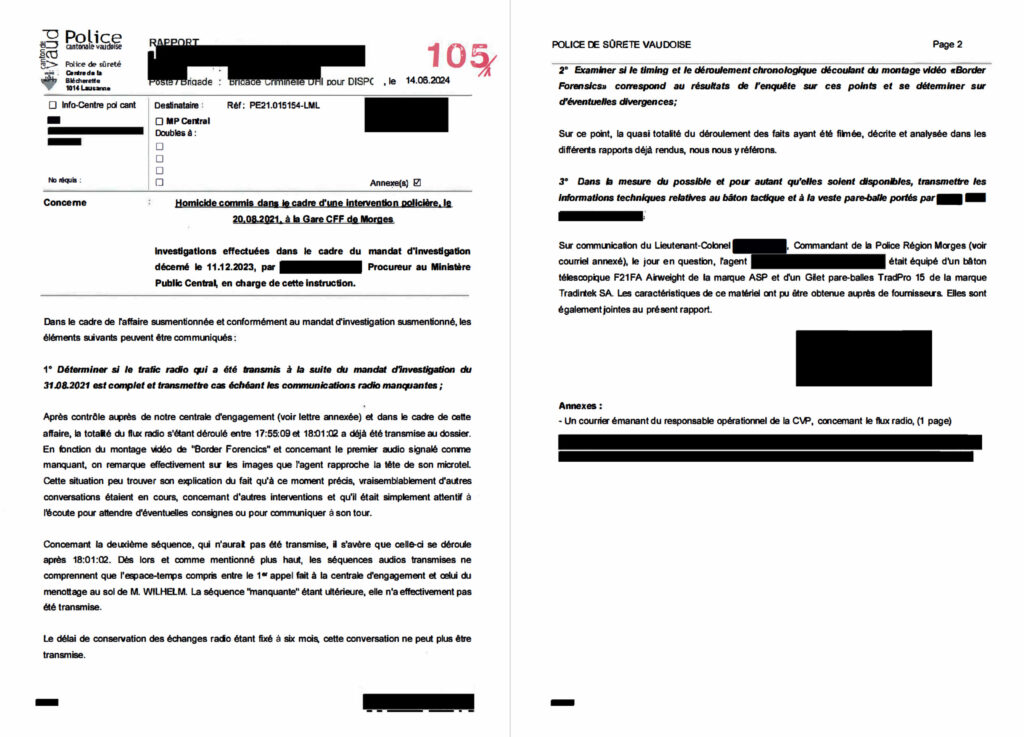
Based on this police report, we continued to deepen our analysis from our preliminary findings to carefully assess the two moments we identified. Based on the videos of the events of 30 August 2021 as well as a photograph taken later that night, we could see that PO3’s radio microphone is fastened to the right side of his upper chest and that an earpiece is in his left ear. In the videos we also see PO3 leaning his head towards the microphone of his radio, touching it with his left hand and remaining in this position for a few seconds while moving his head and hand. The same action occurs every other time he communicates using his radio. It is therefore clear that PO3 was leaning his head towards his microphone to speak and not to listen to other radio communications, which he would have heard using his earpiece. From there, we returned to the case file and managed to identify the file that we initially signalled as missing in our preliminary analysis. Contrary to the police’s response, PO3 was indeed communicating on the radio at 18:00:41 as we had assessed. While this additional research allows us to complete our preliminary analysis on the matter, it also raises questions about the conduct of the criminal investigation. The arguments put forward in the police report appear to be based on assumptions that our now completed analysis contradicts.
Regarding the radio communication made by PO3 at 18:02:02, police investigators confirm that it was not transmitted. They state that it occurred after Nzoy’s handcuffing at 18:01:02, thus outside of the investigation’s established timeframe. Audio recordings are mentioned in multiple requisitions by the prosecutor as well as in the police report, using such wording as “all audio recordings related to the police intervention”139Case file, 3003. or “all conversations recorded shortly before, during and shortly after the events”.140Case file, 3010. The timeframe put forward by police investigators is neither mentioned nor justified in the case file and raises questions about its relevance, particularly since Nzoy’s death was pronounced at 18:31 and the police investigation covers events that happen after 18:01:02.
Moreover, PO4 states in his hearing that after the shots, he heard “a flurry of activity over the radio”.141“Ensuite, j’ai entendu sur les ondes un branle-bas de combat.” Case file, 2007, p. 7. It is highly likely that several police radio communications were conducted after the shooting not only by police officers visible on video and implicated directly in Nzoy’s death, but also by police officers outside of the video frame, sharing crucial information about the case or the actions of police officers. Thus, it is highly likely that “the entirety of the radio traffic” has not been added to the case file. In this context, questions about the nonexhaustive selection of data, their irregular editing and the likeliness of crucial missing radio communications concerning the events remain open.
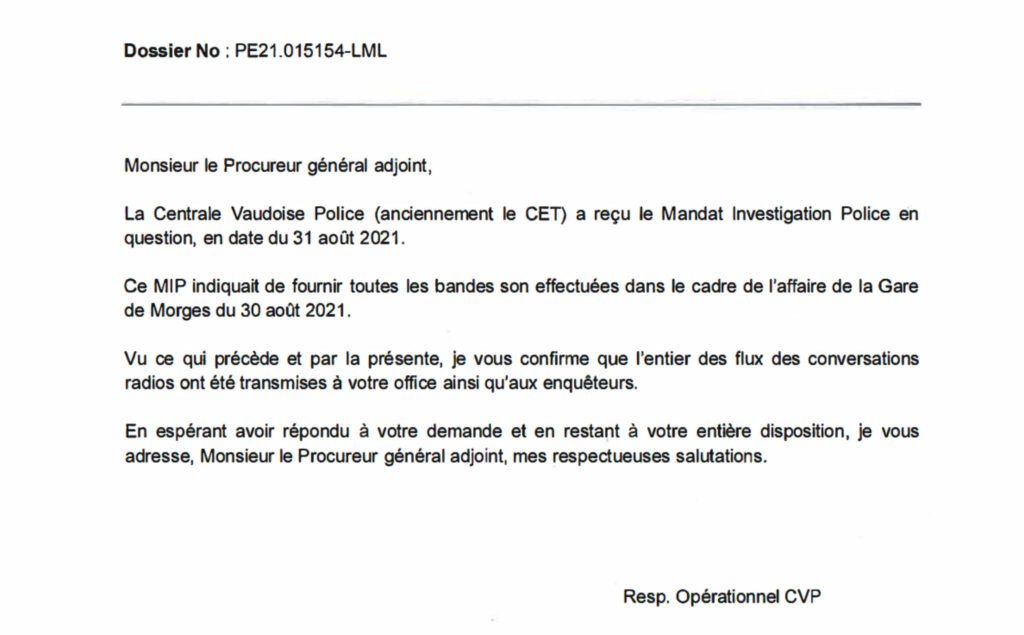
In its ruling of 14 May 2025, the Criminal Appeals Chamber of the Vaud Cantonal Tribunalspecifically addressed the missing radio communications based on our 2023 preliminary analysis:
“If the explanation given for the first audio recording can still be accepted – even though it is quite clear, in the video footage, that officer PO3 moves his head toward his microphone – it is a different matter for the second communication. Indeed, the public prosecutor had requested the production of all communications until the end of the intervention, not just up to the moment of handcuffing. This later period cannot be considered irrelevant with regard to the allegation of failure to offer aid in an emergency. However, it must be noted that these recordings are most likely no longer available due to the six-month legal retention period. That being said, insofar as doubts remain about the completeness of the communications within the transmitted time frame, it appears necessary for an independent expert to confirm that all exchanges still available, up to the end of the intervention, were indeed handed over to the public prosecutor.”142Arrêt Du 14 Mai 2025, PE21.015154-LML.
Radio communications made by police officers involved in Nzoy’s death are crucial to analysing police actions and assessing what information they had and shared or the potential directions or orders they gave, especially in the crucial six minutes during which Nzoy was left unassisted. Furthermore, the combination of ambiguity and opacity in the proceedings leaves important questions about the discretionary power of police to interpret the prosecutor’s requisitions – in this case, to provide “all the audio recordings made in connection with the case” – but also about their data management directives and practices. By controlling the type of information and data about its activities in general, and this case in particular, the police maintain privileged access to the dissemination or concealment of information that impedes the possibility to publicly verify their investigation.
A ghost witness?
Deficiencies in the criminal investigation extend beyond audiovisual data and affect the statements gathered by police officers as well. Our close examination of police hearings and associated audiovisual evidence indeed reveals a significant inconsistency that was neither identified nor addressed in the criminal investigation. This inconsistency pertains to the second railway worker (RW2) whose statement diverges substantially from those of his colleagues and from the available video and audio material. This section analyses these contradictions, offers plausible interpretations, and calls for further scrutiny to clarify the identity, the presence and the reliability of the statements made by individuals present at the scene.
In his hearing, RW2 states that he had been working with three colleagues that day in Morges train station, RW1, RW3 and RW4, and mentions them by name. He explicitly affirms that there was no one else from their team present that day. RW3 and RW4, questioned on 31 August 2021 and 1 September 2021 respectively, confirm this point. Each railway worker corroborates the presence of the same four individuals, aligning their statements with RW2’s initial account.143“Pour vous répondre, hier en fin d’après-midi, en service à la gare de Morges, il y avait [RW3] […], [RW1], [RW4] et moi. Il n’y avait personne d’autre de service.” Case file, 2010, p. 3.
In his hearing, RW2 says that he did not see anything and was not even near the events when they happened.144“Pour vous répondre, je n’ai pas vu la personne décédée à aucun moment. Je ne sais même pas comment il était habillé.” Case file, 2010, p. 3.
This declaration stands in direct contradiction not only to the statements of the other three witnesses but also to the video and audio material available.
In the audiovisual recordings of the scene, two railway workers are visibly interacting with Nzoy before the arrival of the police. One of these individuals has been consistently identified as RW1, the witness who called the police. While the identity of the second individual remains a point of contention, the statements provided by RW3 and RW4 strongly suggest that this person is, in fact, RW2.
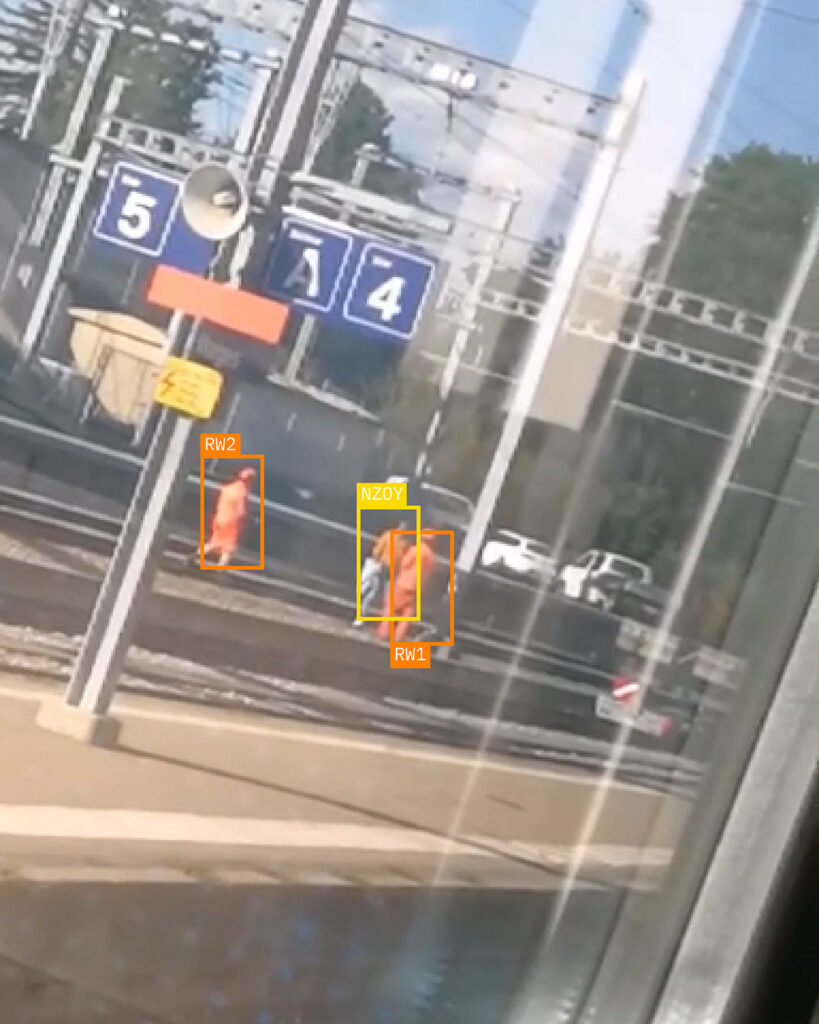
RW3 and RW4 not only confirm that RW2 was present on site, but also place him in proximity to the events. Both state in their hearings that they observed RW2 and RW1 interacting with Nzoy shortly before the arrival of the police. Their statements are consistent with one another, and spatially coherent with the audiovisual material collected from the scene. RW3, for instance, recounts explicitly that he and RW4 were observing the situation unfold from a distance, describing RW2 present at the location where the interaction with Nzoy took place. RW4 corroborates this, adding further contextual detail about their movement and point of observation by asserting that both RW1 and RW2 went towards Nzoy.145“Là, [RW1] et [RW2] sont allés vers lui pour le faire revenir sur le quai.” Case file 2013, p. 3
These statements are reinforced by another crucial piece of audio evidence. In one of the recordings in the case file, RW1 can be clearly heard calling out RW2’s name in an urgent and direct tone. This utterance, occurring during a critical moment of interaction with Nzoy, leaves little doubt that the second railway worker who was physically present and close enough to be called upon for assistance or support was RW2.
Taken together, the convergence of witness statements, video footage and audio recordings paints a clear picture that directly contradicts RW2’s official statement. His assertion that he remained far from the incident, unaware of its details and never saw Nzoy, becomes increasingly untenable in light of the evidence provided by his colleagues and the documented audiovisual materials.
Faced with this inconsistency, we are left with two plausible but equally troubling possibilities. The first is that RW2’s statement is inaccurate. This would mean that a key witness, whose proximity to the events and Nzoy could provide essential insight into the unfolding of the incident, either misremembered or misrepresented his experience. The reasons for such a misrepresentation could vary – from trauma and shock to a conscious attempt at reducing involvement. The second possibility is that the person seen in the video and referred to by the three railway workers as RW2 is not, in fact, the same individual who was questioned as RW2. In this hypothesis, a key witness may be missing entirely, and a case of mistaken identity or administrative confusion has led to the wrong person being questioned.
While we cannot definitively resolve this contradiction based on the available evidence, its implications are serious. It not only reflects a failure of the investigation to identify and confront inconsistencies within its own material, but also deprives the investigation of the crucial testimony of a person who was in contact with Nzoy before the arrival of police officers.
Conclusion
Upon first glance, the criminal investigation into the death of Nzoy seemed extensively documented, owing to the location and time of the events. This apparent abundance of material – videos, audio recordings, photographs, witness statements – has, however, operated as a veil: concealing essential gaps, data alterations and unaddressed inconsistencies. Our analysis shows that these deficiencies did not merely weaken the reconstruction of events, but also undermined the right to an effective and impartial investigation, a right all the more crucial when state agents are involved in serious injuries or death.
First, the probative value of a significant portion of the evidence was compromised through the alteration or erasure of metadata essential to precise spatio-temporal reconstruction. Several files were transmitted via applications that degrade quality and strip metadata, while others are modified versions with altered filenames and no original creation data. In some cases, witnesses deleted images or recordings in the presence of police officers, or were instructed not to share them. These practices made it impossible to fully authenticate sources or establish an exact timeline, requiring additional measures to reconstruct events. The public call for original files launched by the Alliance Justice4Nzoy and the Independent Commission resulted in the recovery of one crucial video with metadata – a step that should never have depended on community initiative but rather on the expected rigor of a criminal investigation’s collection process.
Second, the absence of key material further undermines the investigation. Radio communications from critical moments – including the period after Nzoy was shot and left without assistance – are missing from the case file. The explanations provided by police were partial, speculative and in some cases contradicted by their own documentation. These gaps prevent a full assessment of what the officers knew, communicated and decided, particularly during the six minutes when no medical aid was provided. The possibility that some recordings were lost due to short retention periods only deepens the impact of these omissions and reinforces the need for independent verification of the completeness of all available communications.
Finally, the case file contains major testimonial contradictions that were never addressed. The example of the second railway worker (RW2) is particularly revealing: while audiovisual evidence and the statements of colleagues confirm his presence and interaction with Nzoy before police arrived, RW2 claimed in his police hearing to have been nowhere near the scene. This contradiction leaves only two possibilities: either a key witness provided an inaccurate account, or the wrong person was questioned altogether. Both scenarios are incompatible with the diligence expected in a serious investigation and deprive the inquiry of potentially decisive information about the moments leading up to the police intervention.
These deficiencies were repeatedly identified and documented by Nzoy’s family and their legal representatives, supported by Border Forensics and the Independent Commission. Yet they were met with inaction or refusal to act by the public prosecutor and the cantonal police, which created concrete barriers to accountability. Only the intervention of the Criminal Appeals Chamber, which upheld the family’s position and ordered the continuation of proceedings on neglected aspects, confirmed the premature closure of essential lines of inquiry and the necessity of judicial oversight.
Taken together, these findings do not point to isolated oversights but to a pattern: selective collection, alteration and loss of material; incomplete transmission of communications; and tolerance for unexamined contradictions. The apparent profusion of evidence thus becomes a façade, fragmenting the factual record, protecting those involved and reinforcing the asymmetry of information between police and public. In this configuration, the institution responsible for investigation maintains control over the very traces of its own actions, consolidating a structural imbalance that shields state agents from scrutiny.
Without preservation of the original files and their metadata, without complete and verifiable transmission of radio traffic, without rigorous identification and questioning of witnesses, without systematic resolution of contradictions and without truly independent oversight of collection and analysis, the right to an effective and impartial investigation remains theoretical. The deficiencies documented in this chapter have decisively contributed to the persistence of an erroneous narrative of events. Addressing them is not simply a matter of correcting procedural shortcomings – it is a prerequisite for establishing the facts, ensuring accountability and restoring public trust.
CHAPTER 3. STRUCTURAL RACISM AND PATTERNS OF RACIALISED POLICING
The role that race and racism played in the killing of Nzoy is central to this investigation, a question that has likewise arisen in previous cases of police-related deaths. Studies, reports and press articles have indeed documented the prevalence of racialised categories, racialisation of criminalised behaviours as well as racist practices in the activities of the police in Switzerland.146David Pichonnaz, Devenirs Policiers (Antipodes, 2017), 172; Jovita Dos Santos Pinto et al., eds., Un/Doing Race (Seismo Verlag, 2022), 24, https://doi.org/10.33058/seismo.20745; Julie Eigenmann, “Racisme, la Suisse en flagrant déni,” La Revue des Explorations de Heidi.news 17 (2023); Kollaborative Forschungsgruppe Racial Profiling, Racial Profiling Erfahrungen Wirkungen Widerstand. Beyond these existing studies indicating that the category of race does play an influential role in the activities of the Swiss police and the overexposure of racialised subjects to violence, there were notable elements that emerged from our reconstruction of Nzoy’s case that spurred us to explore this factor.
As we have shown in our reconstruction, moments after the third and final shot was fired at Nzoy, the third police officer (PO3) was asked for more information about the situation via radio. He stated:
“I don’t have further information, a man of colour, he’s on the ground.”147“J’ai pas plus d’infos, une homme de couleur, il est au sol.” Case file, 1020.
No further information about Nzoy’s health or the situation in general was provided in the audio recordings that we had access to. Only Nzoy’s skin colour, and that he was lying on the ground, stood out for PO3 to mention. Furthermore, while the four police officers involved in the events continually denied that race shaped their actions, they repeatedly referred to Nzoy as a “mixed-race” person or a “man of colour” in their hearings. They never mentioned the race, skin colour or whiteness of other people involved.
A couple of weeks after the events, the Morges police commander reiterated this denial, stating that:
“The racist nature of the incident – I can’t accept that as a criticism. Skin colour had no influence on the professional actions carried out by my officers at that moment. […] I spoke with [my officers], but we didn’t talk about skin colour [stifled laugh], because in a situation like that, it’s the risk that draws attention – the lethal weapon, the knife. In moments like these, the officers are focused on the danger. Does the person still have the knife? And really, the person could be Asian, of African descent, or white – that’s not a factor they take into account in their assessment.”148“‘La couleur de la peau n’a eu aucune influence’ dans le drame de Morges, selon la police,” RTS, directed by RTS, September 17, 2021, https://www.rts.ch/info/regions/vaud/12500876-la-couleur-de-la-peau-na-eu-aucune-influence-dans-le-drame-de-morges-selon-la-police.html.
Read together, these statements reveal two interrelated dynamics. On the one hand, the salient perception of Nzoy as – and his reduction to – a “man of colour” points to the omnipresence of racialisation in police activities in Switzerland. On the other hand, these statements exemplify the police’s sustained effort to deny that race and racism shape their activities, which in turn leads to the refusal to address this issue. Responses to police-related violence and deaths are indeed typically marked by defensiveness, denial and the refusal to accept responsibility.149Stefanie Claudine Boulila, “Race and Racial Denial in Switzerland,” Ethnic and Racial Studies 42, no. 9 (2019): 1401–18, https://doi.org/10.1080/01419870.2018.1493211. The possibility of a connection between racism and policing is often treated as inconceivable, which in turn hinders the recognition of police practices as structurally shaped by racial categories. 150Eigenmann, ‘Racisme, la Suisse en flagrant déni’; Claudia S. Wilopo et al., Racial Profiling: Erfahrung, Wirkung, Widerstand, Rosa-Luxemburg-Stiftung, 2019, https://doi.org/10.5167/UZH-222711.
The killing of Nzoy offers, therefore, not only insight into one case of a fatal police shooting but also into the invisibilised yet structural role of racism and the systemic institutional failures that have fostered the enabling conditions for this tragedy. Crucially, structural racism manifests routinely, yet remains largely hidden within the everyday decisions and (in)actions of institutions perceived as neutral or normal.151Leonie Mugglin et al., Racisme Structurel En Suisse : Un État Des Lieux de La Recherche et de Ses Résultats, no. 81f, SFM Studies (Université de Neuchâtel, Swiss Forum for Migration and Population Studies, 2022), https://www.unine.ch/sfm/wp-content/uploads/sites/100/SFM-Studies-81f.pdf; Dos Santos Pinto et al., Un/Doing Race.
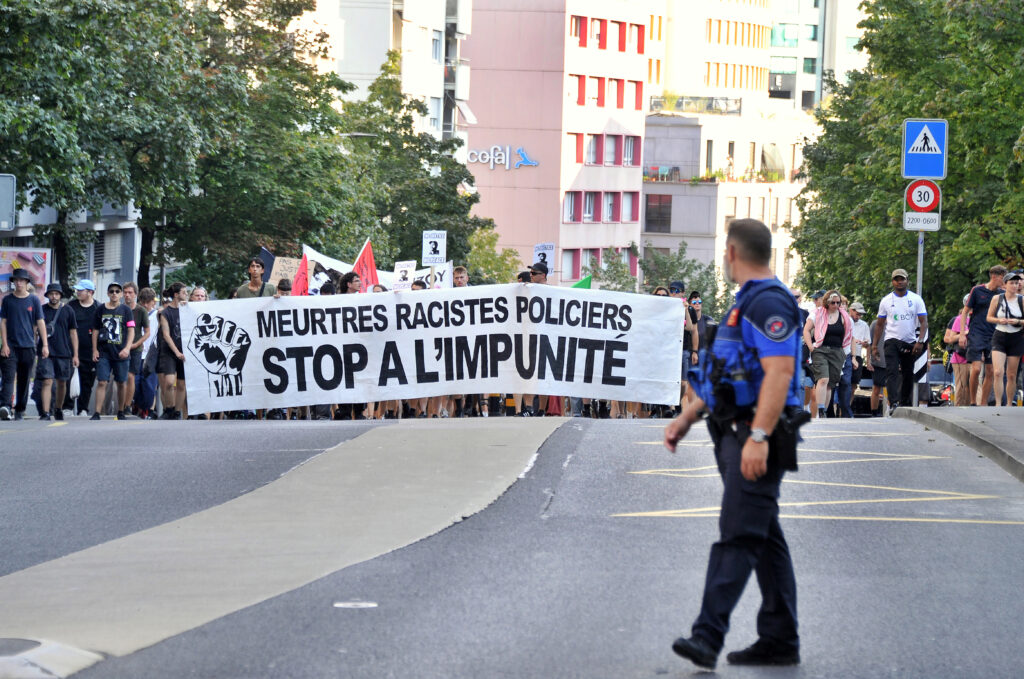
In this chapter, we address the structural context in which Nzoy’s killing occurred through a series of operations of desingularisation and unveiling of a denied reality. The first operation is historical and situates Switzerland within Europe’s colonial and racist history and shows the persistence of structural racism in Swiss society to this day. The second operation is institutional and, based on academic studies and reports, highlights the prevalence of racialising and racialised patterns and practices within the Swiss police as well their denial. The third and final operation is statistical and objectifies the number of deaths caused by the police and the overrepresentation of individuals who underwent a process of othering – in relation to racialisation, socio-legal status, psychopathology and drug use – while revealing the “epistemic power of the police”152Magda Boutros, “The Epistemic Power of the Police,” Theoretical Criminology, July 23, 2024, 13624806241263916, https://doi.org/10.1177/13624806241263916. and its consequences in obscuring the reality of racist police violence. We also show that lethal police harm is unequally distributed in space, with the Canton of Vaud emerging as the most lethal Swiss canton in recent years. Together, these three operations allow us to return to our guiding question for this chapter: to what extent was the killing of Nzoy shaped by racism and processes of othering?
Racism, structural racism and racialisation
Racism is the belief or practice of dividing and ranking people into “races” based on physical, ethnic, religious or cultural traits, often assigning them negative and fixed characteristics. It is a “total social phenomenon”153Étienne Balibar and Immanuel Maurice Wallerstein, Race, Nation, Class: Ambiguous Identities (Verso, 1991), 17. that operates both through individual actions – whether intentional or unconscious – and through institutional processes, social structures and widely shared norms and values, and enshrines inequality, exclusion and privilege. Racism includes prejudice, discrimination, hate speech and violence,154Service de Lutte contre le Racisme, “Glossaire,” accessed July 25, 2025, https://www.frb.admin.ch/fr/glossaire. that can materialise in the “state-sanctioned or extralegal production and exploitation of group-differentiated vulnerability to premature death”.155Ruth Wilson Gilmore, Golden Gulag: Prisons, Surplus, Crisis, and Opposition in Globalizing California (University of California Press, 2007), 247.
Structural racism is a “social system composed of discourses, principles of action and normative representations stemming from forms of domination that have developed throughout history and tend to reproduce power relations of inequality to the detriment of racialized groups”.156Mugglin et al., Racisme Structurel En Suisse : Un État Des Lieux de La Recherche et de Ses Résultats, 20. Structural racism “encompasses modes of thinking, acting and organizing society (discourses, practices, policies, institutions) based on racialization in the triple sense of a division of the population into racialized groups, their essentialization, and their hierarchization, with the effect of legitimizing and naturalizing exclusion as well as differential inclusion”.157Robin Celikates, “From ‘Xenophobia’ to Structural Racism, and Back? Epistemic Obstacles, Conceptual Struggles, and the Role of Critical Theory,” Ethnic and Racial Studies 48, no. 7 (2025): 1349, https://doi.org/10.1080/01419870.2024.2446488. It is “less overt, far more subtle, less identifiable in terms of specific individuals […] but it is no less destructive of human life”.158Charles V. Hamilton and Stokely Carmichael, Black Power: Politics of Liberation in America (Knopf Doubleday Publishing Group, 2011), 4. It operates through the everyday workings of schools, courts, hospitals, housing and policing, often unnoticed yet deeply entrenched. The harm it causes is not always violent or visible but accumulates through exclusion, neglect and unequal access to basic human needs. Structural racism does not require explicit hatred to thrive – only indifference and inaction.
Racialisation is the socio-political process by which individuals or groups are assigned a racial identity that carries assumptions and stereotypes, which in turn produce forms of exclusion and exploitation. It is not based on inherent or biological differences but is a construction rooted in historical, political and social power dynamics. Étienne Balibar’s notion of “racism without races”159Étienne Balibar, “La construction du racisme,” Actuel Marx n° 38, no. 2 (2005): 11–28, https://doi.org/10.3917/amx.038.0011. highlights how contemporary racism often operates through proxies such as culture, religion, nationality or language, rather than biological categories. In Switzerland, racialisation can occur through a “race-mute” or “raceless” logic, where perceived markers like national origin, name or accent are used to differentiate and marginalise certain individuals.160Noémi Michel, “Sheepology: The Postcolonial Politics of Raceless Racism in Switzerland,” Postcolonial Studies 18, no. 4 (2015): 410–26, https://doi.org/10.1080/13688790.2015.1191987; Boulila, “Race and Racial Denial in Switzerland.” As a result, both a white eastern European immigrant and a Black Swiss citizen might be racialised in different ways, depending on the context, as they are identified as non-belonging in distinct but overlapping ways.
Racism in Switzerland: a national denial
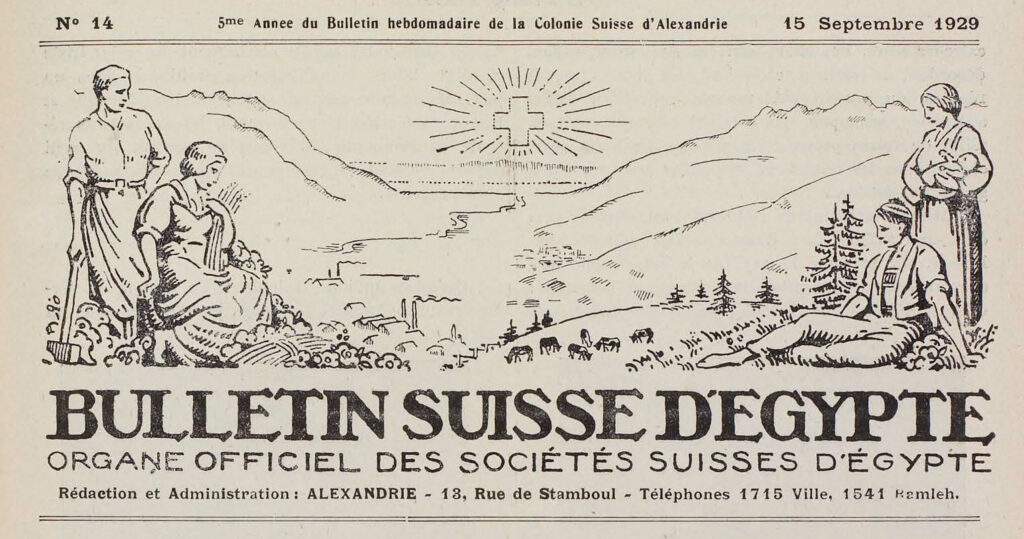
Historically, the Swiss national self-image is constructed through the ideological notion of Sonderfall, literally “particular case”, which depicts Switzerland’s neutrality, federalism, multilingualism, working mentality and even natural landscape as exceptional in comparison with other western European states.161Georg Kreis, “Sonderfall,” in Dictionnaire historique de la Suisse (DHS), 2012, https://hls-dhs-dss.ch/articles/049556/2012-12-20/. The historical narrative of Sonderfall is a constitutive part of Swiss political culture and is used as a prism through which to address social and political issues.
This approach is particularly pervasive when addressing racism in Switzerland as well as the country’s colonial past. Based on a denial of its colonial past as well as partial comparisons with neighbouring countries, racism has been commonly perceived as marginal or nonexistent in Switzerland.162Michel, “Sheepology”; Viviane Cretton, “Performing Whiteness: Racism, Skin Colour, and Identity in Western Switzerland,” Ethnic and Racial Studies 41, no. 5 (2018): 842–59, https://doi.org/10.1080/01419870.2017.1312006; Boulila, “Race and Racial Denial in Switzerland.”
One key dimension of Swiss exceptionalism in this regard is the country’s historical absence of colonial empire. Despite Switzerland never formally possessing colonies, the country is deeply embedded in European colonial history. Research has shed light on the direct participation of Switzerland in the colonial enterprise and the trade in enslaved people. Swiss citizens as well as private companies had direct economic interests in colonies and in the Atlantic trade in enslaved people, and their involvement was frequently facilitated by different municipal, cantonal and federal authorities. Swiss mercenaries participated in colonial conquests and wars and many Swiss citizens created settler communities in Algeria, Egypt, North America, Brazil and the Caribbean.163Thomas David et al., La Suisse et l’esclavage Des Noirs (Antipodes, 2005); Claude Lützelschwab, La Compagnie genevoise des colonies suisses de Sétif: 1853-1956 : un cas de colonisation privée en Algérie (Peter Lang, 2006); Patricia Purtschert et al., Postkoloniale Schweiz: Formen und Folgen eines Kolonialismus ohne Kolonien (transcript Verlag, 2014); Purtschert Patricia and Fischer-Tiné Harald, Colonial Switzerland: Rethinking Colonialism from the Margins, Basingstoke, 2015; Sandro Cattacin and Marisa Fois, eds., Les colonialismes suisses: études (Vol. II), Sociograph, Sociological Research Studies, vol. 50 (Université de Genève, 2020), https://archive-ouverte.unige.ch/unige:147586; Bouda Etemad and Fabio Rossinelli, “Colonialisme,” in Dictionnaire historique de la Suisse (DHS), 2024, https://hls-dhs-dss.ch/articles/026457/2024-09-18/. In this sense, “Switzerland is not an isolated island at the heart of the continent”.164Patrick Minder, “La Suisse coloniale ? : les représentations de l’Afrique et des Africains en Suisse au temps des colonies (1880-1939)” (Université de Neuchâtel, 2009), 29, https://doi.org/10.35662/unine-thesis-2095.
Beyond the participation of Swiss citizens, companies and cantons in the colonial enterprise abroad, the country also developed a distinct colonial imagination, absorbing and reproducing colonial ideology through advertising, Christian missions, racial science and public exhibitions.165Patricia Purtschert et al., eds, Postkoloniale Schweiz: Formen Und Folgen Eines Kolonialismus Ohne Kolonien, Postcolonial Studies, Band 10 (Transcript, 2012).; Jovita Dos Santos Pinto et al., eds, Un/Doing Race (Seismo Verlag AG, 2022), 24, https://doi.org/10.33058/seismo.20745 In this context, Black people were routinely depicted as primitive, dirty, infantilised or hypersexualised – images crafted to affirm white superiority. One of the most striking examples of this normalisation of dehumanisation is the phenomenon of so-called “human zoos” staged in Switzerland. In Geneva, Lausanne and beyond, Black men, women and children were exhibited in replicas of “African villages” between 1880 and 1940. In Geneva, the “Negro Village” of 1896, a centrepiece of the National Exhibition, drew up to 40,000 visitors a day. These exhibitions, some of them financed by the Swiss state and organised by European impresarios, served as spectacles for public entertainment, as pedagogical tools in schools and even as sites of pseudoscientific research. The staging of Black and other non-white bodies, their spatial confinement and the voyeuristic gaze of the public all contributed to a racist pedagogy designed for the general population – to learn to be “white” compared to the racial others. Switzerland’s occluded colonial entanglements did not only racialise; they also gendered racialisation, circulating images of Black masculinity as hyper-strong, unpredictable, and dangerous. This shaped imaginaries where “threat perception” is rapidly mapped onto racialised men’s bodies.166Norman Ajari’s related account of phallicism helps name the colonial libidinal economy through which Black men are simultaneously feared and fetishised. As Ajari summarizes, “Phallicism refers to the condition whereby men from a racialized group […] are simultaneously imagined as threats and sexual predators,” a schema that stabilizes police and penal targeting of non-white men and frames their elimination as one function of the carceral state. This clarifies why, in Europe as in the U.S., the gendered dimension of state racism falls most heavily on boys and young men of colour – aligning with what we observe in our data. See Norman Ajari, “Phallicisme et abolition: Repenser la justice transformatrice à partir des Black Male Studies,” Multitudes, no. 88 (2022): 87–93, https://www.cairn.info/revue-multitudes-2022-3-page-87.htm?contenu=article.
These colonial representations and logics are not merely relics of the past but also continue to structure Swiss imagination as well as state institutions. Yet these continuities have long been obscured by a persistent refusal to confront Switzerland’s role in imperial and racial regimes, producing a national narrative in which complicity is minimised or denied. This denial is sustained through a pervasive colonial amnesia that frames Switzerland as external to European imperial histories precisely because it lacks formal colonies.167Rohit Jain, “Schwarzenbach Nous Concerne Tous ! Réflexions Sur Une Politique Mémorielle Polyphonique et Antiraciste,” in Un/Doing Race, ed. Jovita Dos Santos Pinto et al. (Seismo Verlag, 2022), https://doi.org/10.33058/seismo.20745. Rather than accidental, this amnesia is a constitutive practice that allows the Sonderfall narrative to endure while erasing the country’s entanglement with colonial violence. Such selective remembering not only obscures historical complicity, but also strategically shields contemporary institutions from confronting how these colonial logics continue to shape, in particular through structural racism, social and political life.
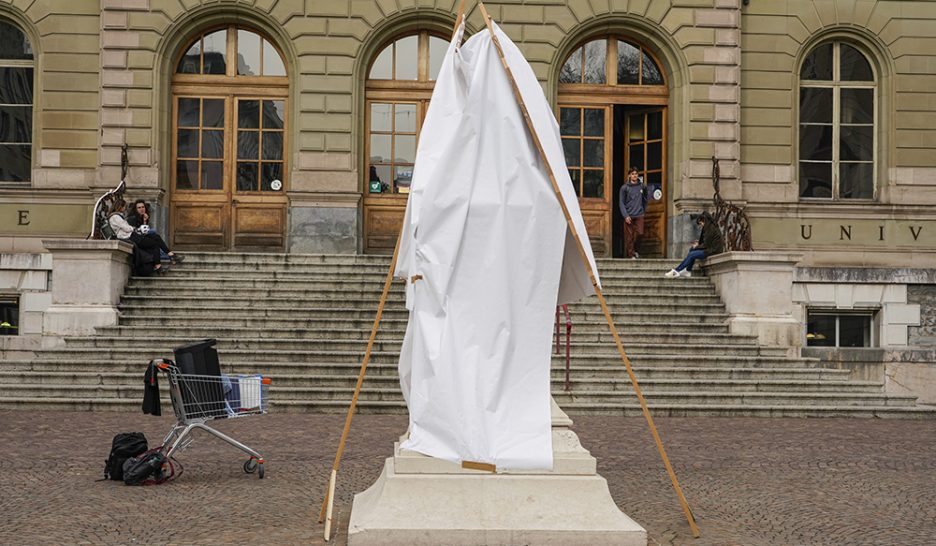
In Switzerland, the limited statistics available show that acts of racism and racial discrimination are on the rise.168Service de Lutte contre le Racisme, Le racisme en Suisse : chiffres, faits, mesures à prendre (2025), https://backend.frb.admin.ch/fileservice/sdweb-docs-prod-rassismuszahlench-files/files/2025/03/25/a0d20baf-51e4-406a-beaf-bf730012a45c.pdf. Existing data on racism largely stems from self-reported experiences of discrimination as well as national attitude surveys. Reports published by the Federal Service for Combating Racism compile data from complaint services, NGOs and perception surveys, documenting such cases as denial of service, racial insults or unequal treatment. While this information is essential to measure perceived and reported racism, it often centres on individual experiences and attitudes and tends to obscure the deeper, institutional dimensions of racial inequality – those that persist even in the absence of overtly racist individuals. This gap makes it necessary to adopt a structural racism framework, which focuses on how laws, norms and institutional logics produce racialised outcomes, regardless of intent.
Structural racism operates through policies, regulations and the everyday routines of institutions that present a veneer of neutrality but, in practice, reinforce racial hierarchies. It permeates schools, healthcare systems, the judiciary, the military and especially the police. In these settings, characteristics such as skin colour, names, accents or religious symbols become coded as signs of deviance or danger, often unconsciously. These associations are sustained through repetition, institutional neglect and unexamined norms, which means patterns of inequality persist even without overtly racist intent.
Understanding racism through this structural lens allows us to transcend individual intent. Racialisation, as described above, refers to the process by which bodies and behaviours are assigned racial meaning, shaping how people are perceived and treated. This notion helps to explain why certain people are persistently cast as threats – perceived as unstable, abnormal or dangerous – while the structural conditions shaping these perceptions remain hidden.
Indeed structural racism often disappears from view through its routine performance. This invisibilisation is central to how racism functions in Switzerland. It is maintained through denial: denial that race plays a role, that institutions can be biased or that systemic harm occurs. As a result, racist outcomes are normalised precisely because the mechanisms that produce them go unnamed. Switzerland’s self-representation as a colonyless and raceless Sonderfall masks deeply racialised realities.
Nzoy’s killing makes these dynamics starkly visible. On 30 August 2021, as demonstrated in Chapter 1, Nzoy was simultaneously psychopathologised, racialised and gendered as a “man of colour”. This dual othering, combined with masculinity, led to an unwarranted imputation of dangerousness. In turn, the police’s response to Nzoy’s distress prioritised control over care, and led to a sequence of escalation and omissions that threatened and devalued his life. At the same time, all actors denied this racialised perception could have influenced what happened. His case is therefore not just an “individual tragedy” but a lens through which to examine how institutional routines, historical narratives and unspoken hierarchies converge to produce lethal consequences. The ways in which structural racism shapes everyday police practices, and how this influence is denied, as clearly illustrated by the case of Nzoy, is explored in the next section.
Racism in the police and its denial
After exploring the historical roots of structural racism and its erasure in public memory in Switzerland, this subchapter examines how these dynamics manifest within the institution and practices of the Swiss police. It looks at the systemic patterns of racial profiling, violence and denial that shape the relationship between law enforcement and racialised communities in Switzerland.
While public discourse has often framed Switzerland as largely immune to the kinds of structural racism shaping police activities seen in such countries as France, Germany or the UK, such exceptionalism has increasingly been challenged. Documented cases and testimonies reveal that racialised policing is also a reality in Switzerland, one which has long been obscured by postcolonial amnesia and the myth of a “raceless” society.
Reports about racism in Switzerland have explicitly addressed police institutions, activities and training, notably pointing out that “institutional and structural racism continues to be a problem in the police”.169European Commission against Racism and Intolerance, ECRI Report on Switzerland (Sixth Monitoring Cycle) (Council of Europe, 2019), 7. In its 2022 visit to Switzerland, the UN Working Group of Experts on People of African Descent, also noted that:
“Boys and men of African descent not facing criminal charges or individualized suspicion consistently reported experiences of police reinforcing negative racial stereotypes in the public realm. Rampant racial profiling, police controls, invasive searches in the street, public strip-searches, cavity searches, racist slurs and “humour”, violence and the expectation of impunity was described as routine.”170UN Working Group of Experts on People of African Descent, Visit to Switzerland: Report of the Working Group of Experts on People of African Descent, A/HRC/51/54/Add.1 (United Nations, 2022), 11, https://digitallibrary.un.org/record/4013317.
These observations concur with the numerous research, articles and testimonies from victims and police officers, which address racism and violence in Swiss police forces.171Mohamed Wa Baile et al., Racial Profiling und antirassistischer Widerstand Eine Einleitung (transcript Verlag, 2019); Plümecke et al., ‘Effects of Racial Profiling’; Eigenmann, ‘Racisme, la Suisse en flagrant déni’. Analysing police activities does shed light on the workings and violent effects of racialising and racist structures. State and police practices are most effectively understood at their “margins”, in the way “State officials deal with its poor and its delinquents, its immigrants and its detainees, in the manner that it administers sensitive urban neighborhoods and waiting zones at the border, correctional facilities and detention centers”.172Didier Fassin, ed., At the Heart of the State (Pluto Press, 2015), 3. These practices are not only shaped by institutional and structural conditions, but also actively participate in constructing and reinforcing symbolic boundaries between those deemed to belong and those marked as foreign or other.
Structural racism has become embedded and normalised in everyday policing practices, especially through racial profiling and discriminatory surveillance.
Racial profiling constitutes a discriminatory practice frequently performed by law enforcement, border police or private securities that targets individuals as suspects based on their race, ethnicity, religion or national origin, rather than on any evidence.173Kollaborative Forschungsgruppe Racial Profiling, Racial Profiling Erfahrungen Wirkungen Widerstand. Studies have indeed shown that the police tend to be more sceptical, fearful and suspicious of racialised people and therefore monitor them more intensively.174Sebastian Friedrich et al., “Alltäglicher Ausnahmezustand: Institutioneller Rassismus in Deutschen Strafverfolgungsbehörden,” Kampagne Für Opfer Rassistischer Polizeigewalt (Hrsg.). Alltäglicher Ausnahmezustand: Institutioneller Rassismus in Deutschen Strafverfolgungsbehörden. Edition Assemblage, Münster, 2016, 10–21; Kollaborative Forschungsgruppe Racial Profiling, Racial Profiling Erfahrungen Wirkungen Widerstand; Fatima El-Tayeb and Vanessa Eileen Thompson, “Alltagsrassismus, staatliche Gewalt und koloniale Tradition Ein Gespräch über Racial Profiling und intersektionale Widerstände in Europa’,” in Racial Profiling und antirassistischer Widerstand Eine Einleitung, ed. Mohamed Wa Baile (transcript Verlag, 2019); Plümecke et al., “Effects of Racial Profiling,” 2023. The UN Working Group of Experts on People of African Descent observed that racial profiling is not only pervasive across Switzerland, but has also become normalised in some police forces, despite consistent testimony of discriminatory practices.175UN Working Group of Experts on People of African Descent, Visit to Switzerland. The Committee on the Elimination of Racial Discrimination (CERD) explicitly urged Switzerland to prohibit racial profiling by law and to take effective operational measures to eradicate its use by law enforcement officers.176Committee on the Elimination of Racial Discrimination (CERD), Concluding Observations on the 10th–12th Periodic Reports of Switzerland, CERD/C/CHE/CO/10-12 (2021), https://www.ohchr.org/en/documents/concluding-observations/cerdccheco10-12-concluding-observations-committee-elimination, paras. 19-20. Similarly, the European Commission against Racism and Intolerance (ECRI) emphasised the need for stronger police training and recommended the creation of independent oversight mechanisms to address racially motivated misconduct.177European Commission against Racism and Intolerance, ECRI Report on Switzerland (Sixth Monitoring Cycle), paras. 110–112. In a recent Universal Periodic Review, multiple states called on Switzerland to adopt specific legislation against racial and ethnic profiling at all levels of policing and to establish independent complaint mechanisms.178United Nations Human Rights Council, Universal Periodic Review – Fourth Cycle: Switzerland, A/HRC/53/12 (2023), Recommendations 39.132 (Colombia) and 39.133 (Zambia). These consistent recommendations underline the systemic nature of racial profiling in Switzerland and the urgent need for structural reform – an issue we address in more detail in the Chapter 4.
While these findings and recommendations by international bodies working within a human rights framework are important signals of a deeper problem of racism in Swiss policing, they define racism and discrimination in policing somewhat narrowly: primarily as decisions made by officers to stop individuals based on race or ethnicity. It is essential, however, to expand this understanding to include other dimensions of racialised policing, such as discriminatory patterns in police use of force, disproportionate surveillance and differential access to protection and security.
From the above, it is evident that the mechanics of discriminatory policing observed in the killing of Nzoy – the processes of othering and differential treatment he was subjected to – are not isolated phenomena, but concrete manifestations of the structural racism that permeates Swiss society and institutions, and specifically the police. The practice of racial denial we have demonstrated in Nzoy’s case also corresponds to broader patterns of practice.
When addressing racism and its effects, people and institutions are often defensive and reluctant to question – or even reflect on – their actions. This common defensiveness and the broader denial of racism in police practices are epitomised by the statement of the Morges police commander reported in the introduction to this chapter. Numerous studies corroborate that the police and state authorities are resistant to becoming aware of racist stereotypes and maxims.179Tino Plümecke et al., “Effects of Racial Profiling: The Subjectivation of Discriminatory Police Practices,” Ethnic and Racial Studies 46, no. 5 (2023): 811–31, https://doi.org/10.1080/01419870.2022.2077124. A particularly harmful consequence of this dynamic is the prevalence of what has been termed “racial denial” – the refusal among many police officers to acknowledge the existence or relevance and impact of racism in their work. While racial denial is part of the larger political culture of “racelessness” and postcolonial amnesia, it is also reproduced actively in police institutions.180Michel, “Sheepology.” Such denial not only obstructs the development of reflexive and discrimination-sensitive practices but also impairs the police’s capacity to fulfill their core mandate: the equitable protection of all people in need. In the absence of critical engagement with the systemic nature of racism, officers may – often unconsciously – perpetuate racially biased practices, with potentially severe and deadly consequences for marginalised groups. Racial denial among police officers erodes public trust in law enforcement, as communities, particularly those of colour, may perceive officers as biased or unaccountable, undermining their confidence in the fairness and effectiveness of policing.
Denial, however, is not only a discursive process but, as we will show in the next section, is also performed through the orchestrated absence of statistics concerning police-related deaths. Towards the aim of giving form to this absence, we will present and discuss our own new database on police-related deaths. The analysis of this database in turn allows us to deepen our understanding of the way discriminatory police practices affect the risk of dying at the hands of the police.
From othering to killable subjects: A statistical analysis
The section above has offered an analysis of the way structural racism shapes the practices of the Swiss police based on existing academic literature, reports and testimony. In our effort to deepen our understanding and illuminate the way discriminatory police practices affect the risk of dying at the hands of the police, we compare the findings described above to statistical analysis. However, relevant data is either nonexistent or publicly inaccessible.
In this section, we first discuss how the politics of denial are performed through the lack of data concerning police-related deaths, and reveal the “epistemic power of the police” and its consequences in obscuring the reality of how race shapes police violence.181Boutros, “The Epistemic Power of the Police,” July 23, 2024. By controlling what is counted, police leadership controls what society is allowed to see, know, and remember. The (non-)production of state statistics on police-related deaths manufactures ignorance, normalises state violence as rare, and constructs the fatal outcomes of policing as non-events. Second, we present and discuss a new database we have compiled during our investigation, which contains 83 police-related deaths that occurred between 1992 and 2025. We present headline figures that dismantle the rarity narrative put forward by the police. Third, we analyse this database and demonstrate that people who are othered through racialisation, but also socio-legal status, psychopathology or drug use, are disproportionately represented among documented police-related deaths in Switzerland. In other words, we offer a statistical analysis of how processes of othering produce killable subjects. Fourth, we situate our counter‑statistical practice within broader struggles for truth and dignity. We build on the new insights generated through our statistical analysis in returning, in the conclusion of this chapter, to our guiding question – to what extent was the killing of Nzoy shaped by racism and processes of othering?
The absence of statistics: Manufacturing ignorance and legitimising impunity
The lack of disaggregated data on police interventions creates systemic invisibility. The UN Committee against Torture has repeatedly criticised Switzerland’s failure to collect national statistics on complaints, investigations and outcomes of alleged police violence,182UN Committee against Torture (CAT), Concluding Observations on the 7th Periodic Report of Switzerland, CAT/C/CHE/CO/7 (2015), https://docs.un.org/en/CAT/C/CHE/CO/7, para. 10. while CERD has emphasised the need for data on racial profiling and identity checks.183Committee on the Elimination of Racial Discrimination (CERD), CERD/C/CHE/CO/10-12, para. 19. This statistical void is not neutral: it constitutes a specific form of violence and denial, obscuring patterns of racialised harm and shielding law enforcement from accountability.
Without transparent, comprehensive records, discriminatory practices remain hidden, systemic racism is made statistically invisible and law enforcement agencies are shielded from accountability. To understand the politics and implications of this statistical absence, we draw on Magda Boutros’s concept of “epistemic power”,184Boutros, “The Epistemic Power of the Police,” July 23, 2024. which allows us to highlight the way Switzerland constructs a regime of truth that systematically excludes the recognition of racialised violence and legitimates police impunity. The epistemic power exercised by the police, as theorised by Boutros, relies on defining what is knowable, credible and memorable – referring to power in terms of knowledge production and narrative control by the police. In Switzerland, this control is evident in a strategic management of ignorance that operates in three dimensions.
First, the existing but unpublished official data on police-related deaths is central to a regime of ignorance in Switzerland. No state body systematically releases publicly data about fatalities following police interventions. The Swiss Conference of Police Commanders (CCPCS) publishes limited data focusing merely on firearm uses without the systematic mention of their fatal outcomes. These police-published statistics highlight a 60% drop in lethal police shootings between 2010 and 2020,185“Les tirs de police à l’issue fatale restent exceptionnels en Suisse,” RTS Info, February 13, 2024, https://www.rts.ch/info/suisse/2024/article/les-tirs-de-police-a-l-issue-fatale-restent-exceptionnels-en-suisse-28401235.html which obscures the steady rate of deaths that our analysis makes visible – around two to three per year. Even the few firearm-related deaths they have made public are underdocumented: our data shows that the CCPCS’s official account in 2024 missed at least one fatal shooting in 2019, reporting only one, while we documented two.186“« Je n’ai jamais été fier d’avoir tiré, mais je n’ai jamais eu honte », témoigne un policier,” RTS Info, September 13, 2021, https://www.rts.ch/info/suisse/12488041-je-nai-jamais-ete-fier-davoir-tire-mais-je-nai-jamais-eu-honte-temoigne-un-policier.html The fact that even this partial and selective data is inaccurate shows a profound institutional disregard for human life, reducing deaths to expendable numbers that can be minimised or erased.
The lack of comprehensive statistics is not a neutral omission but a form of epistemic power. It actively produces ignorance by concealing the scale and nature of lethal police actions. Without reliable data, the public and policymakers cannot grasp the full scope of the issue or remember its victims. Research from other countries confirms this effect: a Lancet study found that more than 50% of police-related deaths in the USA were missing from official data.187“Fatal Police Violence by Race and State in the USA, 1980–2019: A Network Meta-Regression,” The Lancet 398, no. 10307 (2021): 1239–55, https://doi.org/10.1016/S0140-6736(21)01609-3. What goes unrecorded is effectively erased from public scrutiny and institutional memory. In Switzerland, the burden of proof and remembrance falls on families and civil society organisations, while the state remains silent. By not producing knowledge, state authorities limit public understanding and shield state institutions from accountability. Without data, there is no way to track patterns, recover truth or demand justice. This statistical concealment also enables impunity: what is invisible in official records is not possible to pursue systemically. Thus, silence becomes a powerful tool of control.
Second, beyond passively failing to collect data, Swiss police actively shape how data is published to reinforce ignorance. The CCPCS’s selective reporting creates statistical erasure: police violence that does not involve a firearm disappears from the official record. CCPCS reports emphasise a drop in firearm use – from 29 incidents in 2010 to 12 in 2020, and only six in 2021. These figures are framed as proof of a decrease in police violence, citing just one “fatal shot” in 2021.188“«Je n’ai jamais été fier d’avoir tiré, mais je n’ai jamais eu honte », témoigne un policier,” RTS Info, September 13, 2021, https://www.rts.ch/info/suisse/12488041-je-nai-jamais-ete-fier-davoir-tire-mais-je-nai-jamais-eu-honte-temoigne-un-policier.html However, deaths caused by other means – restraint, beating or in-custody neglect – are excluded. Such omissions are not neutral. By excluding non-firearm fatalities, authorities manipulate the statistical narrative to depict lethal police practices as rare or nonexistent. This statistical concealment constructs a misleading reality in which only gunfire counts, masking systemic issues behind a facade of de-escalation. The result is epistemic power through numbers: data is weaponised as a tool of domination, shaping public perception and reinforcing impunity. The curation of data enables officials to claim, even internationally, that Switzerland has a low rate of police-related deaths, reinforcing the image of an exceptionally safe country with restrained law enforcement. Meanwhile, the true scope of police-related deaths remains hidden, shielding institutions from scrutiny and accountability. By controlling what is counted, police leadership controls what society is allowed to see, know and remember, normalising state violence as rare and constructing the lethal consequences of such violence as non-events.
The third mechanism of epistemic power operates through language, and its effects are also statistical. Euphemism and passivity when describing lethal police encounters (“died following a malaise”, “natural causes”, “suicide in custody”) sever the causal chain between police actions and death, turning patterned practices into isolated non-events, or sometimes even as deaths entirely unrelated to police practices. Consequently, this framing prevents aggregation, comparison and accountability: if causes are unnamed, structures cannot be seen.
To counter this issue of language use, events must be resituated with precise, causal terminology that makes practices legible – e.g. firearm use; restraint/suffocation; medical neglect/non-assistance; police chase; other/unknown – and with attention to markers of othering processes (racialisation, socio-legal status, psychopathology) embedded in official narratives. Put plainly: a press release that says “malaise” may be disguising a violent killing structured by racialised presumptions.
Police actively shape this framing through carefully worded press releases, emphasising exculpatory details or distractions that some media often reproduce. This creates a discursive regime of impunity: if language does not acknowledge wrongdoing, accountability is unlikely to follow. Together with the lack of data and statistical erasure, this sanitised discourse completes the machinery of ignorance. Police lethality is hidden at every stage – unrecorded, uncounted and misrepresented.
To address the systemic absence of transparent and publicly accessible data, Border Forensics initiated a systematic documentation project to construct a comprehensive database encompassing all known interactions with Swiss police that resulted in fatalities, spanning the period from 1992 to 2025. We first present this database and, through it, highlight the pervasiveness of police-related death in time and space, before turning to the lethal processes of othering that it reveals.
For the purpose of this database, we define entries broadly, encompassing any interaction with law enforcement agents that resulted in a civilian’s death. This definition includes deaths resulting from firearms, physical restraint, use of violence, neglect of medical care during or immediately after a police intervention, as well as deaths occurring during police custody, chase or transport. This comprehensive definition ensures that we capture a wide spectrum of lethal outcomes that may otherwise be minimised, obscured or omitted in official narratives and statistics. It emphasises accountability and the direct or indirect causal role of state actors in fatal outcomes.
Our methodological approach involved compiling and cross-verifying multiple sources to achieve the highest possible completeness and accuracy, including:
- Records documentation laid by civil society groups, namely UNITED, Alliance against Racial Profiling, Augenauf and humanrights.ch, which constituted important initial data.
- Media analysis through a systematic search in Swiss and international media outlets for reports on police-related deaths, ensuring a broad temporal and geographic coverage.
- Judicial and official documentation including police press releases, legal documents, court proceedings and investigative reports from relevant cases, providing official narratives and details often omitted in public reporting.
- Testimonies and personal accounts incorporating statements from families, friends, eyewitnesses and legal representatives to ensure humanisation and contextual depth in each documented case.
Our database captures multiple dimensions of police-related deaths through detailed classifications designed to uncover the patterns underlying these fatalities. This includes, when available, dates, locations, circumstances of events and methods of force employed (firearms, physical restraints, physical violence and beating, suffocation, medical neglect, non-assistance, police chases).
An Archive of Absence: Dying at the hands of police in Switzerland. Interactive mapping platform to remember the deceased, acknowledge their absence and unveil the killings and their structure. Border Forensics, 2025The Archive of Absence
The database is compiled into a cartographic platform: the Archive of Absence. This platform uniquely functions as a digital memorial to people who lost their lives at the hands of the police, visibilising their absence. It also makes the lack of data visible and goes beyond it to make othering processes people were subjected to legible. This archive keeps gaps in the official records – the missing names, the withheld reports – as evidence, insisting that every person, named or not, be seen and remembered. Finally, it is a living, open archive where people can participate in documenting cases of police-related death.
To date, the database documents 83 individuals killed in interactions with the police in Switzerland between 1992 and 2025, averaging just below three deaths per year. The figures trace a flat line across three and a half decades, neither spiking nor declining, just a steady rhythm of state violence maintained beneath the level of public recognition.
When disaggregated by circumstances, the data shows that firearms are not the only driver of lethal policing in Switzerland. Fewer than 45% of instances involved gunfire. By contrast, almost 30% occurred through non-assistance or in custody situations officially described as “suicides”, and 14% resulted from direct physical violence including chokeholds and restraint techniques. A further 8% occurred during police pursuit, and 4% are impossible to classify within this framework due to the lack of available information.
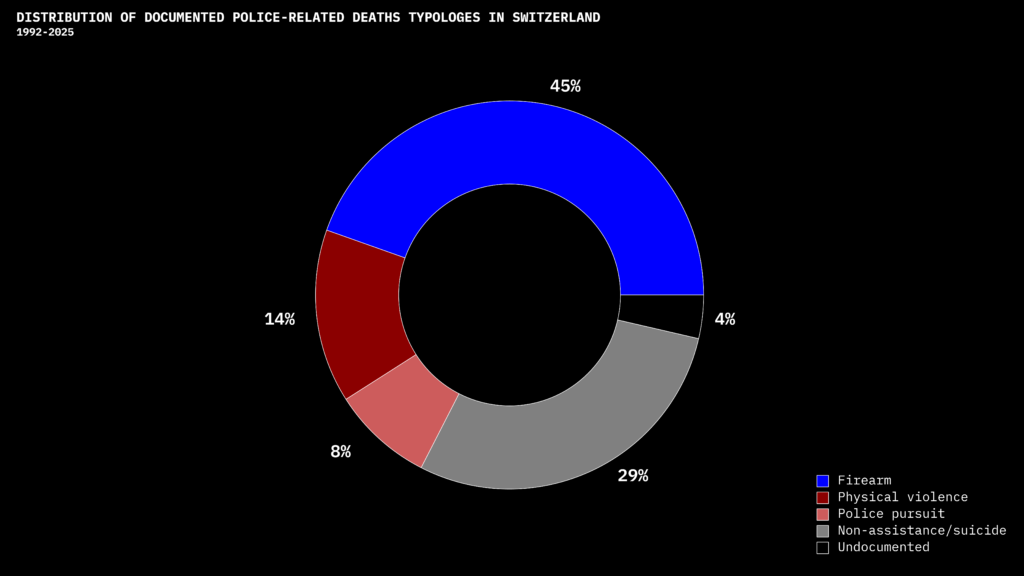
This distribution undercuts the sanitised narrative that fewer police shootings would imply less violence. From 1992 to 2025, police-related deaths remain steady at roughly two to three per year. Declines in firearm discharge have not produced fewer fatalities overall because a large share of deaths arise from non-firearm practices. Firearm use is therefore a poor proxy for lethality and reducing gunfire alone has not reduced the deadly effects of policing. In fact, fatalities are decorrelated from firearm use: the reported drop in shootings does not translate into fewer deaths, whether we consider police-related deaths as a whole or deaths by firearm specifically.
Police officers do not need a firearm to kill, and the decreasing use of their lethal arsenal has not reduced the lethality of their deadly policing practices. It is both the use of firearms by police officers and the everyday machinery of control, restraint and neglect that kill.
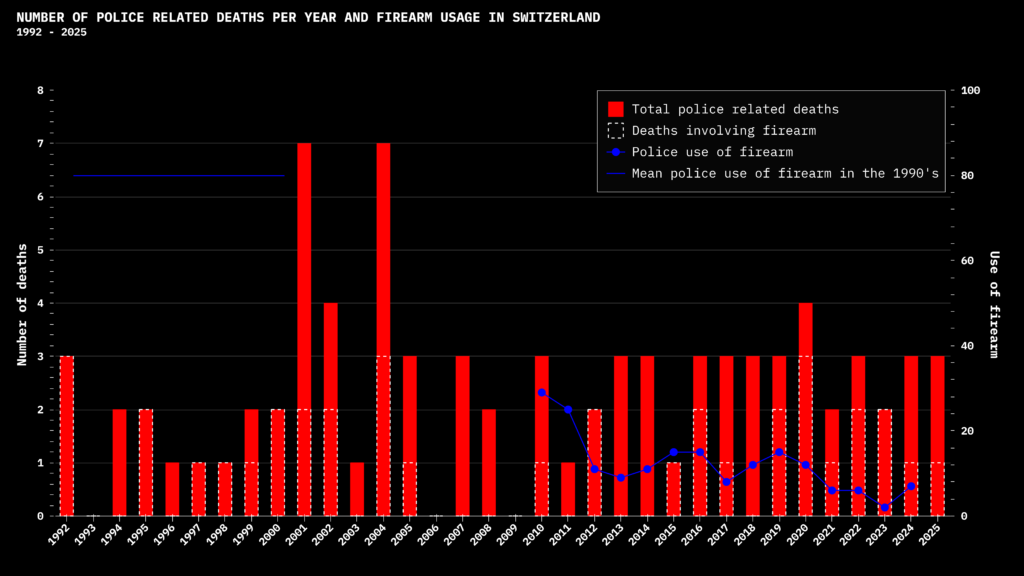
Looking beyond national aggregates, we examined the distribution of police-related deaths across Swiss cantons over the last three and a half decades (1992–2025) and, separately, the last decade (2015–2025). Across both windows, the results are unequivocal: the Canton of Vaud stands out as the deadliest cantons in Switzerland for police-related deaths – both in absolute counts and when standardised by population size and policing capacity (officer headcount and officers-per-inhabitant). Strikingly, a majority of documented deaths in Vaud concern racialised victims, revealing a racialised geography of state violence concentrated in this canton. As throughout, these findings rely on documented and known cases; given the opacity of official statistics, the true scale and distribution may differ. Within what can be known, however, Vaud consistently ranks as the most lethal canton overall, particularly for racialised people.
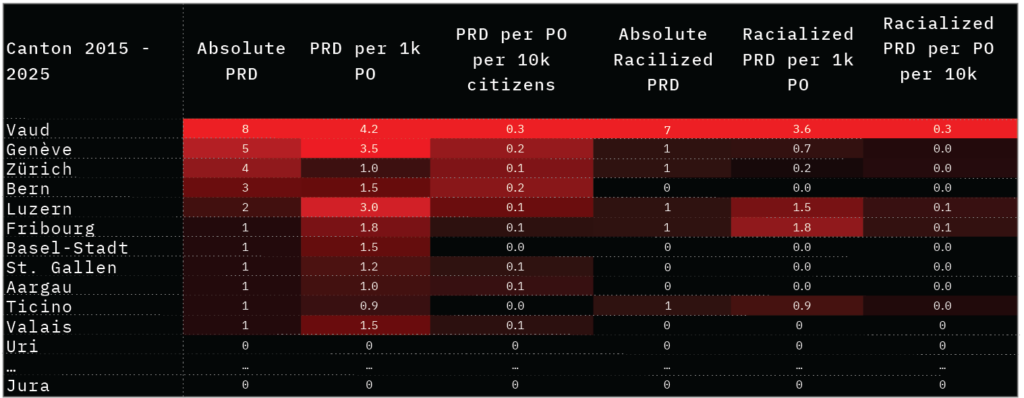
Producing the other as a killable subject
While compiling detailed data on the events is crucial to understanding the scope and patterns of police-related deaths across space and time, we also aim to understand who dies at the hands of police. To do so, we systematically document how state actors engage in processes of othering that ultimately shape the dynamics of state violence.
Othering is understood here as relational and hierarchical processes by which certain individuals or groups are perceived and constructed as fundamentally different, deviant or inferior from a presumed normative centre – often white, part of the national majority, male, heterosexual and neurotypical – while at the same time casting racialised masculinities as exceptional threats.189Mugglin et al., Racisme Structurel En Suisse : Un État Des Lieux de La Recherche et de Ses Résultats, 11. While the notion of exclusion based on difference has long existed in various cultural and political contexts, postcolonial studies notably theorises othering in the context of colonial dominance, showing how the colonised subject was constructed as irrational, dangerous or backwards to justify imperial control.190Edward W. Said, Orientalism (Vintage books, 1979); Gayatri Chakravorty Spivak, “The Rani of Sirmur: An Essay in Reading the Archives,” History and Theory 24, no. 3 (1985): 247, https://doi.org/10.2307/2505169. Since then, the concept has been widely applied to analyse how modern institutions reproduce exclusion by establishing dominant norms and codifying them through legal, medical, linguistic or bureaucratic systems.
In the context of our analysis of cases of police-related deaths, we identified processes of othering in relation to racialisation, socio-legal status, psychopathology and drug use. These othering categories emerge from a combination of empirical observations and critical social theory. They reflect both recurring patterns in documented cases of police violence and well-established frameworks in sociology, critical race studies and medical anthropology.191Plümecke et al., “Effects of Racial Profiling,” 2023; Tebeje Molla, “Racial Othering: Structural Roots and Anti-Racist Actions from Below,” SN Social Sciences 4, no. 1 (2024): 7, https://link.springer.com/10.1007/s43545-023-00806-4. Importantly, our categories are not derived from how individuals self-identified but from how they are seen, constructed and treated by the state and its agents.
In order to identify the othering process individuals were subjected to, we developed a framework that both involves objective indicators that were related to the unfolding of events, and contextual indicators that are both systemic and situational factors. Observable indicators can include language used by police, media and state institutions (e.g. descriptions in press releases, or racial slurs during the interventions), racial profiling based on appearance (e.g. perceived skin colour or religious attire) or treatment associated with perceived deviance (e.g. brutality used on someone in psychological crisis). Contextual indicators derive from broader knowledge of structural dynamics: for instance, when someone belongs to a group statistically over-policed in Switzerland, we draw from critical literature and public reports to inform our coding.192Wa Baile et al., Racial Profiling und antirassistischer Widerstand Eine Einleitung; UN Working Group of Experts on People of African Descent, Visit to Switzerland; Dos Santos Pinto et al., Un/Doing Race; Plümecke et al., “Effects of Racial Profiling,” 2023; Luca Gnaedinger, “Le Paradoxe Suisse : Entre Mansuétude Pénale et Criminalisation de l’immigration,” Champ Pénal 32 (2024), https://doi.org/10.4000/12dgq.
The classification of police-related crime cases followed a three-step process. First, we examined the unfolding of events through a detailed review of available materials, such as media reports, court decisions and official statements. Second, we assessed the contextual elements by situating each case within broader structural dynamics, informed by scholarly research and institutional data. Third, we considered how the families and supportive collectives depicted the case, paying particular attention to the narratives and demands they articulated. This final step provided insight into how experiences of othering were named, resisted and re-signified by those most closely affected.
At the core of the framework of this data gathering is the concept of racialisation, defined as the socio-political process by which groups or individuals are assigned a racial identity that carries with it a host of assumptions, stereotypes and exclusions.
We also understand the process of othering through socio-legal status, which emphasises how the legal dimension of categorisation – such as asylum status, citizenship or residency permit – shapes how individuals are perceived and treated by police. These legal distinctions are often racialised and moralised, marking individuals as more or less “deserving” of protection, rights or suspicion.
Individuals with psychopathologies are often treated as unpredictable or dangerous, which can lead to heightened and sometimes violent police responses. This form of othering is shaped by societal stigma and typically results in the use of force rather than care. Similarly, drug users are frequently perceived by police forces as irrational, deviant or untrustworthy. In our framework, we treat drug use as a sub-category of psychopathology, as it draws on similar logics of pathology, deviance and moral failure to justify coercive or punitive policing.
By deconstructing these processes, our approach aligns with critical frameworks which argue that the state’s classifications are inherently political acts. They are not neutral descriptors but instruments that underpin patterns of discrimination, including the excessive use of police force against those perceived as others. When categories of othering processes overlap for some individuals, intersectionality becomes critical in the analysis. Intersectionality describes how multiple axes of oppression – such as race, gender, legal status and mental health – interact intersectionally to produce compounded vulnerability.193Kimberle Crenshaw, “Mapping the Margins: Intersectionality, Identity Politics, and Violence against Women of Color,” Stanford Law Review 43, no. 6 (1991): 1241–99, https://doi.org/10.2307/1229039. The case of Nzoy shows exactly these overlapping forms of othering: he was both perceived as a Black man and psychologically unstable. He was simultaneously othered racially and psychopathologically, increasing the risk of police violence and institutional neglect.
In addition to intersectional othering, other features can enhance the risk of facing lethal policing. In our framework, “othering” refers to processes through which the state marks certain subjects as intrinsically deviant. By contrast, under Western androcentrism and hegemonic masculinity, “male” typically operates as an unmarked norm rather than as a marker of deviance in itself. Yet masculinity as a dominant feature is not evenly distributed. Drawing on Norman Ajari, we understand that Black men are not positioned within normative masculinity but are produced by state racism as “emasculinity” – a condition that makes them prime targets of surveillance, policing, and punishment. In colonial and postcolonial imaginaries, race and gender are fused to cast the Black man as a priori threatening.194Norman Ajari, ‘Emasculinity. The Uninhabitable Gender of Black Men’. The Body’s Legacies Pt.2: The Postcolonial Body, Kunstenfestivaldesarts. 2019. https://www.academia.edu/39211833/Emasculinity_The_uninhabitable_gender_of_black_men. This figure is read through stereotypes of bestial strength and limited vulnerability, which empirical studies show can dehumanize, superhumanize (extraordinary strength, reduced sensitivity to pain), and lower the threshold for lethal force in police encounters.
A key objective of our database is to shed light on – not to reproduce – the state’s gaze. Whereas state institutions tend to employ categories that naturalise differences (e.g. labelling someone solely as “an asylum seeker” or “non-white”), our analytical framework is designed to critically interrogate these classifications. Our database does not adopt the state’s language uncritically; instead, it documents the state categorisations and then deconstructs them to reveal the underlying processes of othering. For example, one death categorised by the state as involving “a Nigerian male resisting arrest” is recoded in our framework by considering racialisation (was the person treated as suspicious due to his Blackness?), socio-legal status (was he undocumented or in an asylum process, and targeted for this reason?) and psychopathologisation (was drug use or mental health assumed without diagnosis?). This distinction is crucial because it allows us to map not only the instances of state discrimination but also the subtle, often implicit mechanisms through which state actors construct identities that serve to exclude or subordinate certain groups.
In the Swiss context, where official racial categories are absent, incorporating a detailed othering classification into our database provides a new empirical foundation for analysing how state violence is shaped by racialisation and implicit markers of difference. This approach complements existing studies, reports, and testimonies discussed in the previous section. It also allows us to make visible and quantifiable the reality that these sources have previously described. By analysing these processes critically and contextually, we aim not only to document deaths, but to challenge the epistemic and institutional structures that make racism invisible and inconceivable to the majority and ultimately sustain state violence.
The data we have gathered since 1992 reveals that 67% of the documented deaths bear at least one axis of othering, and almost a third of cases display more than one. The data thus confirms that police-related deaths in Switzerland are not distributed randomly but are structured by systemic hierarchies of difference.
Over 45% of those killed were explicitly or implicitly racialised, marked in police or media narratives through skin colour, accent, perceived origin or other “raceless” signifiers. Around 19% were in acute psychological distress or identified as mentally ill at the time of their death, with several killed after families called emergency services seeking help rather than enforcement. An even larger proportion – 30% – were undocumented, asylum seekers or held precarious legal status, often dying in the course of identity checks or border enforcement.
The intersections are even more revealing. Nearly a third of all cases – 28% – combined more than one othering axis. The pairing of racialisation and socio-legal precarity emerges as a repeated pattern, especially in border cantons. The overlap of racialisation and psychological distress, as in the killing of Nzoy, appears a particularly lethal combination, producing subjects read as simultaneously deviant, threatening and irrational.
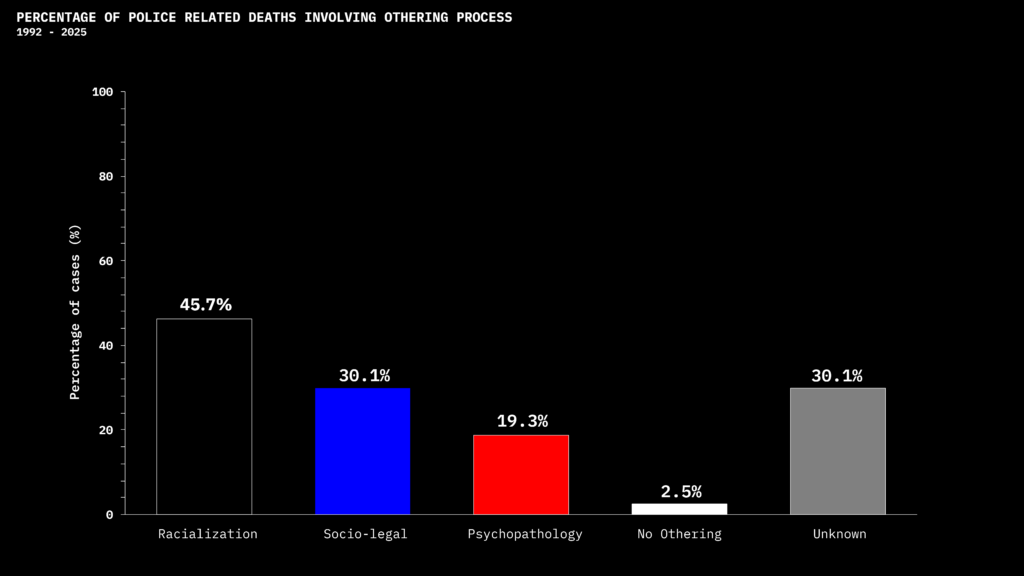
While this database makes visible how the state’s lethal practices follow lines of othering, these lines are not gender-neutral: they are historically gendered and, in the Swiss context, have produced a specific reading of the racialised man as threat.
In our 83 documented police-related deaths, gender is recorded for 74 cases. Of these, 66 are men (≈79%) and 8 are women (≈10%); gender is currently undocumented in 9 cases. This distribution aligns with the broader pattern our database reveals: police lethality in Switzerland is not random but structured around gender. Gender also structures the deaths of racialised individuals: racialised men are far more targeted by police brutality.
Read together, these findings indicate that racialised and othered masculinity functions as a risk amplifier: when racialisation is read through masculinised stereotypes and combined with other axes of othering (e.g., psychopathology), the perception of danger intensifies and the threshold for coercion drops.
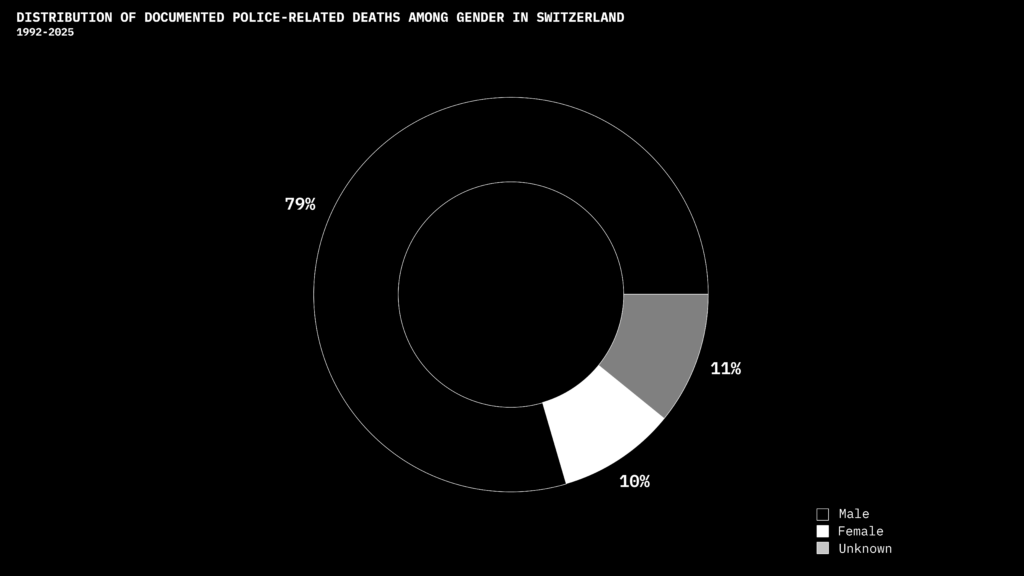
Beyond that, Nzoy was killed in the Canton of Vaud – the canton in which racialised victims constitute the majority of documented police-related deaths. These percentages lay bare the structural nature of police violence and the way it is shaped by processes of othering. They show that those who die at the hands of the Swiss police are overwhelmingly those already pushed to the margins of legal, racial and social recognition. Each percentage point represents not just a death but a logic: a system that renders some lives secured and others killable, and then erases the pattern under the guise of neutrality and statistical absence.
Counter-statistics as means of restoring dignity, truth and justice
In Switzerland, the state’s refusal to systematically track or share comprehensive data on police-related deaths perpetuates a regime of ignorance and impunity. Our database and mapping platform are an attempt to contest that regime. By compiling police-related deaths since 1992, we have aimed to produce reliable and transparent data as a foundation for fact-based analysis of patterns of police-related deaths, recognition and accountability.
Against the hegemony of denial, activist groups have long undertaken the painstaking work of documenting police-related deaths, piecing together fragmented sources: press articles, family testimonies, court files and police reports. Our database has built on this tireless work. Yet this work of resistance through data collection comes at a cost. Families are forced into a two-fold struggle: mourning their loved ones while simultaneously defending their humanity within legal and media forums that structurally discredit them. Counter-statistics respond to this injustice by shifting the evidentiary burden from individual families to a collectively built record. The aim is not to speak over the victims’ close ones but to ensure that they no longer have to carry the burden of proof and visibilisation alone.
What invisibilisation does to dignity, memory and justice is straightforward and devastating. When deaths are not counted, they are not remembered; when they are not remembered, they cannot be grieved publicly; when they cannot be grieved publicly, they struggle to enter law and policy as wrongs that must be remedied. Statistical absence entails that physical death is accompanied by symbolic and epistemic annihilation. It further erases the individuality of the victims and breaks the evidentiary links between a life, police practices, suffering and death, and replaces it with only a residue of insinuation – “malaise”, “unknown”, “suicide in custody”. In this erasure, dignity is diminished because the person’s death is rendered invisible and meaningless, memory is privatised and precarious, and justice is foreclosed by a lack of officially recognised harm. Furthermore, individual cases, when isolated, can be dismissed as anomalies; and the structural nature of police violence and its disproportionate impact on racialised communities is obscured.
Visibilisation through counter-statistics seeks to counter these mechanisms. The practice of collecting cases of police-related deaths into a database seeks to contribute to restoring dignity: the deceased is named in a public record, their death is acknowledged as consequential. This is also an act of recognition of the nature of the harm done. To register a death and precisely name the othering mechanisms that produced it, means that these mechanisms can be scrutinised publicly.
Finally, through our database, we respond to the invisibilisation of the structural causes of death by demonstrating that police-related deaths form a pattern. The aggregation of a list of incidents into a pattern constitutes a counter-mapping of power, which reveals the political geography of unwanted bodies and exposes the structural conditions leading to harm that official statistics erase. By making repeated practices visible, the analysis of patterns turns what the state frames as exceptions into evidence of a system.195Magda Boutros, “Antiracism without Races: How Activists Produce Knowledge about Race and Policing in France,” Social Problems 71, no. 1 (2024): 14, https://doi.org/10.1093/socpro/spac011. Finally, by turning scattered grief into a pattern of violence, we lay a stronger factual foundation on which claims to truth, justice and dignity can stand in relation to individual cases, as well as structural violence.
There are limits to what counter-statistics can do, and naming them is part of counter-knowledge production. Media visibility is uneven; fear of reprisal suppresses testimony; official euphemism obscures mechanisms; courts may seal files; some communities’ words have limited reach or are considered less credible than others. These are not flaws of the method but traces of the very power it confronts. Where our data is silent – unable to provide names or stories of personhood – the silence is itself evidence of the conditions that produce ignorance. Where it is partial, the partiality points to places where access must be fought for and protections strengthened. Counter-statistics convert these constraints from individual burdens into public claims.
Counter-statistics will not, on their own, undo the violence they register or prevent its repetition in the future. Rather, they act to restore dignity by ensuring that each death is recorded with causes and context rather than absorbed into euphemism. They reveal the mechanisms that perpetuate harm and open space for justice. They remind us that every struggle against state violence is also a struggle over what can be known, remembered and believed.
Did racism kill Nzoy?
Returning to our guiding question – to what extent was the killing of Nzoy shaped by racism and processes of othering? – our analysis offers insightful answers. We have proceeded through three operations that desingularise the case and embed it in its structural setting: a historical account of Switzerland’s racial formation, an institutional reading of policing and denial, and a statistical demonstration of patterned policing lethality in relation to processes of othering.
Through our first and second historical and institutional operations, we have shown that racism in Switzerland is not episodic but structuring, and that policing practices embody it through routine racialisation and psychopathologisation, emphasising escalation of repression and violence over care and refusing to address racism when accounting for harmful practices.
Third, the statistical operation – based on the Archive of Absence – demonstrates that police-related deaths track these lines: across 83 documented cases (1992–2025) 67% involve at least one axis of othering and 28% involve more than one; over 45% include explicit or implicit racialisation, 30% involve precarious socio-legal status and almost 20% concern psychopathology or drug use. These patterns are not random; they reflect hierarchies of difference reproduced through policing. The overwhelming predominance of male victims – at least 79% – in our database is not a reflection of a generic male norm but of a racialised masculinisation of threat. Gender here operates as a risk amplifier: when articulated with racialisation, socio-legal precarity, psychopathology, or drug use, it intensifies exposure to violence and increases the likelihood of lethal outcomes.
Disaggregating police-related deaths by canton reveals the Canton of Vaud as the deadliest Swiss canton over the last decade – both in absolute numbers and when normalised by policing capacity and population – with a documented over-representation of victims who were racialised. This spatial concentration clarifies why particular people, in particular places, are more exposed to lethal outcomes.
These three analytical operations allow us to shed a different light on the killing of Nzoy on 30 August 2021 in the Canton of Vaud. Nzoy was othered as a “man of colour” and perceived through a psychopathological lens. Our statistical analysis shows that this intersection of othering, compounded by geographical location and masculinity, is exactly where the risk of police lethality is greatest. In Chapter 1 we analysed the miscasting of Nzoy as a threat, the prioritisation of control over care and the disregard for his life – all of which point to processes of othering and differential treatment. In this chapter our statistical analysis has shown that the process that lies between othering and death at the hands of police is not incidental but a pattern. On this basis, we conclude that it is highly probable that Nzoy’s killing was shaped by racism, masculinity and processes of othering.
This chapter has demonstrated that male othered individuals are structurally overexposed to police violence and death and – specifically for racialised subjects – that this overexposure is rooted in Switzerland’s colonial entanglements and structural racism, but also perpetuated by structural conditions that we address in Chapter 4.
CHAPTER 4. STRUCTURAL IMPUNITY AND THE PERPETUATION OF VIOLENCE
In this chapter, we address the structural conditions leading to the denial of truth and justice for victims of police-related deaths and allowing for the perpetuation of this violence over time. While the previous chapter has demonstrated that police-related deaths are a pervasive phenomena in Switzerland across different cantons, analysing the variegated institutional and legal landscape and responses to these deaths across Switzerland as a whole is beyond the scope of this investigation. We have thus focused specifically on the Canton of Vaud. In addition to feasibility, our focus on the Canton of Vaud is justified on two grounds: first, because it was the canton in which Nzoy was killed, and second, because our statistical analysis has demonstrated that this canton counts the highest number of police-related killings over the last ten years in Switzerland, with an overrepresentation of Black victims: Hervé Bondembe Mandundu (Bex, 2016), Lamin Fatty (Lausanne, 2017), Mike Ben Peter (Lausanne, 2018), Roger Nzoy Wilhelm (Morges, 2021), Qader B. (Essert-sous-Champvent, 2024), Michael Kenechukwu Ekemezie (Lausanne, 2025), Camila Oliveira Belchior (Lausanne, 2025).
We begin by analysing the structural entanglement between the police and the public prosecutor’s office in criminal investigation in the Canton of Vaud, highlighting the lack of independence in cases of police-related deaths, which has contributed to a lack of accountability. We then turn to political debates around policing and the functioning of the public prosecutor’s office in cases of police-related deaths in the Canton of Vaud, pointing to the political inertia in addressing those structural issues. We further analyse the barriers to justice experienced by families and the perpetuation of violence experienced through the legal process.
Our analysis demonstrates that the legal institutions of the Canton of Vaud charged with determining responsibilities in cases of police-related violence are far from offering an adequate response to the demands for accountability. The legal process comes at a tremendous cost for the families of victims, while the officers implicated in police-related deaths are very rarely condemned for their (in)actions. Furthermore, racism itself is not addressed in these legal processes and remains unchallenged. Structural impunity thus operates across a continuum, from perpetrator to structural process, which in turn enables the perpetuation of police violence onto future victims.
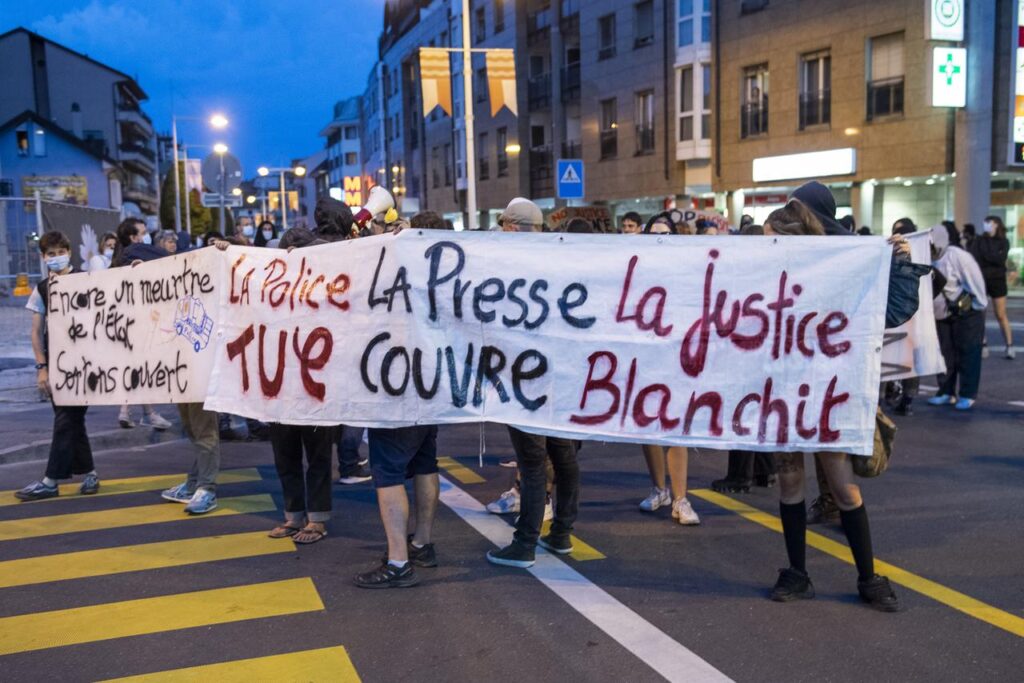
Public prosecutor and police structural entanglement
The right to an effective and impartial investigation is a cornerstone of democracy. It guarantees accountability, equality before the law and the prevention of arbitrariness. The European Court of Human Rights has articulated five criteria for an effective investigation: independence, relevance, diligence, public verifiability character and victim involvement in the proceedings.196Jörg Künzli and Vijitha Veerakatty, La Protection Juridique Contre Les Abus de La Part de La Police. Présentation Des Mécanismes de Plainte Possibles En Suisse (Centre suisse de compétence pour les droits humains (CSDH), 2014), 11, https://skmr.ch/assets/publications/150324_Etude_CSDH_Police_plainte.pdf. More specifically, according to international law standards, it is essential that an investigation be conducted by institutions or individuals independent of those under scrutiny, requiring in particular both the absence of hierarchical or institutional ties and genuine practical autonomy.197Bouyid v. Belgium, 28 Sept. 2015, App. 23380/09, §118; Guide on Article 3 ECHR, §128. Research has shown that those rights and principles are often undermined or made ineffective in cases of police-related deaths.198Open Society Justice Initiative et al., Who Polices the Police? : The Role of Independent Agencies in Criminal Investigations of State Agents (Open Society Foundations, 2021), 95 pages, PDF, 95 pages, https://doi.org/10.34880/74M3-9S14. The Canton of Vaud offers a clear illustration of this trend.
In the Canton of Vaud, no institution is habilitated to conduct an investigation independently from the police or the judiciary on cases of violence, violations or deaths that involve on-duty police officers. When such cases occur, the criminal investigation is jointly conducted by the public prosecutor’s office and the police. In 2020, the Public Prosecutor’s Office of the Canton of Vaud and the police created the Special Police Investigations Unit, known as DISPO. According to its founding directive, it was “established to handle criminal investigations relating to police activity, as well as other areas where the use of coercive measures by public authorities is predominant, notably in the penitentiary system”.199Ministère Public and Police cantonale vaudoise, “Organisation et Fonctionnement Du Détachement d’investigations Spéciales Policières (DISPO),” June 3, 2020, https://oav.ch/wp-content/uploads/2020/06/dpj_28.pdf, ch. 3. The DISPO is composed of prosecutors from the central public prosecutor’s office and officers from the three branches of the cantonal police – security police, gendarmerie and general services – who possess “solid professional experience (at least fifteen years, in principle) and are recognised for their professional qualities and service record”.200Ministère Public and Police cantonale vaudoise, “Organisation et Fonctionnement Du Détachement d’investigations Spéciales Policières (DISPO)”, ch. 3.
While the establishment of this special unit is presented as a response to the “expectations of a society that is ever more sensitive to the ways in which police officers act”,201Ministère Public and Police cantonale vaudoise, “Organisation et Fonctionnement Du Détachement d’investigations Spéciales Policières (DISPO)”, ch. 1. the DISPO actually institutionalises the structural entanglement between the public prosecutor and the police and strengthens a system where criminal investigations against police officers are conducted by other police officers working in the same canton. In this sense, the principle of independence and impartiality in a criminal investigation are clearly undermined.
This structural entanglement of the police and the public prosecutor has materialised in cases of police-related deaths over the last ten years. While detailed information on legal proceedings is difficult to access, the available data on Nzoy’s case and six other police-related deaths in the Canton of Vaud over the past ten years indicate a troubling pattern. To date, with the exception of the Lamin Fatty case, and although police officers implicated in other cases have taken medical leave or left the police, there has been no documented suspension of police officers or additional measures implemented to prevent collusion, despite existing legal provisions to mitigate this risk.202By contrast, racialised defendants accused of minor drug offenses are frequently subjected to lengthy pre-trial detention on the basis of presumed flight or collusion risk, and face severe penalties. The asymmetry is stark and points to an institutional and – in this case – racialised double standard embedded in prosecutorial practice In this context, the fact that police investigators detached from the DISPO remain administratively dependent on their original unit and branch and that the commander of the Vaud Cantonal Police may request access to the case file as any other party,203Ministère Public and Police cantonale vaudoise, “Organisation et Fonctionnement Du Détachement d’investigations Spéciales Policières (DISPO)”, ch. 3, ch. 7. means there is a high risk of collusion between police officers under investigation, as well as with the investigators, their hierarchy and the public prosecutor in charge of coordinating the criminal investigation. The functioning of the DISPO thereby evidently impedes the independence and impartiality of the criminal investigation and constructs the structural conditions that risk furthering impunity.
These structural conditions have led to important limitations in demands for accountability in cases of police-related deaths over the last ten years. We will analyse in detail later in this chapter the legal process for the Nzoy case, which offers a striking example of the constant barriers to accountability and decisions in which the public prosecutor appears to side with the police against plaintives. Our analysis of other cases of police-related deaths indicates that these barriers to truth and justice are not exceptional and operate at different levels in the Canton of Vaud. Ultimately, all documented cases over the last ten years remain – to date – under prolonged criminal investigations punctuated by several obstacles faced by the families, such as the denial of their rights to be recognised as plaintiffs, or are pending in Swiss or international courts after families have challenged verdicts that had ruled against them. As a result of these repeated barriers to accountability, justice appears elusive and forever deferred for victims’ families.
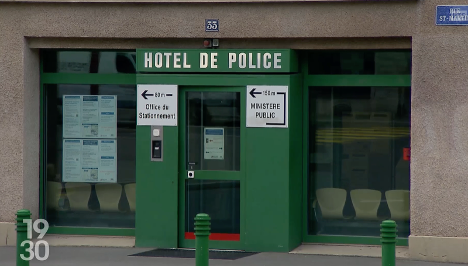
Legislative condemnations and executive inertia
The problems outlined above are well known in the Canton of Vaud. Over the past twenty years, the cantonal parliament as well as multiple municipal legislative bodies have repeatedly debated questions related to police violence and racism as well as the independence of the public prosecutor’s office and the police. Those debates have mainly crystallised around the issue of independence in the conduct of criminal investigation against police officers, with a specific focus more recently on the DISPO and its opacity related to the absence of publicly available statistics or activity reports compared to other branches of the judiciary and the police.204Grand Conseil vaudois, “Interpellation Mathilde Marendaz et consorts – Décès lors d’interventions policières et leurs enquêtes : besoin de statistiques et d’explications | État de Vaud,” July 29, 2024, https://www.vd.ch/gc/depute-e-s/detail-objet/objet/24_INT_86/membre/624913; Grand Conseil vaudois, “25_INT_88 – Interpellation Sylvie Podio et consorts au nom de Joëlle Minacci, Alexandre Démétriades, Blaise Vionnet – Des chiffres sur l’activité et les résultats du Détachement d’investigation spéciales policières (Développement). | État de Vaud,” June 24, 2025, https://www.vd.ch/gc/seances-du-grand-conseil/point-seance/point/063463d5-bec4-494c-9c7f-686eceef9da7/meeting/1026894; Grand Conseil vaudois, “25_INT_90 – Interpellation Joëlle Minacci et consorts au nom d’Alexandre Démétriadès, Sylvie Podio, Blaise Vionnet – Un retour sur le Détachement d’investigations spéciales policières (DISPO) du DIVAS (Développement). | État de Vaud,” June 24, 2025, https://www.vd.ch/gc/seances-du-grand-conseil/point-seance/point/3cbebeed-7b4d-4ceb-b64d-563caea25fd0/meeting/1026894. Despite being crucial political issues that attract the attention of the public and the media, the aftermath of those debates have been marked by inertia and a perpetuation of status quo.
To date, every proposition for creating an independent complaints body designed to investigate reports and complaints made against police officers has been rejected in the Canton of Vaud. These rejections were largely done on the grounds that the necessary tools and complaints mechanisms already exist for people who consider themselves victims of disproportionate actions by the police. While the canton does have different institutions of administrative mediation, ethics, as well as racism preventions, members of parliament as well as civil society actors have repeatedly pointed out that the decentralised nature and the lack of uniformity and communication between those entities can clearly impede the effective support for victims of police violence. Associations have further pointed out that these entities do not present any competence in supporting victims of disproportionate use of force by the police, they are rather constructed as “mediation bodies”, which does not imply impartiality in the procedure or a capacity to gather complaints and investigate cases.
Attentive to the various legal outcomes following the death of Mike Ben Peter, a civil society organisation called “Kiboko collective” sent a letter to the member of the cantonal council of state in charge at the time, expressing its demands, including the request for an independent complaint body. In her response in 2021, the State Councillor used the same argument, asserting that the justice system is sufficiently equipped to assess cases involving police officers in an objective and independent manner. A year later, in response to an interpellation by a member of parliament following the death of Nzoy, the new State Councillor in charge reproduced the same argument and wording.205“21_REP_177 – Réponse du Conseil d’Etat au Grand Conseil à l’interpellation Hadrien Buclin et consorts – Des questions se posent après le drame de la gare de Morges (21_INT_111). | État de Vaud,” April 5, 2022, https://www.vd.ch/gc/seances-du-grand-conseil/point-seance/point/5b55bfaf-f7ff-4e76-b95f-f139873507c4/meeting/1004434. This shows the reluctance of political authorities to engage in a careful assessment of the situation and a relevant debate on these issues, preventing processes that might challenge the institutional status quo and the limits to the impartiality and independence of the judiciary. Furthermore, in the response to the 2022 interpellation, the State Council also claimed that “in 2020, 14 criminal complaints were filed against officers of the Vaud Cantonal Police, 11 of which were related to the use of force” and that “this trend has remained stable for several years”, concluding that “current practice tends to show that criminal complaints for police violence are proportionally few compared to the number of interventions”.206“21_REP_177 –- Réponse du Conseil d’Etat au Grand Conseil à l’interpellation Hadrien Buclin et consorts – Des questions se posent après le drame de la gare de Morges (21_INT_111). | État de Vaud.” Combined with a lack of willingness to challenge police practices and broad political support for the police forces, arguments around those questions have allowed political authorities and their police forces to disregard these proposals and thus ignore the broader issues related to the disproportionate targeting of othered people or the structural entanglement of the public prosecutor and the police that we address throughout this report.
In Switzerland the police enjoy a particularly high level of public trust,207Office fédéral de la statistique, “Confiance élevée envers les institutions en Suisse, selon le statut migratoire,” July 16, 2024, https://www.bfs.admin.ch/asset/fr/32070487. and they also benefit from the support of executive branches and parts of the legislative branches which are usually reluctant to consider criticism of police-related activities. This support is also manifested in the use of parliamentary tools to respond to criticism and demonstrate this support, in turn providing the police with greater power. In Geneva, an initiative that was partially adopted, titled “Yes, I protect the police which protects me”, attempted to protect police officers from criminal prosecution in the course of their duties.208Grand Conseil de la République et canton de Genève, “Initiative Populaire Cantonale « OUI, Je Protège La Police Qui Me Protège ! »,” 2025, https://ge.ch/grandconseil/data/texte/IN00194.pdf. In Lausanne, the draft regulation “Better Protecting Police Officers”, which issues an automatic 500-Swiss-Francs fine for anyone obstructing a police intervention, was approved.209Conseil communal Lausanne, “Projet de Règlement : Mieux Protéger Les Policières et Les Policiers,” June 4, 2018, https://www.lausanne.ch/apps/agir/affaire/doc/62/62f8b749353b4904b548f02d8c00a405.pdf. Interestingly, such initiatives are usually proposed in the context of debates on police misconduct, independent complaints bodies or in the periods following mediatised police-related deaths.
Combined with the structural issues related to the conduct of criminal investigations on police-related deaths, this political inertia creates structural conditions that impedes police accountability, further impunity and perpetuates forms of violence for the victims and their families.
Barriers to justice for families and the perpetuation of violence in the legal process
As indicated above, the issues raised by the structural entanglement between the public prosecutor’s office and the police are not limited to questions of legal formality or institutional design. They have concrete implications for demands for justice in specific incidents and directly affect the families of those harmed or killed by police. In the timeline below, we summarise the legal proceedings in the Nzoy case, reconstructing the sinuous and contested path of the demands for accountability and the responses from various legal authorities. In the following sections of this chapter we discuss particular barriers to accountability, collusions between actors involved and forms of violence that persist in and through the legal process. Where relevant information is available, we situate the issues observed in the Nzoy case in relation to other cases of police-related deaths in the Canton of Vaud over the past ten years, thereby revealing patterns of legal practices that contribute to the denial of accountability. While most of these cases remain under criminal investigation or are pending before Swiss and international courts, they exhibit similitudes that raise serious questions about a regime of impunity – one that hinders justice and places undue pressure and violence upon victims and their families.

Family, plaintiffs and the denial of recognition
Being recognised as plaintiffs in a criminal procedure is critical for the families of victims. This status grants access to the case, allows the family to participate in the procedure and to seek legal help and potential compensation. At the same time, it carries significant symbolic weight by acknowledging that the person is directly impacted by the events and opens the door to seeking justice through the legal system.
During the week following Nzoy’s death, Nzoy’s father was questioned by police investigators and recognised as a plaintiff by the public prosecutor. In parallel, the lawyer of Nzoy’s sister and brother informed the public prosecutor that they wished to join the criminal proceedings as plaintiffs too. In response, the public prosecutor requested they provide proof of their relationship to Nzoy as well as evidence that could support the “closeness and intensity of the bonds” they had with him before his death. This meant that Nzoy’s sister was compelled to share screenshots of messages she exchanged with her brother, call logs, as well as photos of letters addressed to him that she received at her home when they lived together. Despite this disclosure of intimate information, the public prosecutor refused to recognise them as plaintiffs on the grounds that it did not demonstrate a significant relationship between them at the moment of his death. This denial extends beyond the legal process and strikes at the core of personal relationships, calling into question their nature. While Nzoy’s siblings successfully appealed this decision and were eventually recognised as plaintiffs, they were not permitted to receive any information about the procedure or to access data collected in the investigation for several months. This gravely impeded their ability to understand what happened to their brother – forcing them to rely on information disseminated in the media – but also clearly impacted the legal process. Most police hearings have indeed been conducted without the family’s legal representation present, further impeding their ability to monitor the proceedings and preventing them from exercising their right to be present on equal footing with the defendant’s lawyer. Though the participation of victims and/or their relatives in the proceedings is paramount to adequately taking into account their interest in the procedure and upholding their right to be heard and to seek justice, Nzoy’s family were denied this right for several months.
Partial expertise
In legal proceedings it is common for the criminal prosecution to use experts when the public prosecutor or the court “do not have the specialist knowledge and skills required to determine or assess the facts of the case”.210Code de procédure pénale suisse. https://www.fedlex.admin.ch/eli/cc/2010/267/fr, art. 182. While it is the legal authority that appoints the experts, this act often sparks disputes between the parties, who may either support or contest certain experts notably based on their potential partiality and connections to the case or individuals involved. In the legal proceedings on the death of Nzoy, the prosecutor appointed a police captain of the training cell of the cantonal gendarmerie to draft a report analysing the “professional actions” of the four police officers. This seven-page report refers to elements of the police investigation and reflects on the unfolding of events in light of police training. It concludes that Nzoy attacked a police officer and that all four police officers acted in conformity with police principles and training. A police hearing was also conducted with this police captain to present his conclusions.
As this report does not critically assess components of the case file – notably reiterating the erroneous conclusions of the criminal investigation and failing to notice errors, inconsistencies and missing elements – the relevance of this report, as well as the independence and partiality of its author, was put into question by Nzoy’s family lawyer who requested it to be withdrawn from the case file. The public prosecutor rejected this request, asserting that it is common practice to rely on police experts, and outright dismissed concerns about the partiality and lack of independence when a police expert evaluates the actions of colleagues involved in a death. The Criminal Appeals Court, however, disagreed and stated that this report “cannot be given greater value than that of an internal opinion, lacking the guarantees of independence and impartiality required for a true judicial expert opinion”.211Arrêt Du 14 Mai 2025, PE21.015154-LML.
Disputes of impartiality and independence of expertise are also found in other cases, such as in the context of forensic medical expertise in the case of Mike Ben Peter. The family lawyer’s request for the recusal of two experts on the grounds of their personal and professional ties with police officers was refused by the appeals court, which argued that it would be difficult to find experts with no ties to police officers given the nature of their work and the organisation of their institution.212Chloé Din, “Contre-expertise demandée dans l’affaire Mike Ben Peter,” 24 heures, February 10, 2021, https://www.24heures.ch/contre-expertise-demandee-dans-laffaire-mike-ben-peter-911435078431.
This situation reflects the broader closeness between various branches of the police, the public prosecutor’s office and other such institutions as the Unit of Forensic Medicine in the Canton of Vaud. In the criminal investigation into the death of Nzoy, this proximity is particularly evident in one police hearing, where the familiarity between PO2 and the officers questioning her surfaced through her demand to use the French informal “you” – tu – instead of the formal you – vous.213“Je préfère que l’on se tutoie.” Case file, 2008, p. 2. This continues to raise concerns about the impartiality and independence of the legal proceedings and the related expert assessments. For families, this dynamic can reinforce a sense of injustice and powerlessness when facing a system that protects and reproduces itself.
Abandoning the proceedings despite doubts
While public prosecutors are required by law to investigate incriminating and exculpating circumstances with equal care, legal doctrine also provides the principle of in dubio pro duriore, which stipulates that in case of doubt regarding the factual or legal situation, it is not for the investigating or prosecuting authority to decide, but for the judge with proper jurisdiction to rule on the proceedings.214Code de procédure pénale suisse, art. 6, al. 2; Arrêt Du 14 Mai 2025, PE21.015154-LML.a In practice, however, the principle is often circumvented when police officers are implicated. In the case of Nzoy as well as the case of Lamin Fatty, the public prosecutors in charge have attempted to abandon the proceedings – and thus exonerate the police officers involved – despite the fact that major uncertainties and contradictions remained in the case files. In both instances, these decisions were successfully appealed and overturned at the Criminal Appeals Court by Lamin Fatty’s family in 2024 and by Nzoy’s family in 2025.215RTS, “Le Parquet vaudois doit rouvrir l’enquête sur la mort d’un requérant d’asile en cellule,” rts.ch, June 19, 2024, https://www.rts.ch/info/regions/vaud/2024/article/le-parquet-vaudois-doit-rouvrir-l-enquete-sur-la-mort-d-un-requerant-d-asile-en-cellule-28543870.html; Arrêt Du 14 Mai 2025, PE21.015154-LML. The fact that families, already confronted with grief and stigma, had to take on the additional burden of appealing prosecutorial decisions in order to keep their cases open illustrates the imbalance of power they face and the structural hurdles to accessing justice.
These attempts to prematurely close investigations reveal deeper structural problems. They raise critical questions about the effectiveness and impartiality of criminal investigations when police officers are the accused, and expose the reluctance of the public prosecutor’s office to investigate incriminating and exculpating circumstances with equal care when police officers are involved.
Negative portrayal and victim–perpetrator reversals
A recurrent feature of police-related death cases in the Canton of Vaud is the process through which victims are negatively portrayed or criminalised while the violence inflicted upon them is minimised. This twofold process creates a narrative reversal in which those who have been killed appear as responsible for their own deaths, and police officers as passive actors who merely reacted to an imminent threat. In practice, this takes the form of the repeated requalification of the victims’ behaviour and of the events themselves. Research has documented that acts of resistance, distress or self-defence are reframed as aggression or threats – especially when intersecting with mental illness, race and gender – while the disproportionate use of force by the police is recast as necessary, inevitable or protective.216Eddie Bruce-Jones, “German Policing at the Intersection: Race, Gender, Migrant Status and Mental Health,” Race & Class 56, no. 3 (2015): 36–49, https://doi.org/10.1177/0306396814556223. This rhetorical inversion not only erases the violence endured by victims but also contributes to consolidating a broader institutional narrative that shields police officers from accountability.
In Nzoy’s case, as shown throughout this report, he has been portrayed from the day of his killing as a threatening individual who attacked the police with a knife. A similar framing has been used to describe Hervé Bondembe Mandundu, also shot and killed in the Canton of Vaud during a crisis and portrayed after as a threatening figure. This portrayal serves to legitimise the fatal use of firearms against them. Similarly, Mike Ben Peter and Michael Kenechukwu Ekemezie, who both died following extremely violent police interventions in Lausanne on alleged drug-dealing grounds, were persistently portrayed as “drug dealers” – an image directly insinuated by the official narrative and bluntly reinforced by the media. This overshadowed the brutality of the intervention that led to his death. In the case of Camila Oliveira Belchior, who died after being pursued by a motorised police officer while riding a motorcycle without a helmet in Lausanne, the intervention was framed as a response to an “urban rodeo” and her alleged attempt to evade the police. This insinuated illegal and dangerous behaviour in order to divert attention away from the fact a police officer was chasing a 14-year-old teenager.217Corentin Chauvel and Laurent Antonoff, “Une adolescente de 14 ans décède après avoir fui un contrôle de police à Lausanne,” 24 heures, July 1, 2025, https://www.24heures.ch/lausanne-une-ado-de-14-ans-decede-apres-avoir-fui-un-controle-de-police-359474195165.
These portrayals shift the focus away from the police-related death and instead highlight the alleged faults or the perceived threat posed by the victims. This framing can produce a reversal of responsibility: rather than being recognised as victims of a lethal state violence, the deceased are rendered culpable – at least in part – for their own deaths. Such portrayals both legitimise the actions of police officers and further stigmatise the families, who are forced to watch their loved ones represented in legal proceedings in ways that feel unrecognisable.218Didier Fassin, “The Politics of the Aftermath: On the Sequels to Police Violence,” Social Research: An International Quarterly 91, no. 4 (2024): 1085–104, https://muse.jhu.edu/pub/1/article/948884. In these instances, it is the memory of a loved one that is violated, after the person themself has already been killed.
From the criminal investigation to the media: the amplification of misrepresentation
The violation of the memory of the deceased experienced by relatives through the legal process is often amplified by media coverage. Nzoy’s case once again illustrates this dynamic: from the day of his death, a simplistic and binary narrative has dominated most media accounts – portraying him as a dangerous and erratic individual who attempted to attack the police with a knife, and was justifiably taken down by a police officer who simply responded to an imminent threat. While Chapter 1 has demonstrated that this depiction is erroneous, an analysis of press articles covering Nzoy’s killing shows that police, news and media outlets have converged in offering an incomplete and “frozen frame” of the event,219‘Endangered/Endangering: Schematic Racism and White Paranoia’. In Reading Rodney King/Reading Urban Uprising. Routledge, 1993. depicting Nzoy as a threat.220Claske Dijkema, “Press Articles in German-Speaking and French-Speaking Swiss Press Covering the Death of Roger ‘Nzoy’ Wilhelm (2021-2023),” with Arianna Pratti and Flurin Wagner, June 27, 2025, https://zenodo.org/records/15755188.
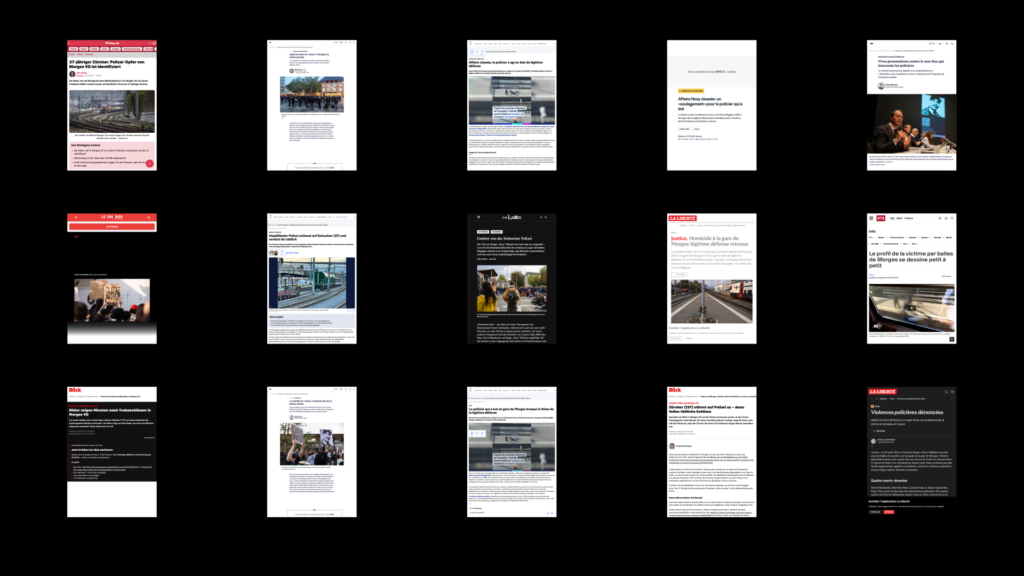
In the days following Nzoy’s death, the majority of the German-speaking press uncritically used the initial information put out by the police and some media sources to depict Nzoy as a dangerous and aggressive person. A particular emphasis was put on three elements, mentioned in almost every article, that are directly taken from the police press releases: First, the presence of the knife, with headlines even going as far as naming Nzoy the Messer-Droher (literally translating as the “knife threatener”). Second, the fact that Nzoy was dealing with mental health issues. And finally, the fact that he was “known to the Zurich police”. All these details were not contextualised, and no further information was given about his psychological distress or his alleged criminal record. The three details were accompanied by such words as Bedrohung (“threat” or “assault”), implying that Nzoy must have posed a danger and that PO4 was forced – gezwungen (“to force”, “to constrain”) – to shoot Nzoy due to the threat he represented.221Antoine Hürlimann, “Messer-Droher in Morges VD von Polizei erschossen,” Schweiz, Blick, August 31, 2021, https://www.blick.ch/schweiz/westschweiz/schon-vor-einem-jahr-gabs-am-bahnhof-in-morges-vd-toedliches-drama-messer-droher-in-morges-vd-von-polizei-erschossen-id16795070.html. Using less sensational titles, the Swiss French-speaking press framed their articles in similar ways using exactly the wording of the police press releases and the dominant narrative highlighted above.222RTS, “Le profil de la victime par balles de Morges se dessine petit à petit,” rts.ch, September 1, 2021, https://www.rts.ch/info/regions/vaud/12459700-le-profil-de-la-victime-par-balles-de-morges-se-dessine-petit-a-petit.html; RTS, “Rassemblement pour dénoncer un ‘crime policier’ après le drame de Morges,” rts.ch, September 3, 2021, https://www.rts.ch/info/regions/vaud/12465667-rassemblement-pour-denoncer-un-crime-policier-apres-le-drame-de-morges.html
This dominant narrative directly contributed to the construction of Nzoy as a danger and threat to the police, who are portrayed as mere responders reacting to an imminent danger, thereby legitimising their use of lethal force. Early media coverage largely ignored details about the officers’ actions and showed little interest in how their behaviour may have influenced the situation. Instead, the police officers themselves were presented as victims, stressing the heavy burden they carry due to accusations of homicide and racism.223Eigenmann, “Racisme, la Suisse en flagrant déni,” 107.
Furthermore, scarcely any articles published during the weeks following Nzoy’s death mention the fact that Nzoy was Black or raise questions about the role race could have played in the events. While Nzoy’s family and close ones put forward allegations of racism from a very early stage, the commander of the Morges police was given a platform by the media to deny any allegation of racism.224“‘La couleur de la peau n’a eu aucune influence’ dans le drame de Morges, selon la police.” While journalistic deontology emphasises the necessity to present arguments from both sides, research shows that in the context of police-related violence or death, the police perspective is generally prioritised over that of the victims or their families.225Magda Boutros, “The Epistemic Power of the Police,” Theoretical Criminology 28, no. 4 (2024): 495–515, https://doi.org/10.1177/13624806241263916. In this way, the structural absence of race and racism in media coverage reflects the racial denial present in Swiss society and institutions, as highlighted throughout this report.
Denial of race
The sections above have demonstrated the structural conditions that enable impunity and the legal and symbolic violence they inflict on families. Beyond the challenges of securing accountability for police-related deaths in Switzerland, the role of race and racism in these cases is systematically obscured in the legal proceedings. In Swiss law, racism is addressed through the restrictive article 261bis of the Swiss Criminal Code on “Discrimination and incitement to hatred”, which addresses overt expressions of racism and discrimination.226“Code pénal suisse,” https://www.fedlex.admin.ch/eli/cc/54/757_781_799/fr.
In its landmark judgment on Wa Baile v. Switzerland, the European Court of Human Rights concluded that Swiss courts had failed to examine the racial discrimination dimension of the police practice in question.227Wa Baile v. Switzerland (2024). https://hudoc.echr.coe.int/eng#{%22itemid%22:[%22002-14292%22]}. This judgment is especially significant in Switzerland, where, as we have seen throughout this report, the recurring features of police violence against racialised individuals cannot be understood as isolated incidents. However, the available information on criminal investigations and trials in cases of police-related deaths in the Canton of Vaud shows that this ruling – or the broader issues of racism in police actions – has systematically been disregarded, even when testimonies, contextual evidence or patterns clearly suggest its relevance. This reflects systemic and institutional dynamics that are rendered invisible by a legal framework unwilling or unable to account for racism as a structuring factor in violence perpetrated by the state and its agents.
As a result, such cases as those of Nzoy, Mike Ben Peter, Hervé Mandundu, Lamin Fatty and others are stripped of their racialised dimensions in criminal investigation and courts, even though they are essential to understanding both the police interventions and the denial of accountability afterwards. In this sense, the exclusion of racism from cases of police-related deaths in Switzerland appears to be more than a mere omission, but an active mechanism of denial, consistent with the structural racism at work across Swiss society and institutions. It allows state institutions to isolate each case, and avoid confronting systemic failures and structural racism. This further entrenches the very structures that make lethal police violence possible.
Conclusion
Despite the existence of procedural safeguards and a layered legal framework regulating criminal procedure in Switzerland, our analysis demonstrates that in the Canton of Vaud, investigations and prosecutions involving police officers are marked by a fundamental lack of independence and impartiality. The structural entanglement between the public prosecutor’s office with the police – materialised most starkly in the functioning of the DISPO – creates conditions where criminal investigations into police-related deaths are conducted by colleagues of those under scrutiny, under the authority of prosecutors who are themselves institutionally aligned with the police. As we have seen through the combined analysis of cases of police-related deaths in the canton, this undermines not only the effectiveness of investigations but also their credibility in the eyes of victims’ families and the public. Combined with a consistent political inertia that has blocked the creation of independent complaint mechanisms, the result is a structurally consolidated regime of impunity.
This impunity is reinforced by the systematic refusal of authorities to address race and racism as relevant dimensions of police violence. As our analysis of several cases has shown, prosecutorial practice and judicial reasoning consistently sideline questions of racism, even when testimony and contextual evidence clearly point to racialised dynamics. By isolating each case, the legal system obscures the systemic character of racialised police violence and legitimises state violence as exceptional, defensive and justified. The denial of racism thus operates not as a passive omission but as an active mechanism of institutional reproduction, one that maintains a framework in which police violence is rarely, if ever, sanctioned. In this sense, the law does not simply fail to deliver justice but actively contributes to a state-sanctioned system of racialised violence.
The price of this impunity is borne most directly by victims’ families. As we have shown, families are confronted with a two-fold violence: the original killing of their loved one, and the long, retraumatising legal processes that follow.228Rachida Brahim, La Race Tue Deux Fois: Une Histoire Des Crimes Racistes En France (1970-2000) (Syllepse, 2021), 137. Instead of providing recognition and truth, the legal process frequently denies them standing as plaintiffs, forces them to disclose intimate details of their family relations and subjects them to the violence of watching their loved ones misrepresented and criminalised in court and in the media. Expert reports are tainted by partiality, hearings are held without family representation and prosecutors attempt to prematurely abandon proceedings despite obvious contradictions and uncertainties. These barriers prevent families from accessing truth, prolong their suffering and suggest that their grief and their demands for justice do not matter. The cumulative effect is severe: families are forced into a dual struggle, mourning their loved ones while simultaneously having to defend their memory, their dignity and even their legitimacy to participate in the legal process. This reveals how deeply unequal the rights to justice and social recognition are in Switzerland: certain lives, particularly those of racialised individuals, are treated as less worthy, less grievable and less entitled to justice.
The case of Nzoy exemplifies these dynamics in a stark way. His killing was immediately framed as the neutralisation of a dangerous aggression, while his humanity was overshadowed by narratives of aggression and threat. His family faced procedural denials of recognition, delays in access to information and attempts by the prosecutor to abandon the case despite significant doubts. What should have been a process aimed at uncovering truth and establishing responsibility instead became a machinery of obfuscation, where the family’s suffering was compounded by institutional indifference and violence. Nzoy’s case therefore stands not only as a tragedy in itself but also as a window into the structural conditions that reproduce impunity for police violence in the Canton of Vaud. It illustrates how institutional design, prosecutorial practices, political inertia and racial denial interact to produce a continuum of violence that begins with lethal police intervention and extends through the legal, political and media apparatuses that follow.
The acknowledgement of the limits of the law and the violence of the legal process itself has spurred anti-racist movements to consider alternative justice-seeking practices both within and without the institutions of the law. While anti-racist groups often remain committed to seeking accountability in front of courts of law, the inability of legal institutions to respond to their demands has increasingly foregrounded alternative approaches to justice, which do not depend on the state and its legal bodies. Through practices rooted in collective memory, truth-telling and community-based responses to systemic violence, they seek to offer answers to demands for truth and justice here and now. Crucially, these alternative and abolitionist approaches acknowledge that confronting, repairing and ending violence require far more than punishing individuals. It requires moving focus towards the emotional needs of individuals and communities involved; to create spaces to hear and support those affected, helping people process harm, conflict and grief in the aim of restoring relationships and promoting healing without resorting to retribution. Simultaneously, these approaches seek to transform the institutional and structural foundations of racism, inequality and neglect so as to create safer environments for all.229Akkan, Başak, Julia Hahmann, Christine Hunner-Kreisel, and Melanie Kuhn, eds. Overlapping Inequalities in the Welfare State: Strengths and Challenges of Intersectionality Framework. Cham: Springer International Publishing, 2024; Brazzell, Melanie, ed. Was macht uns wirklich sicher? ein Toolkit zu intersektionaler, transformativer Gerechtigkeit jenseits von Gefängnis und Polizei. Münster: edition assemblage, 2018; Gilmore, Ruth Wilson. Abolition Geography: Essays towards Liberation. Edited by Brenna Bhandar and Alberto Toscano. London New York: Verso, 2022; Thompson, Vanessa E. ‘»There Is No Justice, There Is Just Us!«: Ansätze Zu Einer Postkolonial-Feministischen Kritik Der Polizei Am Beispiel von Racial Profiling’. In Kritik Der Polizei, edited by Daniel Loick, 197–223. Frankfurt ; New York: Campus Verlag, 2018; Loick, Daniel, and Vanessa Eileen Thompson, eds. Abolitionismus: ein Reader. Originalausgabe. suhrkamp taschenbuch wissenschaft 2364. Berlin: Suhrkamp Verlag, 2022. In this way, they seek to alleviate the harm that has been caused in the past and prevent it from recurring in the future.
CONCLUSION. JUSTICE FOR NZOY
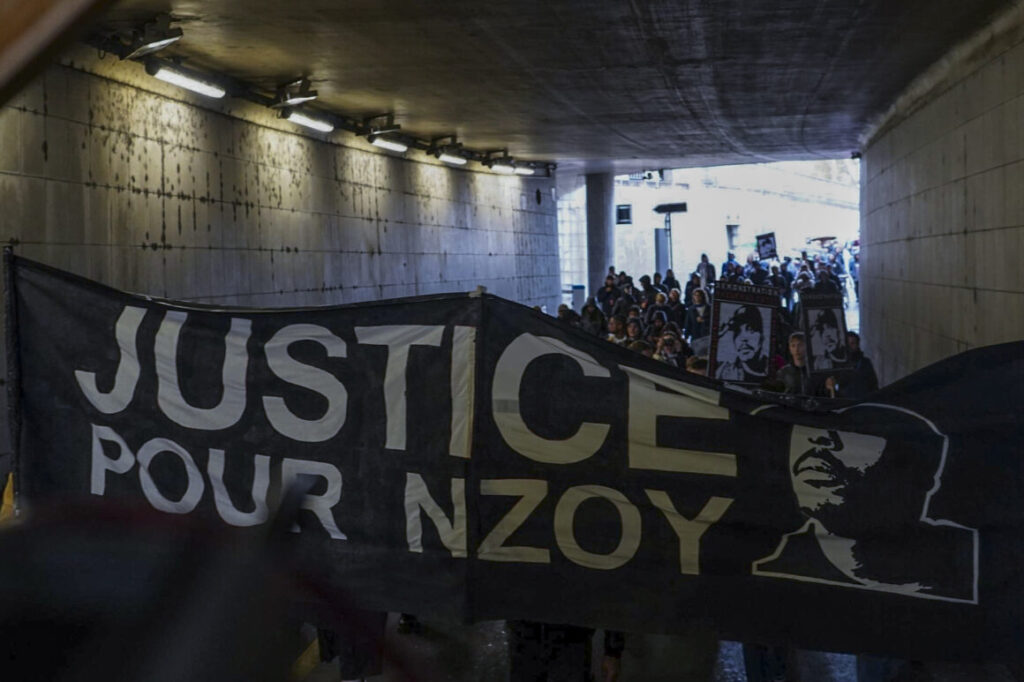
According to his close ones, Nzoy’s choice of name expressed his Black consciousness, his South African descent and his firm opposition to racism and the categories imposed by colonial rule and apartheid. Today, Nzoy is also the name of a lost brother, a lost son, a lost friend. His close ones mourn him and seek justice. But the long quest for justice is one that cannot be pursued alone. In the face of the power and violence of state institutions and their agents, building a diverse and extended community of struggle is necessary for resistance and care.
Since Nzoy’s death, people across Switzerland have tirelessly joined forces to honour his memory, and demand truth and justice. His name resonates alongside those of many others who died at the hands of police in Switzerland. It is chanted in protests, sung in songs, painted on walls and printed on clothes. As a symbol of the struggle against police killings and racism, Nzoy’s name has mobilised a wide community of people who continue to rally around a unifying call: Justice for Nzoy. This counter-investigation has strived to answer that call and its multiple meanings.
Justice for Nzoy means uncovering the truth about his death.
Four years after the killing of Nzoy, and following two failed attempts by the public prosecutor to close the case, the truth concerning the circumstances of Nzoy’s death has still not been established, and an inaccurate narrative has been constructed by the criminal investigation. Our reconstruction has led us to contest the narrative that Nzoy was a threat and his shooting was legitimate.
Through the precise reconstruction of the circumstances that led to Nzoy’s killing, our counter-investigation has fundamentally opposed the findings and narrative of the criminal investigation and finally brings truth about the unfolding of events. We have revealed that based on an inaccurate and biased perception of threat, the police officers wrongfully privileged the use of coercitive means and lethal force against Nzoy instead of assistance and care. Contrary to the findings and narrative of the criminal investigation, we have demonstrated that it was in fact the police intervention that led to the escalation of the situation, resulting in the shooting of a person in a state of psychological distress and the subsequent failure to provide him aid.
The role of race in Nzoy’s killing was denied by the police and disregarded in the criminal investigation. By situating our reconstruction of the killing of Nzoy in the context of structural racism, and in relation to numerous other cases of police-related deaths in Switzerland collected in a new database, our analysis has revealed a connection between processes of othering and overexposure to the risk of death at the hands of police. Through this process, our counter-investigation has revealed that the perception of Nzoy as a “man of colour” likely shaped the events that led to his death.
Border Forensics and the Independent Commission will continue to accompany Nzoy’s family in their quest for truth and recognition of the circumstances of Nzoy’s killing, and the structural conditions that led to it.
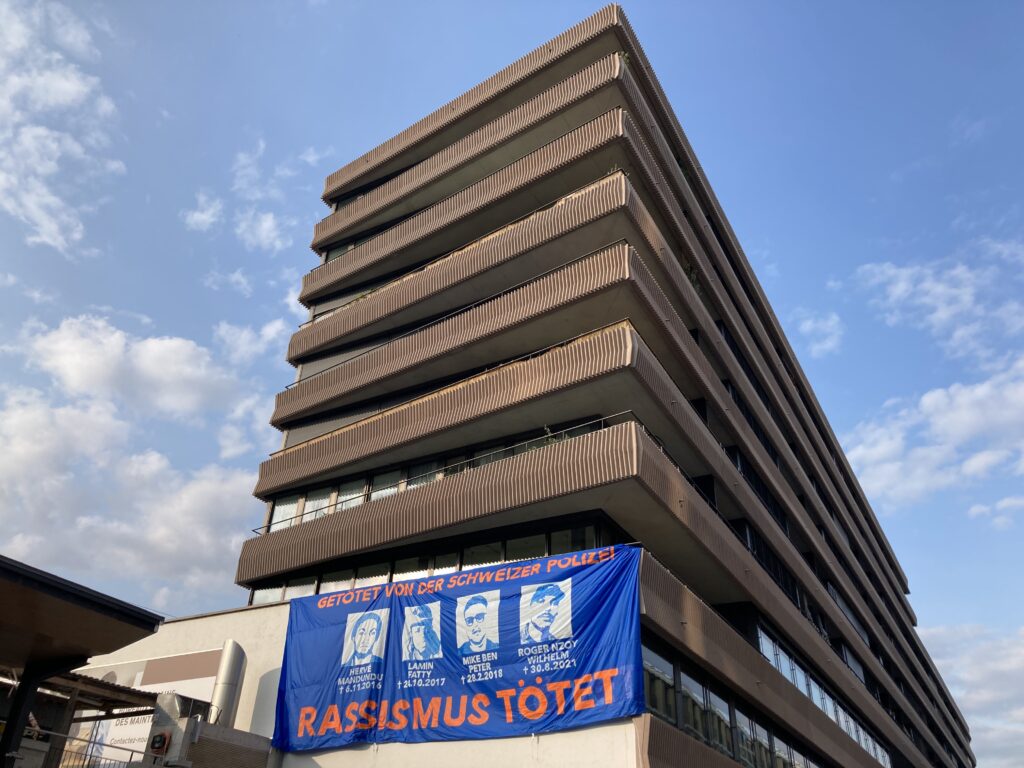
Justice for Nzoy means seeking accountability in legal forums.
This counter-investigation has highlighted the structural conditions – especially in the Canton of Vaud – that lead to protracted legal processes marked by multiple barriers to justice that obstruct accountability. Our examination of the criminal investigation conducted on the death of Nzoy has further revealed inaccuracies, omissions, altered or missing evidence, as well as collusion and denial of rights. Furthermore, the negative portrayal of Nzoy in the legal process and by the media constitutes a form of violence to Nzoy’s memory and his family. Thus, to date, the criminal investigation has not only failed to deliver truth and accountability but also perpetuated harm.
Despite their recognition of the limitations and high cost of the legal processes, Nzoy’s family and their support network recognise the importance of pursuing justice within Swiss legal institutions and international courts if necessary. Legal processes can help establish the facts of a violent event, expose the perpetrators responsible and sometimes contribute to institutional change. The demand for justice in court is not only about one case but about collective visibility and public pressure. The struggle for accountability in legal forums can also connect families of different victims – such as those of Mike Ben Peter or Mohamed Wa Baile – and help build coalitions of marginalised groups who share experiences of racialised policing as well as of the uphill battle for accountability. Border Forensics and the Independent Commission will continue to accompany Nzoy’s family in their quest for accountability.
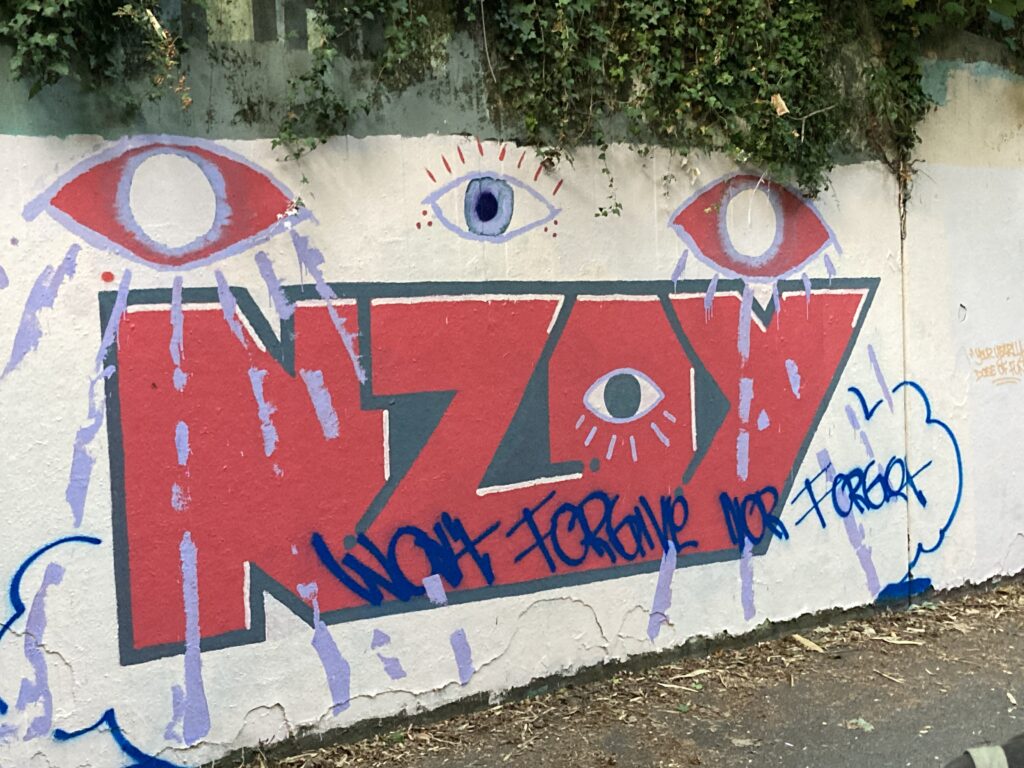
Justice for Nzoy means addressing structural racism.
While accountability for the killing of Nzoy may one day be secured in a court of law, it is likely to focus narrowly on the immediate perpetrators – the police officers who shot and failed to assist him. Our analysis, however, has revealed that the killing of Nzoy cannot just be seen as an individual tragedy. The specific circumstances of his death correspond to a clear pattern of relation between processes of othering – related to racialisation and psychopathology in the case of Nzoy – and overexposure to the risk of police-related death in Switzerland. While we conclude that race played a key role in the killing of Nzoy, racism itself is not addressed in the legal processes and remains unchallenged, as is usually the case in instances of police-related deaths.
The acknowledgement of the limits of the law in addressing structural racism has spurred anti-racist movements to consider alternative justice-seeking practices that do not depend on the state and its legal bodies. Practices rooted in collective memory, truth-telling and community-based responses to systemic violence seek to offer answers to demands for truth and justice here and now. Crucially, these alternative and abolitionist approaches acknowledge that confronting, repairing and ending violence require far more than punishing individuals. It requires transforming the institutional and structural foundations of racism, inequality and neglect so as to create safer environments for all. In this way, they seek to alleviate the harm that has been caused in the past and prevent it from recurring in the future. Nzoy died from causes that could have been prevented. Seeking to address structurally those causes and their roots is therefore also a form of justice for Nzoy and his family that the Independent Commission and Border Forensics are committed to pursuing.
Justice for Nzoy means restoring his memory.
A recurring feature of police-related death is the process through which victims are negatively portrayed or criminalised while the violence inflicted upon them is minimised in the criminal investigation and amplified by some media outlets. As we have shown in this report, this not only participates in erasing the violence endured by victims but also contributes to tarnishing their memory.
In addition to mourning their loss, Nzoy’s close ones have been forced to witness him represented in ways that are unrecognisable to them. Nzoy’s memory was violated after he had already been killed. Conducting a counter-investigation on the killing of a person also carries the risk of reproducing this violence: the reconstruction of Nzoy’s killing may lead to reducing him to his death rather than remembering the fullness of his life. Nzoy’s family have, however, entrusted us with uncovering the truth about his death as a first step towards healing – so that his life could finally be remembered, free from the false narratives constructed after he was killed.
In this sense, justice for Nzoy also means justice for his memory: a memory that will live beyond his death and that his family, and all those who stand with them, will continue to carry. In this spirit, it is with a letter by Nzoy’s sister that we wish to conclude this report.
“Dear Brother,
Lately I am often asked: Who were you?
And I would say: You were so many things! You could have been so much more! You could have been for much longer! I hesitate more and more to answer this question.
The ones who didn’t know you – or didn’t make the effort to get to know you – missed something.
Your death was so public, every one of your last breaths was public – and everything that still comes regarding your death is public. But who you really were… that stays with us.
The stories that bring you to life are too precious, too close; I don’t want to share them. Not publicly. Not with the world. I don’t want to give you away even more. Not another piece of you. But this much: you were a proud Black man. There are very few people who have such a big heart as you. You were a “people’s person”. You loved people. I admire you for that to this day – how did you manage, after all the racism you experienced throughout your life, to approach all people with open arms and heart? How could you not be resentful? Why didn’t you become bitter?
Empathetic people like you are rare. Very rare. If our mother was a man, she would be you! You were her, she was you, in so many ways. You were the copy of your mother. Her spirit, her aesthetics, her rhythm. That laughter! You both were the light in a room. You both had that charm, no one could resist. Especially you!
I miss your strong hugs. Yes, when you were still alive, I complained about them. “Not so strong,” I usually screamed. You just laughed. As if you had somehow known: one day they would no longer be that strong, only a whiff, a memory in the wind. I know, you are not dead. Only your body is. Your spirit, your soul, your being is constantly among us. You were a strong, handsome, tall man. Athletic, elegant. Good-looking. A person with his heart in the right place. A fighter for justice. A fighter against racism.
Miss you and love you,
Your sister.
PS: Nzoy should have lived. He would have, had he been white. We know that – and, in the end, everyone else should know it too.””

Investigation team
Research team
Border Forensics
Research director: Charles Heller
Lead researcher: Elio Panese
Geostatistical researcher: Stanislas Michel
Spatial researchers: Nico Alexandroff, Tomislav Levak
Data collection support : Stefanie Helfenstein
Copy-editing: Matilda Taylor
The Independent Commission of Inquiry on the Death of Roger Nzoy Wilhelm
Coordination: Louis Schild
Legal group: Maïna Aerni, Brigitte Lembwadio Kanyama, David Mühlemann, Carmela Schaller, Soraya Stock, Philip Stolkin
Social sciences group: Claske Dijkema, Tino Plümecke, Claudia Wilopo, Collectif Afro-Swiss
Medical group: Martin Herrmann, Udo Rauchfleisch
Translation: Florence Robins, Sandra Ryf
Interpretation: Karin Vogt
Visual and spatial analysis and production team
Border Forensics
Cartography and animations: Jack Isles
Geostatistical analysis: Stanislas Michel
Layout: Jelka Kretzschmar
Extended Team
Interactive platform development: Ebrahem Farooqui
Preliminary analysis video: Emile Costard
Acknowledgements
This investigation was made possible thanks to the contributions and support of many people. We would first like to express our deepest gratitude to Nzoy’s family and close ones for their trust, courage, and openness throughout this process. This report is dedicated to them, and we hope it will stand as a contribution to their ongoing quest for truth and justice for Nzoy.
We further want to thank the Swiss-based organisations who tirelessly organise and support the quest for truth and justice for the victims who died at the hands of police. A particular thanks goes to the Alliance Justice4Nzoy for their support to the family and their mobilisations, Ragekit for their important coverage of the case as well as Augenauf, Alliance against Racial Profiling and humanrights.ch for their documentation and analyses of cases of police-related deaths in Switzerland.
We also would like to thank Magda Boutros, Rohit Jain, Manon Jendly, Joel Vacheron, Matthieu Thomas, Vanessa Thompson and Javier Sanchis for their insightful reviews of the report and for sharing their expertise and experience with us.
Finally, we acknowledge the broader networks of activists, researchers, artists, and community members whose commitment and solidarity make it possible to resist erasure, to expose systemic violence, and to collectively imagine justice.
Funding
Border Forensics’ work on this investigation has been carried out largely on a pro bono basis. Given the difficulty of securing funds for an investigation into a police-related death in Switzerland, the Independent Commission and the Alliance Justice4Nzoy have taken on the essential task of launching crowdfunding initiatives to cover the costs linked to this work. Their efforts have been decisive in making this investigation possible. You can continue to support their activities here.